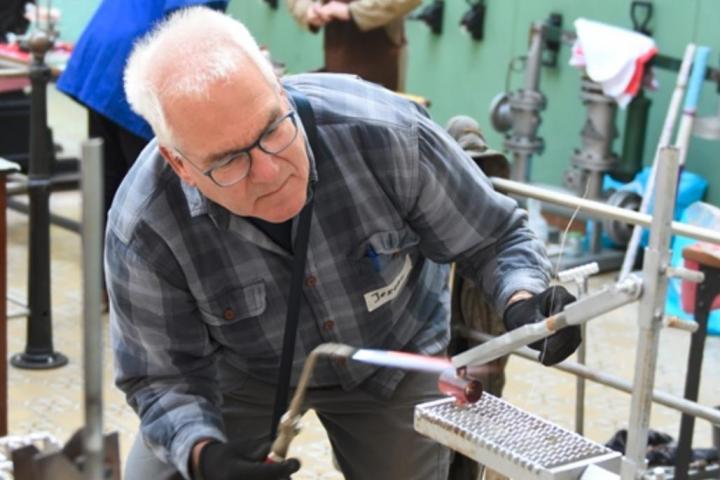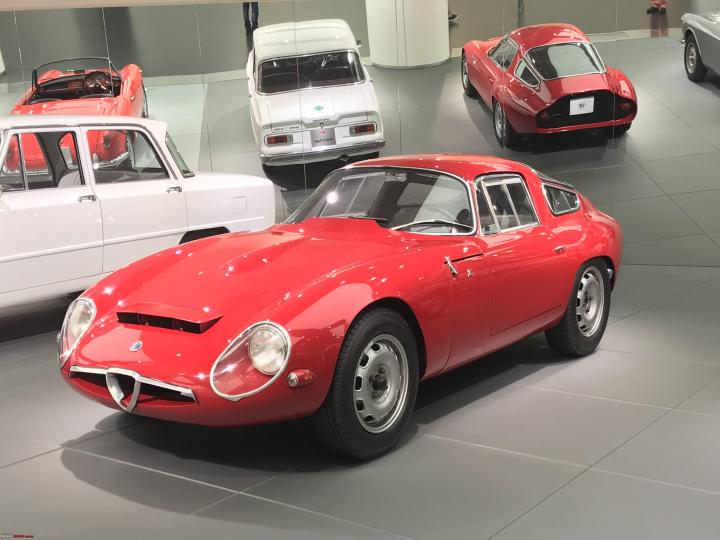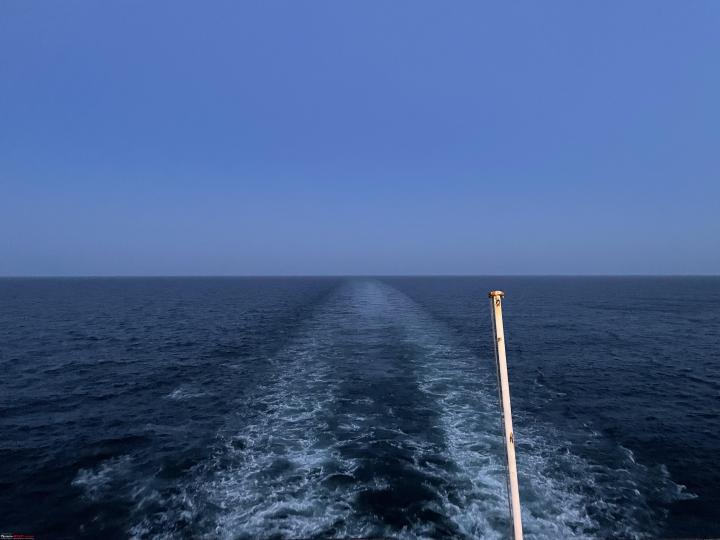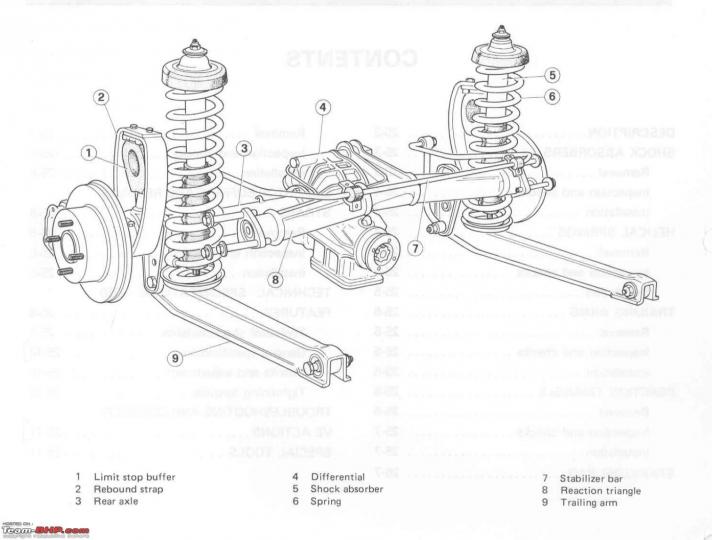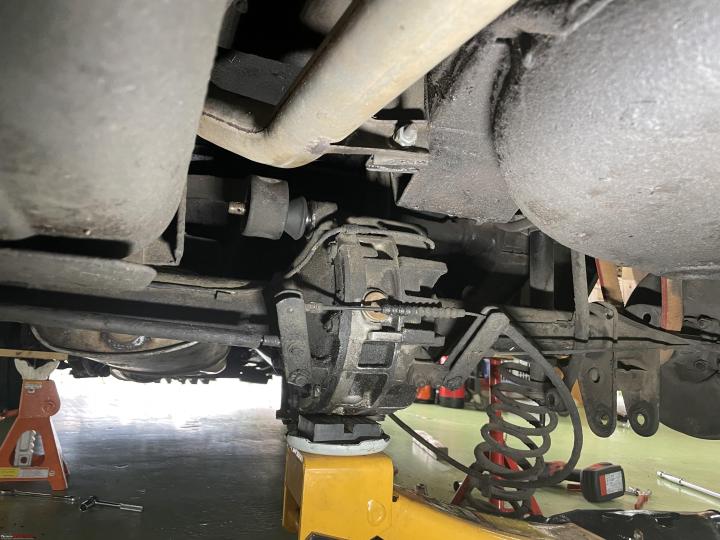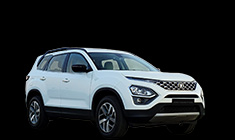News
Working on my Alfa Romeo: Removing rear shocks & driver door trim panel
These might well be original or at least have been on the Spider for longer than I have had the car, which means well in access of 30 years!
BHPian Jeroen recently shared this with other enthusiasts.
I decided to remove the aft shocks on my Spider and see if I could adjust them.
The aft shocks are a little bit more complex to remove than the front ones.
Here you see the top of the shock, inside the boot.
Obviously, the bottom part is attached to the trailing arm using a double nut.
To get better access I also removed this little black canister in the boot. It is part of the emission system. It's also fragile after all these years. Best to handle it very carefully.
Took the rubber top cap off, to get clearance to get at the two bolts holding it in place.
In order to be able to extract the shock, you need to peel back the trim inside the back of the cockpit as well to reveal this little panel, held in place with two screws.
Remove the screws and voila, you can pull out the shock from inside the cockpit!
Here you have it. Much to my surprise, it was not an adjustable Koni shock, but a plain Sachs gas shock. So I checked all my maintenance files. Sure enough, I did find the invoice for the two adjustable Koni's at the front. But I could not find anything about the rear shocks. So these might well be original, or at least have been on the Spider for longer than I have had it. Which means well in access of 30 years!
One of the two shocks did show some signs of wear, so I have decided to replace them.
I also decided to remove the driver door trim panel once again. You have seen me remove this panel many times. The window is rattling in the guidance rail and I wanted to see how I could fix it.
Getting the rail out was a bit of a fiddly job, as you can't really see what you are doing. All by feeling and cursing!
The belt/rubber guidance in the rail has come apart. I need to find myself some new stuff.
The first thing Monday morning is to call my friendly Alfa Spider specialist and parts supplier Goos. I am pretty sure he has the shocks, not so sure about the rubber felt window guide. I also need to book an appointment with Goos for the Spider annual APK (MOT).
Check out BHPian comments for more insights and information.
News
Installing new Bilstein shock absorbers on my 1986 Alfa Romeo Spider
It is not that difficult to mount these new shocks but the thing is, you need to depress them fully before inserting them in.
BHPian Jeroen recently shared this with other enthusiasts.
Very wet, rainy and windy weather here. Perfect day for playing in my garage. I spend most of the morning working on my Scuderi Model Engine. Almost all parts are finished and I am now working on fine-tuning everything.
Around noon a big box arrived!

New shocks and a new rubber for the window guide!

Developed on the Nurburgring, can you imagine what that will do for the performance of the Spider!


I decided to do one small job first. The front of the Spider has a very special Alfa emblem, set in black with a nice piece of metal trim around it. When I bought the Spider some 30 years ago, that metal trim was missing. One of the first jobs I did, was to make my own. You can't get this piece of trim anymore. So I went to a model-hobby shop and bought some aluminium tubing. Next I bent it in the exact shape and glued it in place. After thirty years it had become loose.
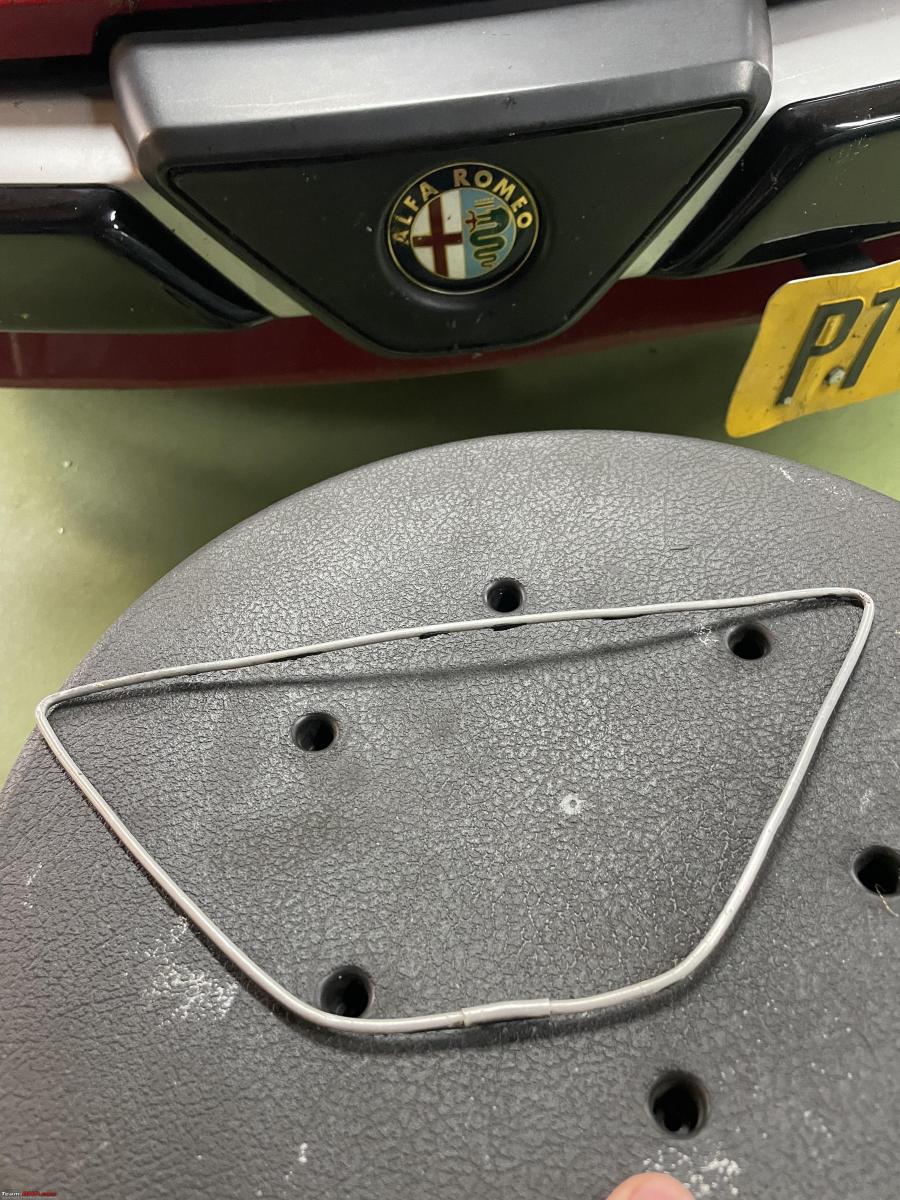
First thing is to clean everything very very thoroughly. And bent it back into shape.


All fixed looks great once again. I hope it holds for yet another thirty years!
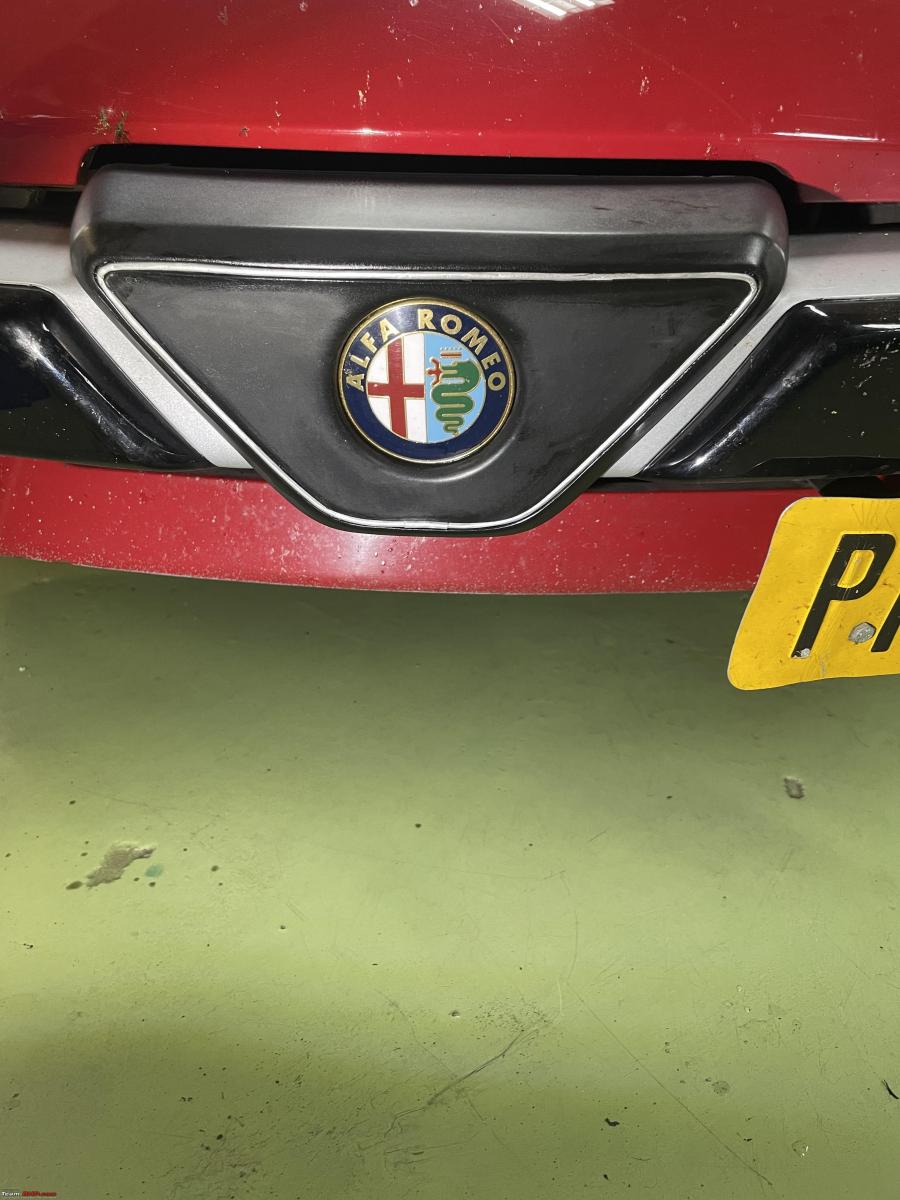
Next, I went to work on the window guide rail. In order to mount the new seal I wanted to clean it first. But a good inspection showed it needed a bit more than just cleaning. I spent about an hour and a half with various pneumatic tools and wire brushes, cleaning this small part. Lots of work.

With these wire brushed in the pneumatic tools it is safety first!
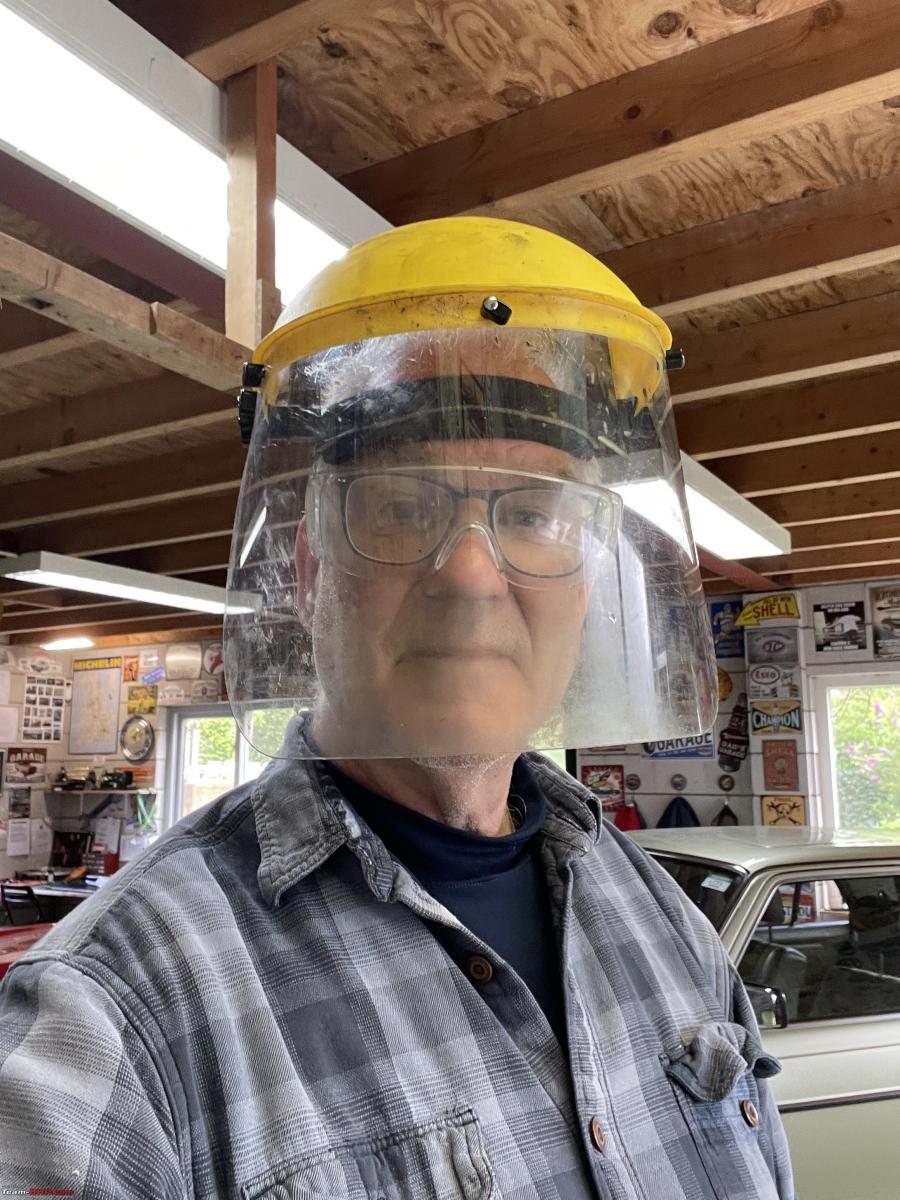
There is a saying in the classic car restoration work: The difference between good restorers and swindlers is the difference in the amount of time they spend on parts you will never ever see!
After I had cleaned the guide rail I degreased it. Also drilled out some rivets that held the seal in place. Next, I put three layers of my special super Black Spray paint on.
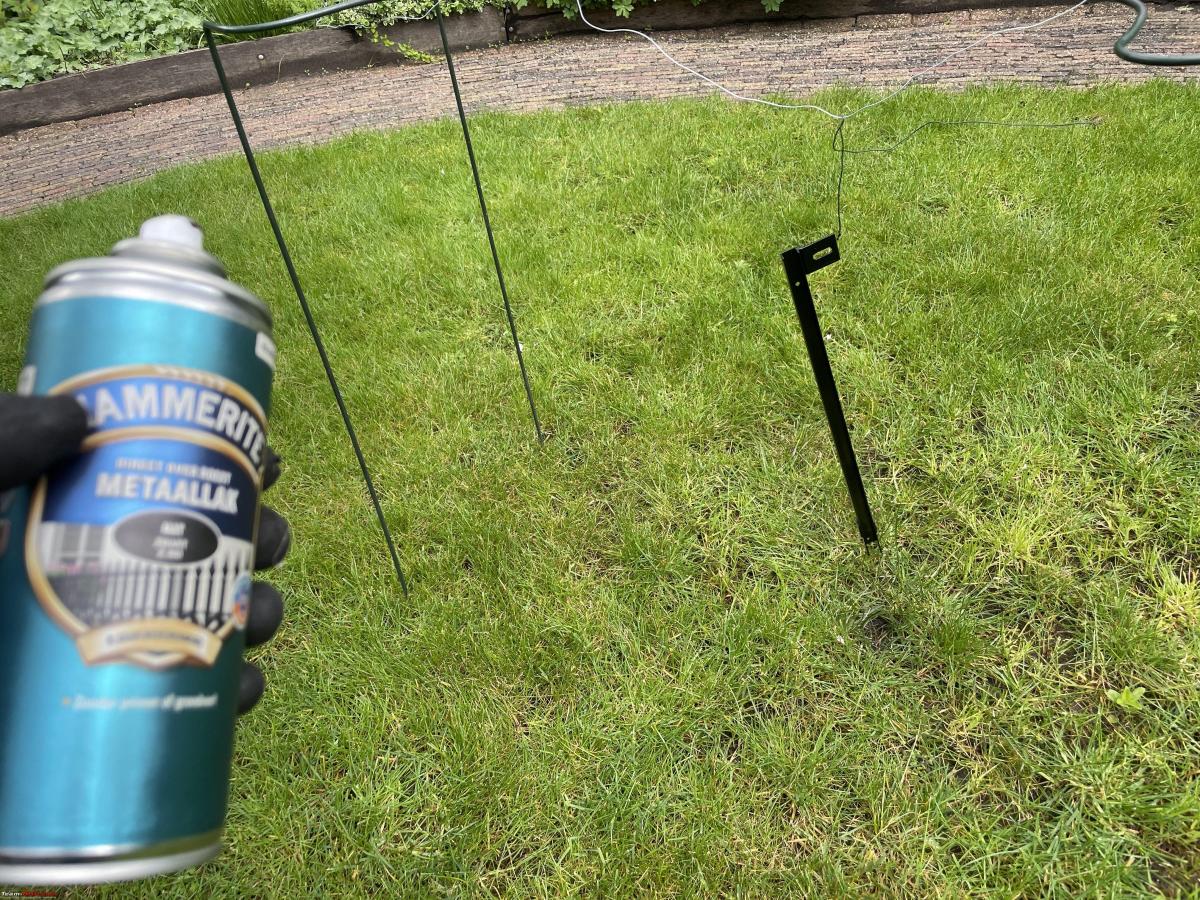
Now for the shocks!
My usual comparison of old and new parts. Checking that they will fit, same dimension, checking the various new bushes, rings, nuts etc.
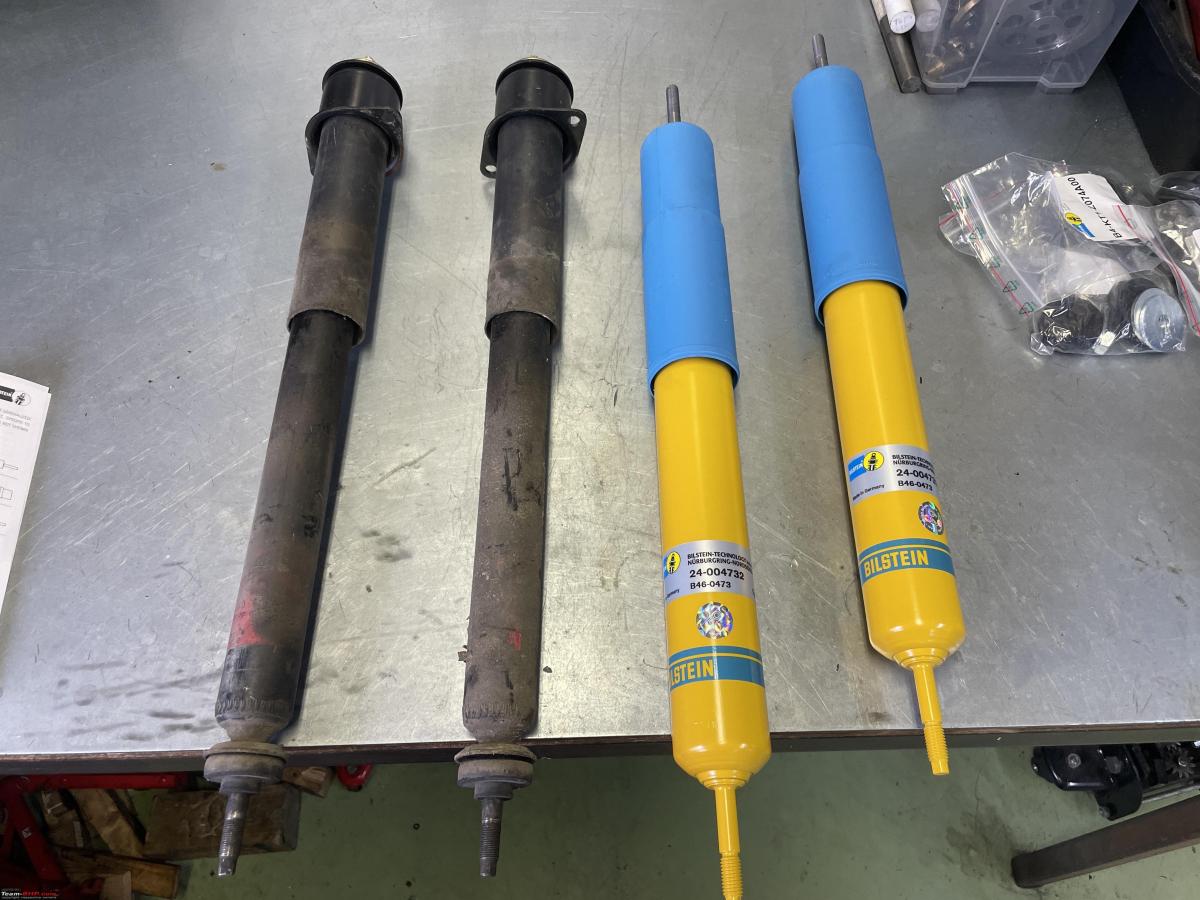
I took the mounting flanges of the old ones and put them on the new shocks.

Everything looked fine, so I decided to fit them right away.
These shocks come with detailed instructions, including how to torque them.
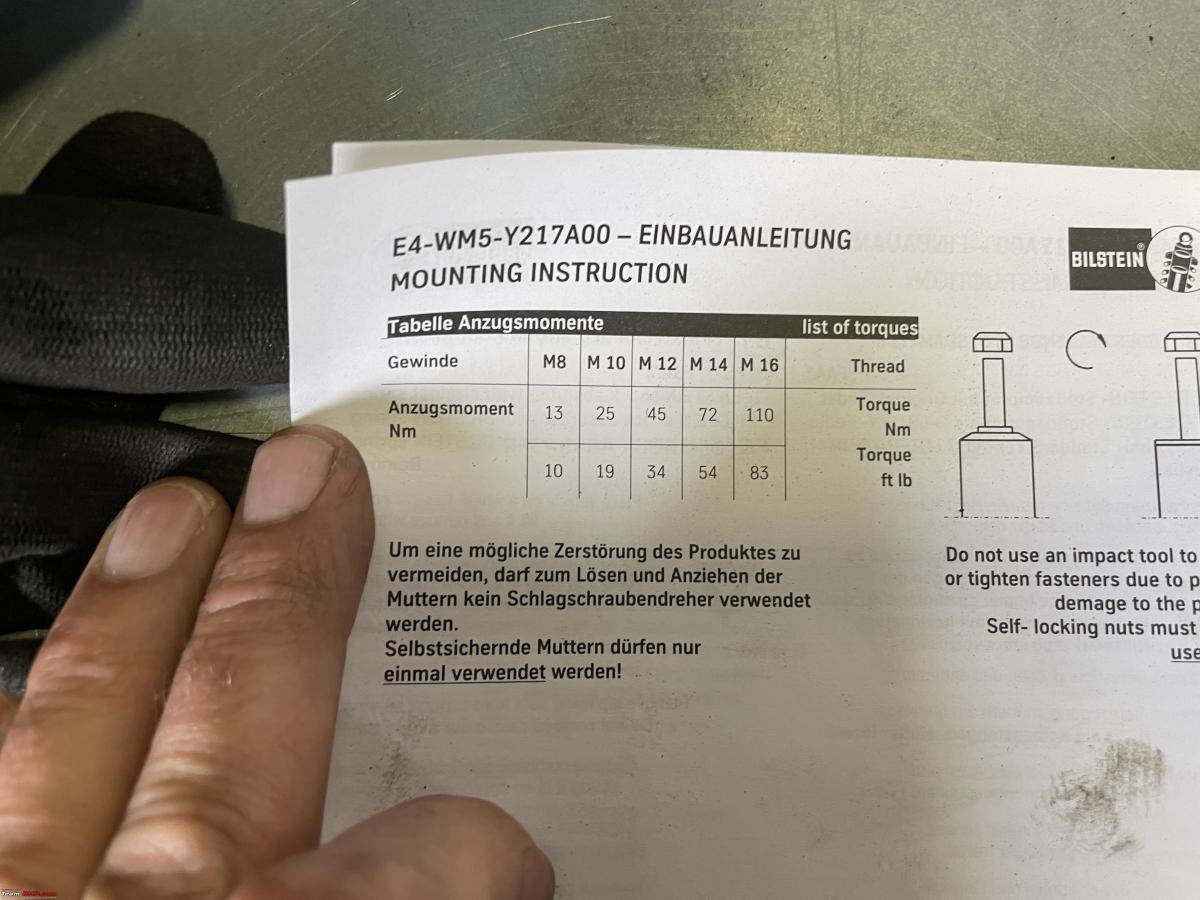
Started on the right rear one, so jacked up the Spider, axle stands underneath, and front wheels choked as per my SOP

It is not that difficult to mount these new shocks. Apart from one thing. You need to depress them fully before inserting them, through the little panel at the back of the cockpit. These shocks always expand. It takes quite a bit of force to push them in. As soon as you let go they start expanding again, slowly but surely. The problem is when you insert the shock whilst it is expanding it will get stuck and it will be very difficult to remove it again.
So I have a little trick; I put the shock in my vice, compress them and put a clamp on it. Next I tie some thin metal wire around it to hold it in place whilst compressed.

Works really well, you just need to remember to extract all bits of metal wire afterwards. But as long as you haven't tied the nuts and bolts down on the shock fairly easy.
My BIG plier came in handy too. When tightening the nut underneath the trailing arm the shocks start to turn. I could easily clamp it with my pliers. Make sure you don't damage the shock's outer casing, you must clamp on the weld on the outer case!

Shock-mounted as seen through the little panel.

The final touch, re-positioned the rubber protective boot!
All done. I still need to fit the interior trim a bit better. I will do that tomorrow. The fresh paint on the window guide will be hardened tomorrow as well. So I can glue the new seal in and let it dry for another day.

Check out BHPian comments for more insights and information.
News
Alfa Romeo's EV can't be named Milano, says Italy
he Milano will be the first Alfa Romeo to be built entirely outside of Italy.
Alfa Romeo recently unveiled its first mass-market electric SUV, the Milano - named after the famous city of Milan, Italy.
However, the Italian government has now announced that the name is illegal. The country's government has stated that since the car will be built in Poland, it can't sound Italian. Alfa Romeo is an iconic Italian brand but is now owned by Stellantis. The conglomerate has been at odds with the government for months, stating its displeasure towards the lack of support for EV adoption and also not supporting home-grown brands like Alfa Romeo and Fiat.
However, the Italian government retaliated saying that moving the production out of the country was a step too far. Adolfo Urso, Italy's Industry Minister, even slammed Stellantis' decision to build the EV in Poland. The Milano will be the first Alfa Romeo to be built entirely outside of Italy, and if the vehicle isn't built in Italy, it can't have an Italian-sounding name.
Urso, stated, "A car called Milano cannot be produced in Poland. This is forbidden by Italian law." She added, "This law stipulates that you cannot give indications that mislead consumers. So a car called Milano must be produced in Italy. Otherwise, it gives a misleading indication which is not allowed under Italian law." Urso is referring to the law set in 2003 that prohibits any product not built in Italy from having an Italian-sounding name.
The Alfa Romeo is built on Stellantis' e-CMP platform, which also underpins the Jeep Avenger. According to Carlos Tavares, CEO of Stellantis, producing the Alfa Romeo Milano in Poland helps the brand shave off 10,000 euros from its retail price.
Source: Electrek
News
Putting my Alfa Romeo's engine back into the car after an overhaul
These cars are fitted with Bosch L-Jetronic injection and ignition system. Lots of wires, sensors and endless hoses and tubes that all need to be fitted correctly.
BHPian Jeroen recently shared this with other enthusiasts.
Earlier this week, I spent a day with Marc and the Spider. Marc had finished overhauling the engine and it was time to put the engine back into the Spider.
Marc must have done this hundreds if not thousands of times. But I have done it only a few times. For me, it is very interesting to work alongside a real pro.
Engine all done!
We had to shuffle some cars around to get the Spider onto the lift. Marc always has so many cars at his shop, space is always at a premium.
This is what the engine compartment looked like.
Here is an image taken from the front of the Spider. In the middle centre, you see the bell house and if you look closely, you can just see the input shaft. To the right, you see the flanges of the exhaust. We also took the hood off, which makes it a lot easier to get the engine back in again.
On the right-hand side, you see the alternator. On the left is the AC compressor and also the fuel injector rail with all the injectors. The starter motor is dangling down there as well. Actually, it might look a bit messy. But everything is tied down with tie-wraps. All other components were laid out separately and very systematically by Marc and his team.
Marc doing the final prep on the engine.
Back in again. Marc put an axle stand under the gearbox/bell house so it is angled slightly upwards. That allows for easier mounting of the engine. With the engine dangling from a little engine crane it took less than five minutes to put the engine back in its place, flush against the bell house once again. From there on it is just a matter of bolting everything back in place.
I was very impressed with Marc's knowledge and experience. We had so many bolts, nuts, washers, rings. He knew exactly which one went where!
Having the Spider on the lift is so much easier. Because you need to work from underneath and from above on the various engine components.
We had taken the track rod off as well. Can't get the engine in with it in place. Makes for interesting front wheel positions!
By the end of the day, everything was bolted back into place again. So I filled the cooling system with the appropriate cooling liquid and the engine with engine oil.
With everything tightened up, we hooked up the battery as well. Moment of truth. First start after a complete engine overhaul!
Started the first time! Not bad. These cars are fitted with the Bosch L-Jetronic injection and ignition system. Lots of wires, sensors and endless hoses and tubes that all need to be fitted correctly.
One of the injectors was leaking a bit of fuel, Marc will fix that. I needed to leave, unfortunately. There are a few more little things to fix and then the Spider will be ready. The next stop will be the "rolling road" where we are going to test the Bosch system.
Check out BHPian comments for more insights and information.
News
Trying to fix a serious engine oil consumption issue on my Alfa Romeo
After diagnosing the problem, we believe that it could be a case of what is known as fuel wash.
BHPian Jeroen recently shared this with other enthusiasts.
At long last, Marc opened up my Spider engine! Just to recap. Earlier this year Marc did a complete overhaul of the Spider Engine. Ever since it has been suffering from serious oil consumption. During our trip to Scotland about 1l per 350 kilometre! So that is even more than before the overhaul. I noticed the oil consumption within a few weeks of the overhaul. We investigated and concluded that the engine was running way too rich. We replaced the fuel pressure regulator, the airflow meter and the O2 sensor.
But it only got worse. Marc suggested that keep driving it during the season and start investigating during the winter as I don't use the Spider during the winter. (I can't drive it during the winter months due to some silly classic car rule).
Although you always hope for something obvious and simple which can be fixed easily, I knew this was going to be a complex problem.
Marc had taken the engine head off again. Everything checks out fine. The valves are looking great. Valve stem glands and seals are as new (which they are).



Here is the problem, or rather the symptoms. All four brand-new liners look polished on the inside. The normal "honing" marks you would expect to see are virtually gone. On all four, in an identical way. Piston rings, compression and scrape rings were fitted correctly, oil disperse holes in all pistons are open.

This looks like a case of what is known as fuel wash. A fresh coat of oil protects the cylinder walls and bearings. If that protective layer of oil washes off, it becomes susceptible to damage. Raw fuel is one thing that can wash off the cylinder's protective coat. For this reason, any unburnt fuel in the cylinders can result in fuel wash. You're left with a wet mixture of raw fuel, which washes the oil away and can cause damage to the cylinder bores, pistons, and piston rings.
The most common causes of fuel wash or wash down as it is sometimes referred to are faulty and or leak injectors and or (vacuum) leaks. A common system is also poor starting. My Spider starts fine. Marc checked the injectors and we also checked, multiple times for (vacuum) leaks.
So based on all of this, we believe the injection computer might have a problem. Remember the Spider has a very early Bosch L-Jetronic system. Two separate computers, controlling respectively the injection and the ignition. It is also a complete analogue computer. The next Bosch Model, the Motronic series, combines both functions in one fully digital package.
The Bosch L-Jetronic computers have proven themselves to be very robust and resilient. But over time, electronics age.
We discussed three options:
- Repair the old computer
- Install a modern electronic (race box style) computer
- Convert to carburettors
To start with the carburettor conversion. It is certainly doable. But the engine compartment layout of the injection versus the carburettor version is very different. It means a look at modifications on many different parts. And then you need two new carburettors as well. So it's not going to be cheap.
I did like the idea of the new computer. But we decided to first go with the old computer. For two reasons. If we can get the computer diagnosed and it turns out it is faulty, we have found the root cause of the excessive oil consumption. If the computer can be fixed I will also retain the originality of my Spider.
However, there is a practical problem. Getting these old computers checked and repaired is becoming increasingly difficult. Marc knew somebody and he is going to check. As it so happens I have four (used) spare computers! Two injections and two ignition computers. If we find somebody that has the knowledge and the equipment to check and service these computers I will have him check my spares as well.
If we can't get the old computer checked or refurbished, we will go for the modern upgraded computer. The interesting is that inside the engine compartment, everything will remain the same. The new computer can be hooked up to all the old sensors in the Spider. All that is required is to swap the old computer for the new one, underneath the parcel shelf behind the seats! (Well, it is a bit more complex, but still)
Irrespective, with either the refurbished old computer or the new computer we will take the Spider to a facility with a Dyno, so we can do a proper engine run in combination with exhaust gas measurements. We have to make sure we are not getting raw fuel into the cylinders! The new computer needs fine-tuning on the dyno anyway.
So, we still have a way to go with this one! Should prove interesting what we find. I would love to have my Spider on the Dyno. Marc has fitted these new computers to many Alfa 105 series, with the same 2.0L as mine. He says without any further modification he can get it to crank out 150BHP easily. I am not so interested in the sheer horsepower. But a little more pulling power in the lower RPM band would be very useful.
We will see!
I had the Mini at my local garage (FNG you would say in India) for its annual MOT or APK as it is known here. They noticed the beginning of problems with one of the wheel bearings. I had them replace it because once you have a car on the lift it is dead easy. I also asked them to flush the brake fluid. My Mini was showing a "flush brake fluid" in the dash. Again, so much easier on the lift than crawling around on all fours on my concrete floor. Also, the last time I used my pressure bleeder it was leaking so I need to fix that first.
I managed to reset the "flush brake fluid" light afterwards. Only to have the "Service" light come on the day after. I knew it was coming. So I just ordered the parts. I will also replace the front discs, pads and sensors.
I also need to have another look at that pesky thermostat housing. I am still not convinced it is completely leak-free.
Check out BHPian comments for more insights and information.
News
Brazing workshop, a drive in Mercedes & a repair job on my Alfa Romeo
I had enrolled in an activity where folks from a nursing home were taken for a little tour in classic cars.
BHPian Jeroen recently shared this with other enthusiasts.
Last Saturday I participated in my third "Brazing" Workshop. I have written about brazing before. It is a very useful technique, you can use it to connect almost all types of metals and or alloys. And when done properly it will give similar, sometimes better, results compared to various welding techniques.
The last workshop was held in my garage, which proved to be an interesting background to such a workshop.
We had the same teacher, Wiel. This time the workshop was in a magnificent location. We were in an old monastery that had its own steam-generated electric power! Pretty cool those monks and priests!
A few images of our surroundings for the day:
One of two steam engines:
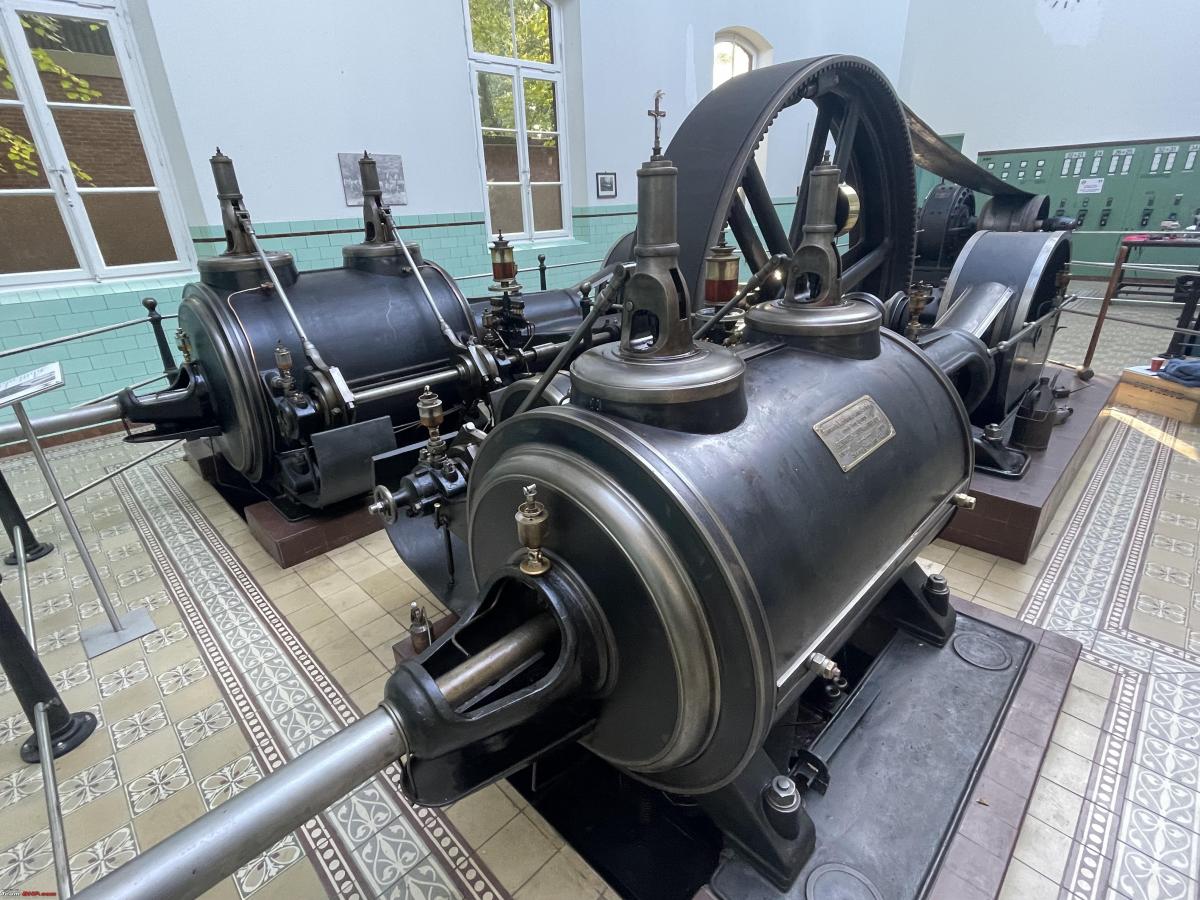
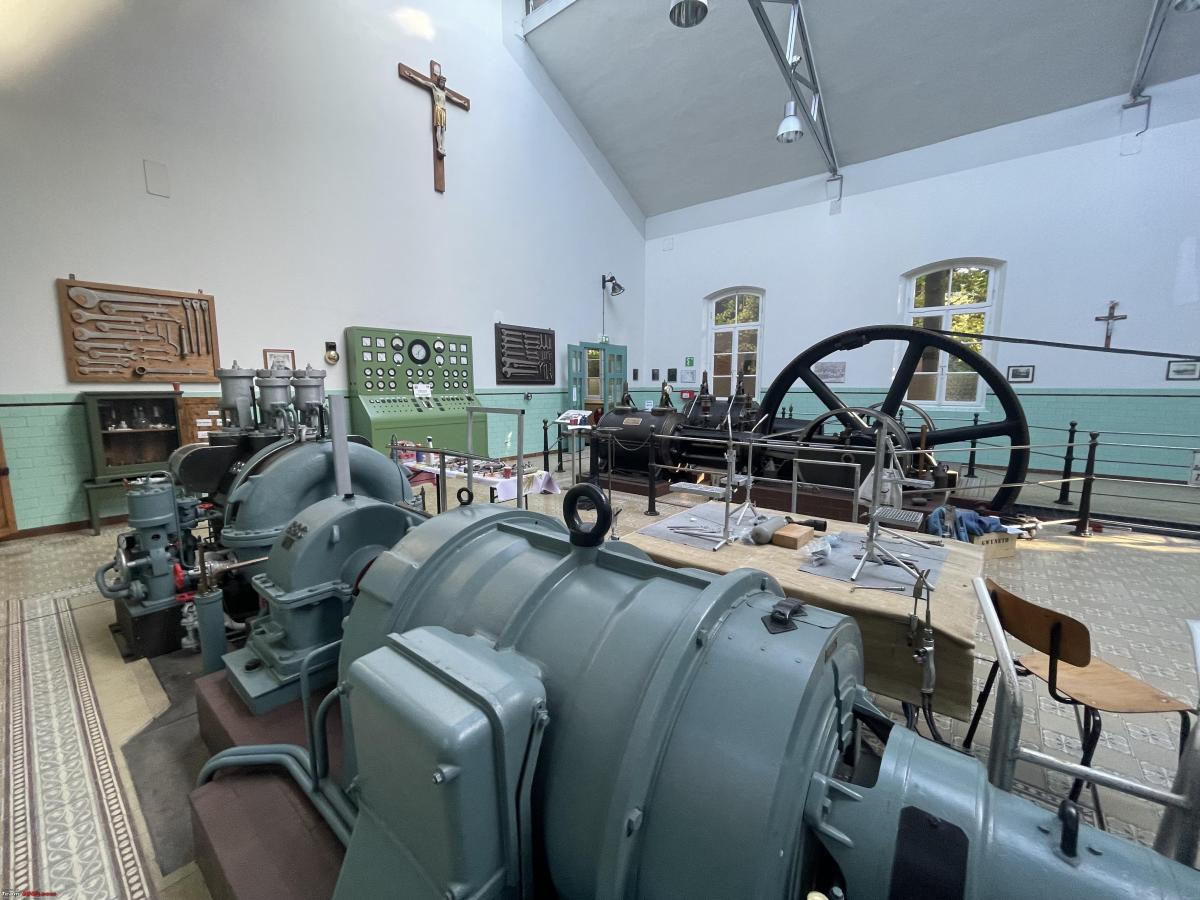

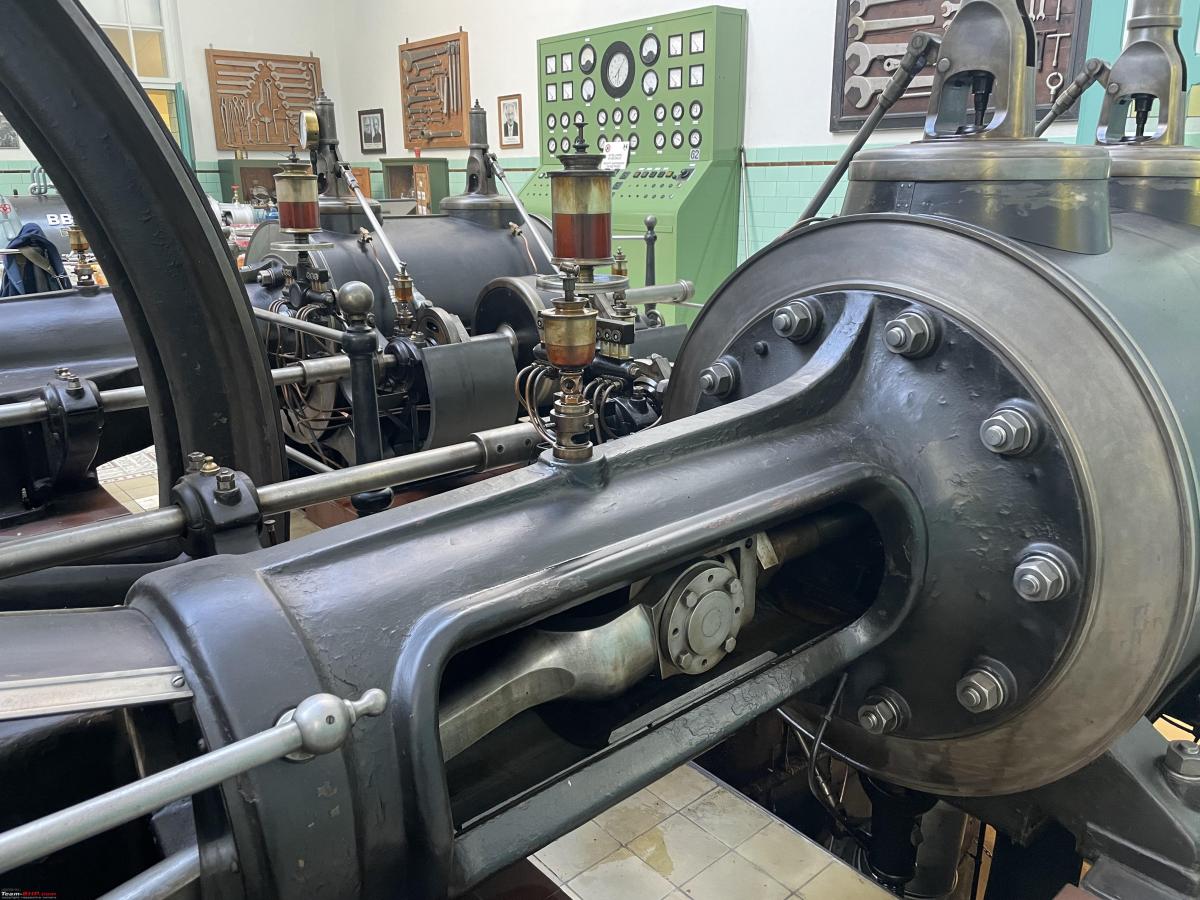
Control panel
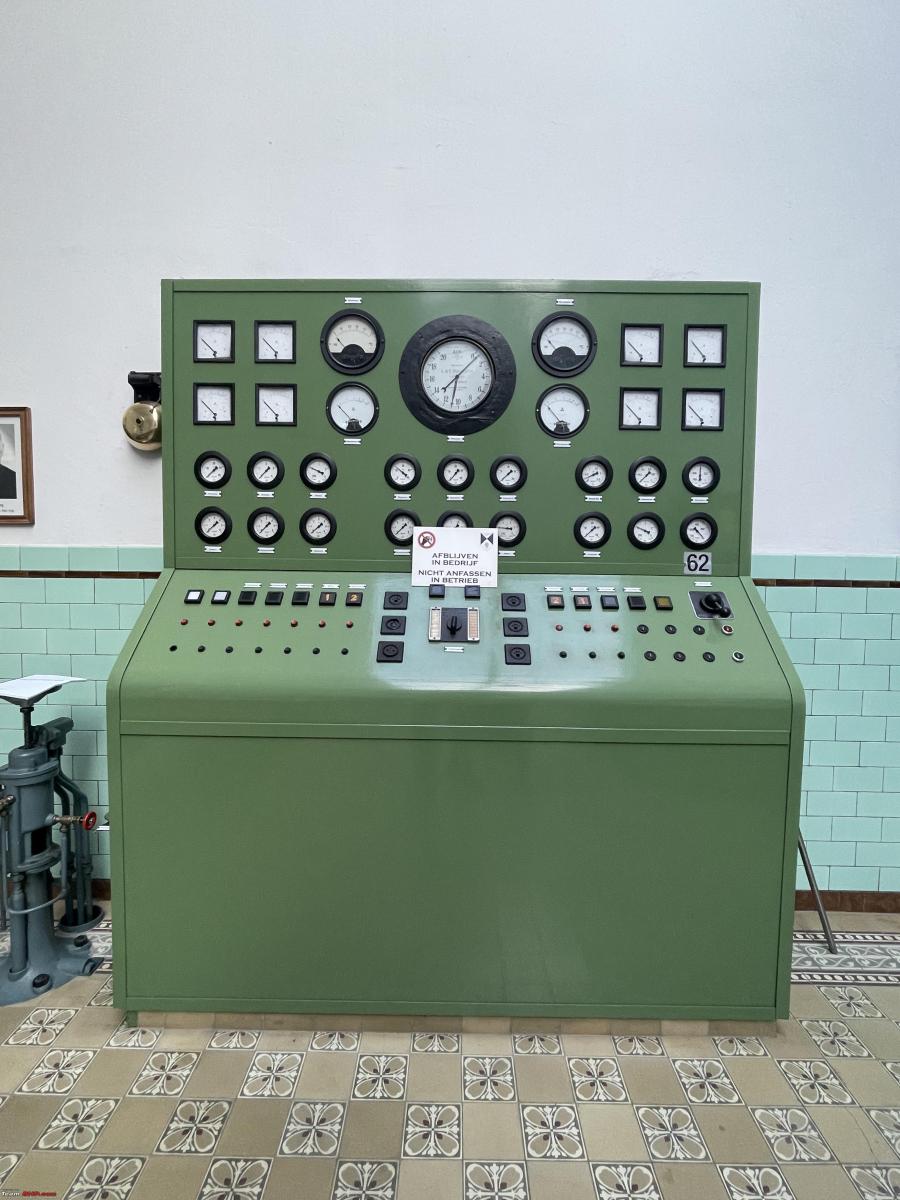
Some interesting tools, a little larger than what I have in my toolbox.
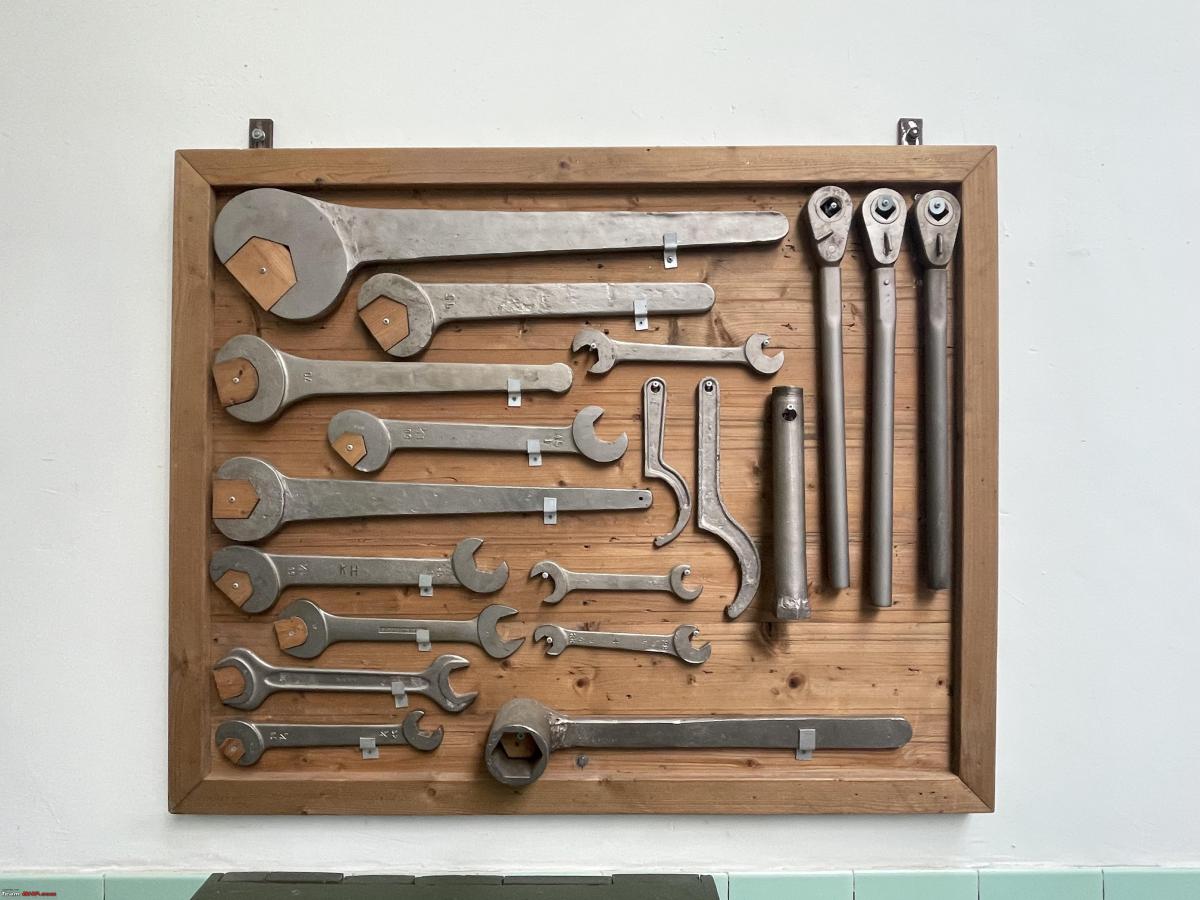
Electrical control panel
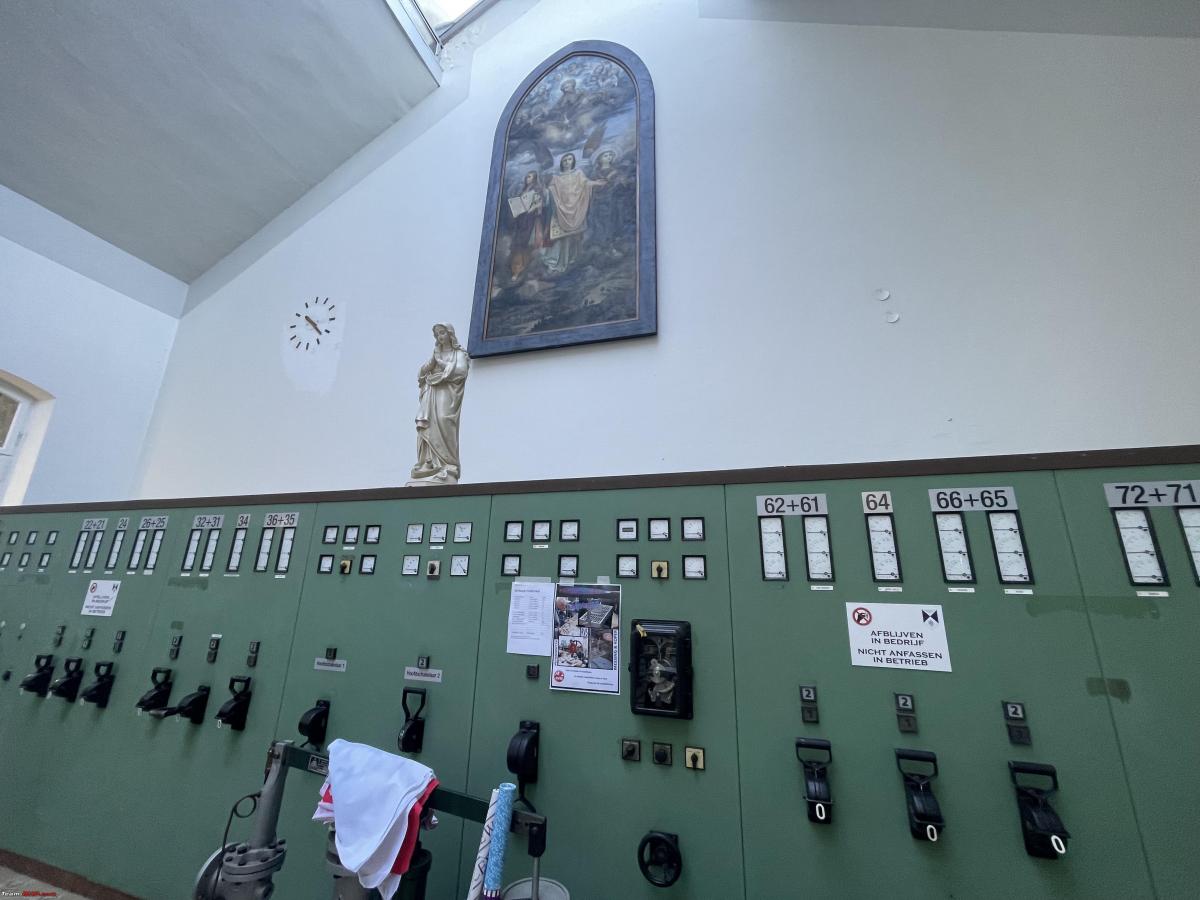
Very interesting to walk around. Wiel knew a lot of interesting details and background to this place. Very interesting.
But we were here for our workshop brazing!! So we did quite some brazing.
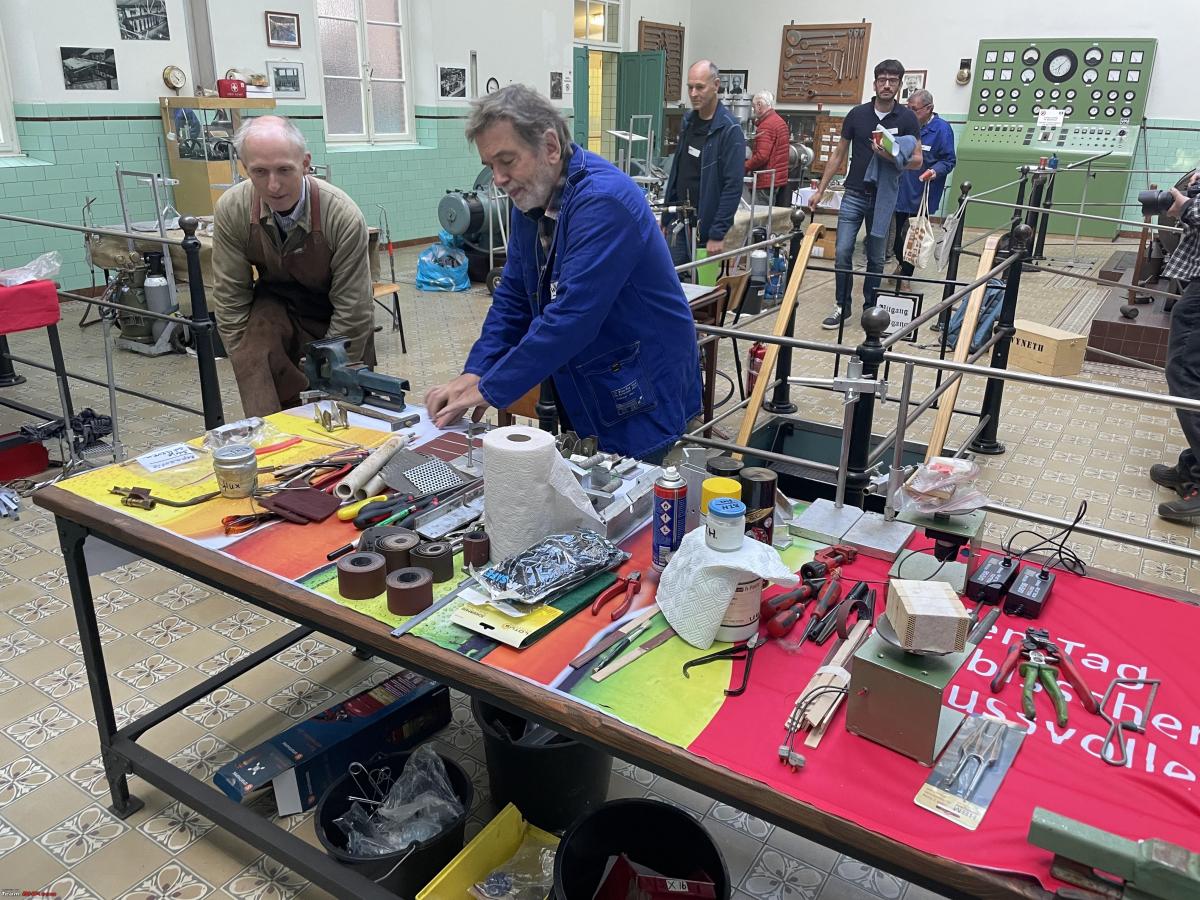
Yours truly in action, image courtesy of my friend Ruud.

I managed to learn a couple of new things. The four-stroke Scuderi Model Engine I am building is going to require some brazing of various parts in the months to come. All ready for it!
On Sunday I participated in a nice little drive with the Mercedes W123. I had enrolled in an activity where folks from a nursing home were taken for a little tour in classic cars. I have done this several times. It is always good fun and very rewarding. We only drove 60 kilometers in total with a coffee stop in the middle. Even so, it took all day. You don't want to be in a hurry with these elderly ladies and gentlemen of course.
There were about 20 classic cars and a few more regular cars to help out, bringing the wheelchairs, Zimmer frames nurses and so on. All done by volunteers.

As I have mentioned earlier, my Spider will be going back to Marc on the 1st of November to figure out the oil problem. During our tour of Scotland, I also felt the Spider pulling to the right. Marc had already tried to fix it, but it was still there. So I thought I would have another look myself.
The car has been aligned perfectly by Marc, and the tires and rims are in excellent condition and fully balanced. I replaced all four discs calipers and brake pads last year, including some new brake lines. So it is difficult to understand why it would still pull to the right. It also does it in a bit of a particularly weird way. I have had this before. Ultimately we managed to trace it back to a stuck ball joint. Because it was stuck, when you brake, the car dips at the front and the right wheel was pulled in a tiny bit due to the stuck ball joints.
So time to put the Spider on some axle stands and check a few things:
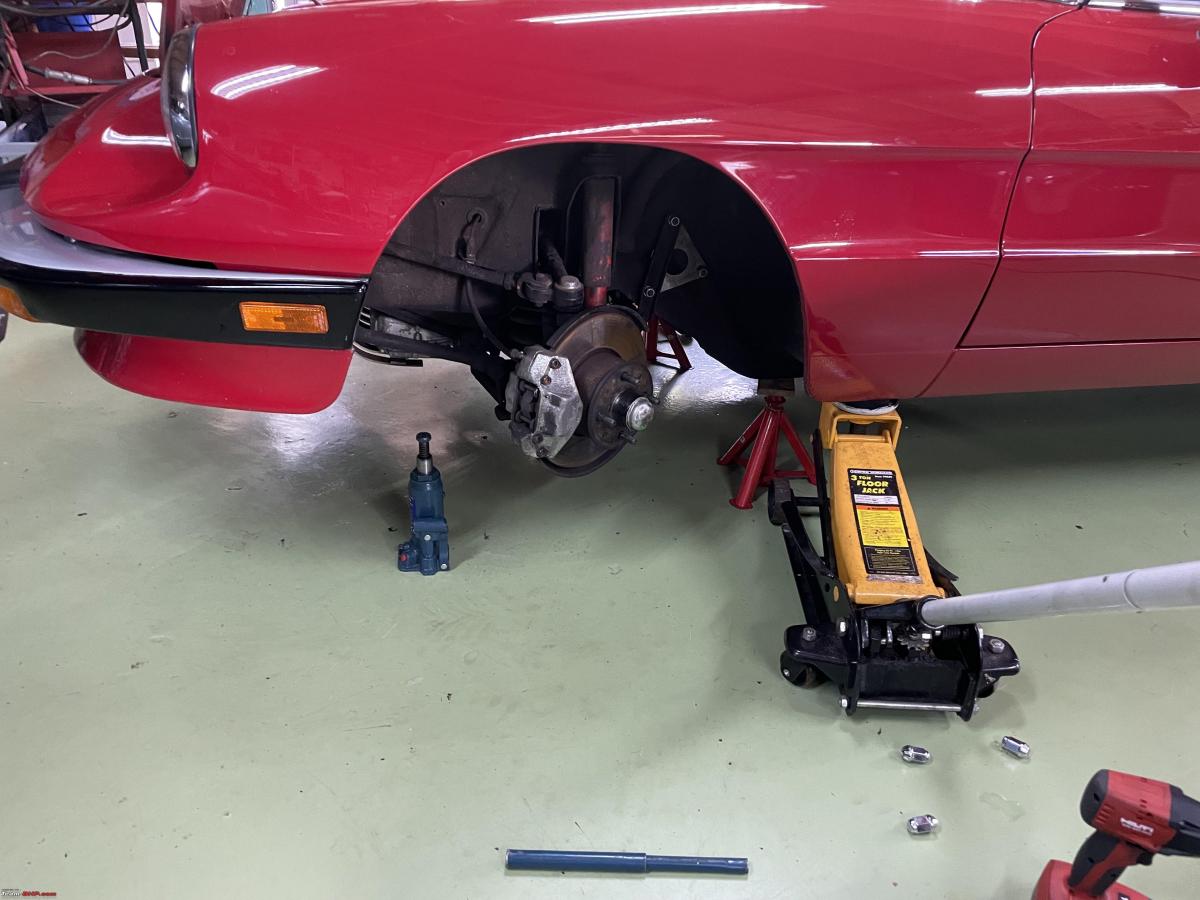
I popped the ball joints with my special little tool:
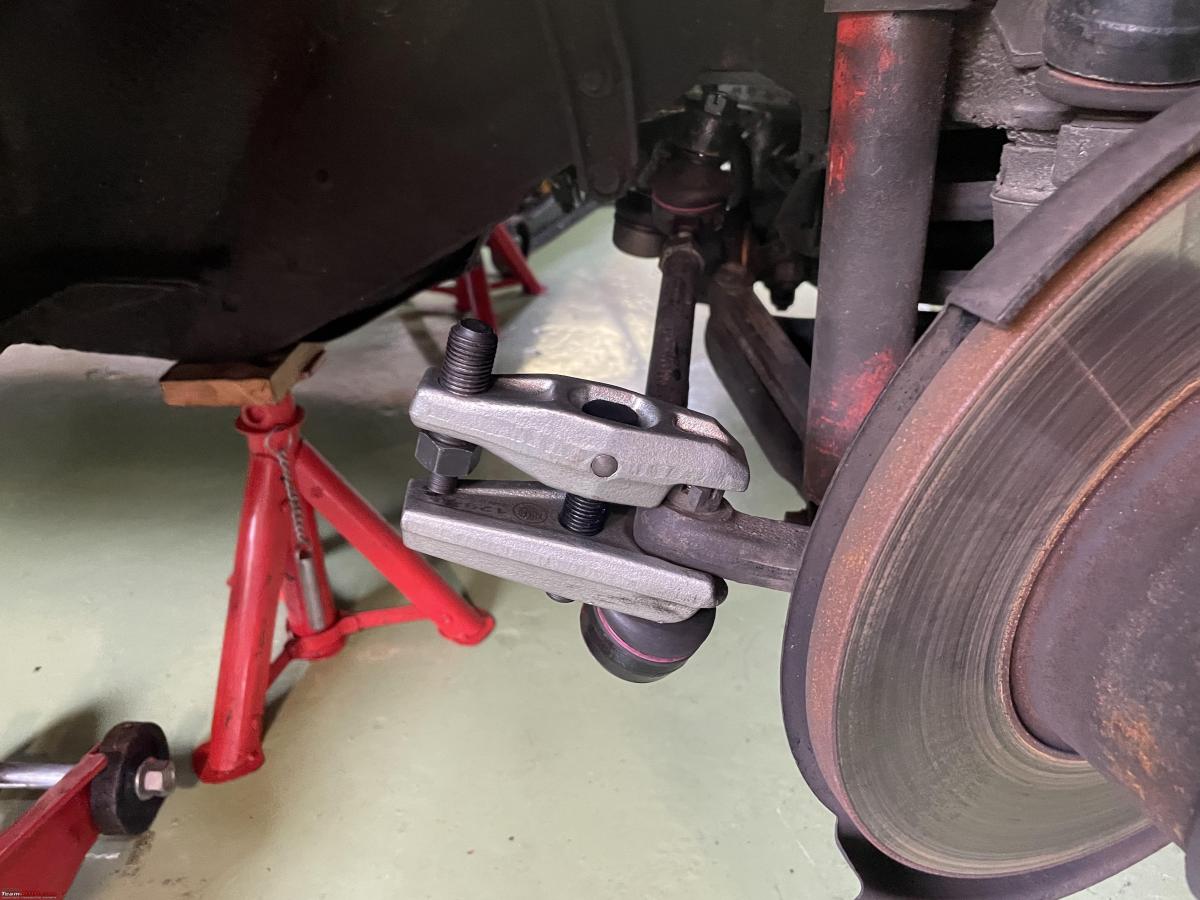
I kept the castle nut on the stud to make sure I didn't lose it:
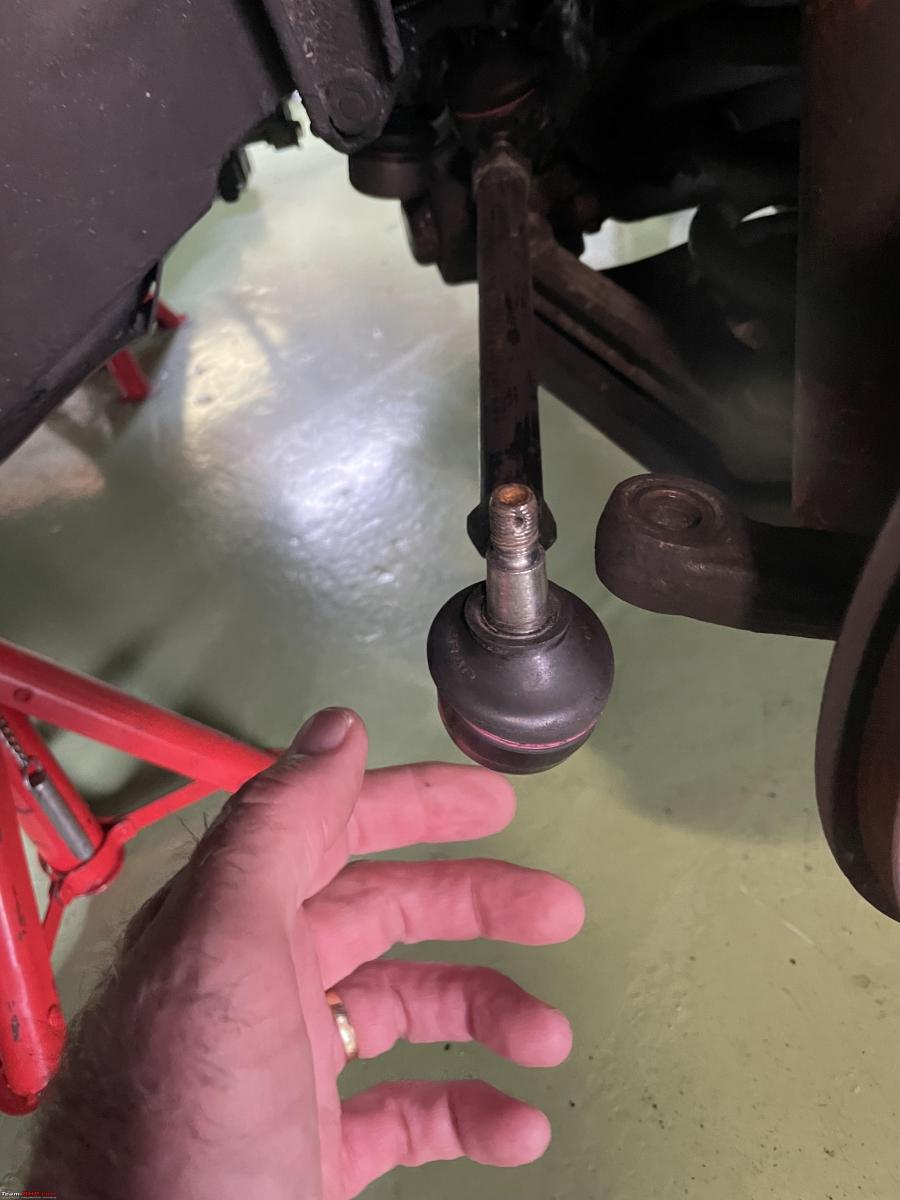
I checked everything as best I could. I could not find anything. Until I noticed this. Here you see the stud of the right ball joint in its two extreme positions.
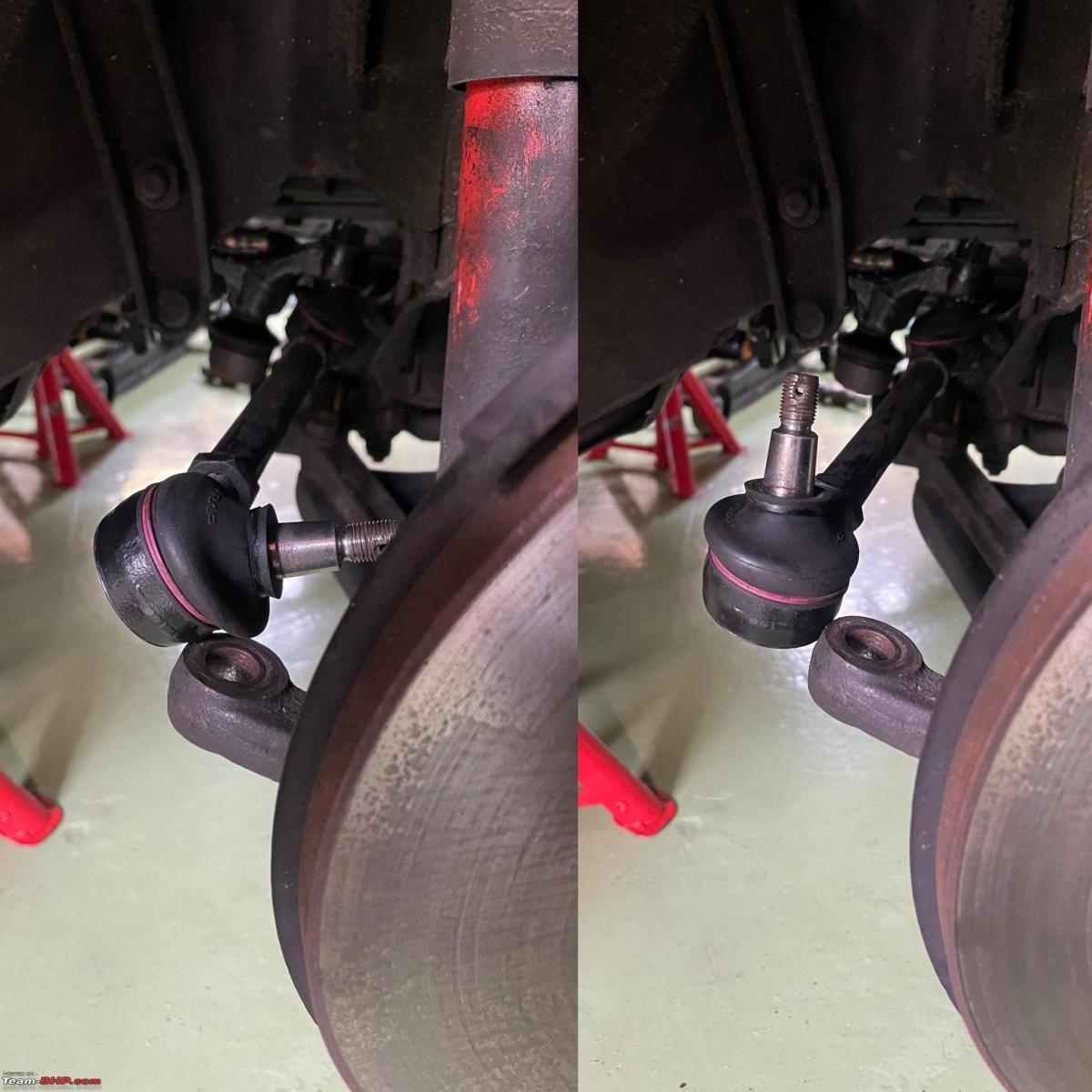
It looks like it might not be able to rotate sufficiently when fitted. However, when I put everything back together the effect was not present. It's difficult to judge these angles with the wheel removed and the suspension completely extended. We will need to recheck this when the Spider is back with Marc in a couple of weeks.
Put the front wheels back onto the Spider and tightened up my chrome lug nuts with the specified amount of torque. We have a recent thread on the forum that emphasises why you should always use a proper torque wrench and the proper torque setting when working on lug nuts!!
Also, the window wiper reservoir had started leaking again. You might recall I fixed this quite some years ago. Unfortunately, due to what looks like the ageing of the glue I used and mechanical wear due to stupid Italian design it developed two leaks again.
Technically, it is an MOT failure! Regardless, I wanted it fixed now. So I went to my local DIY centre and got some proper waterproof leak sealant. Applied it liberally to the out- and inside of the reservoir.
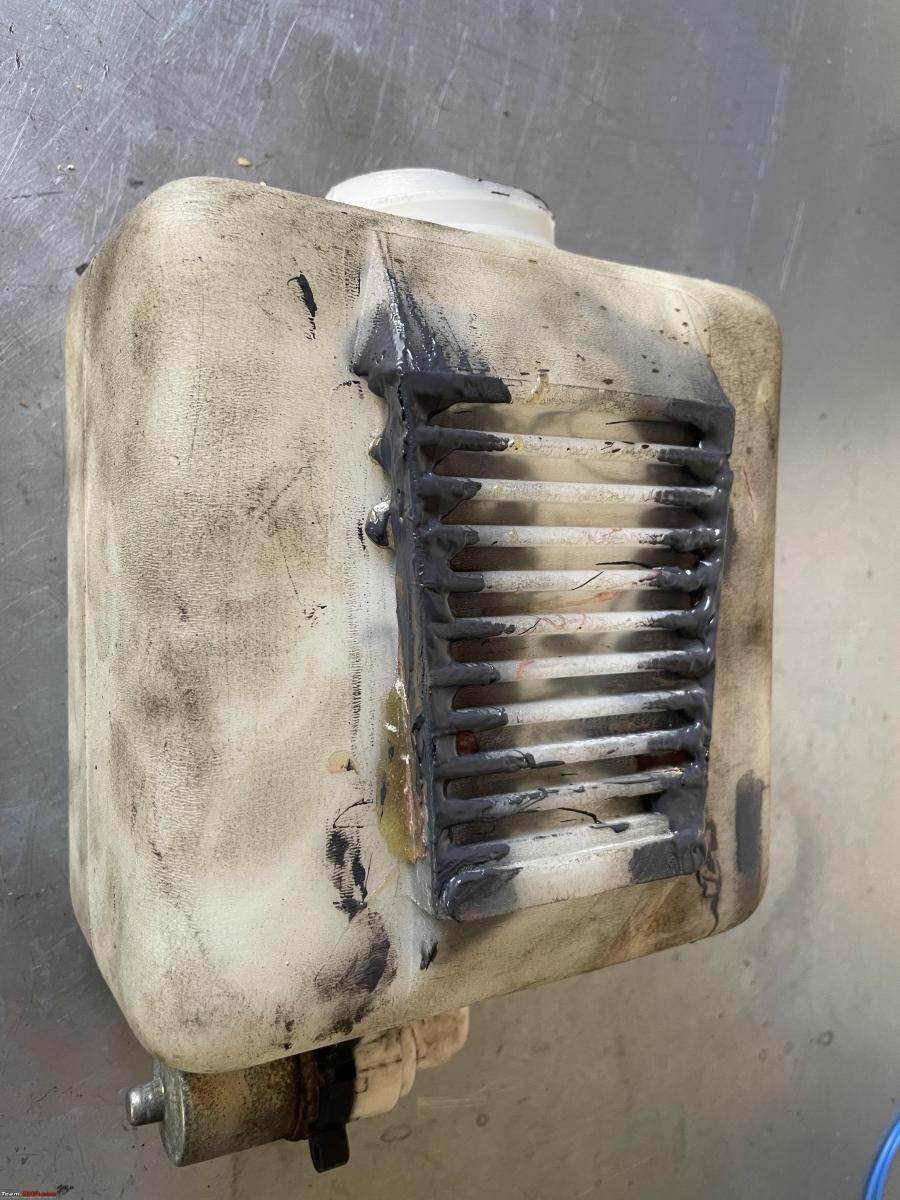
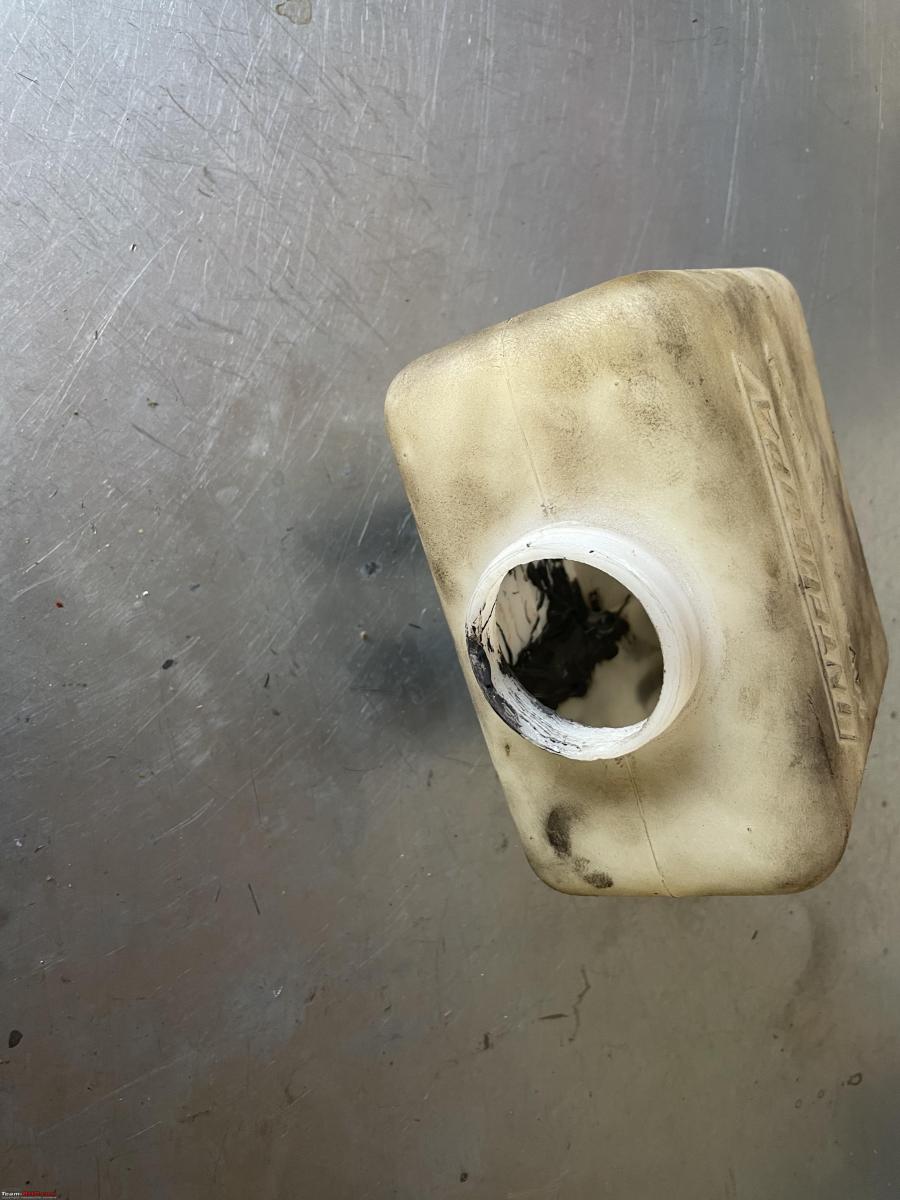
Part of the problem is the stupid V-shaped bracket that holds the reservoir. It is metal onto some pretty soft plastic, so a leak waiting to happen. I got one of my old bicycle's inner tyres cut off a few pieces and used it to wrap around the sharp metal bracket.
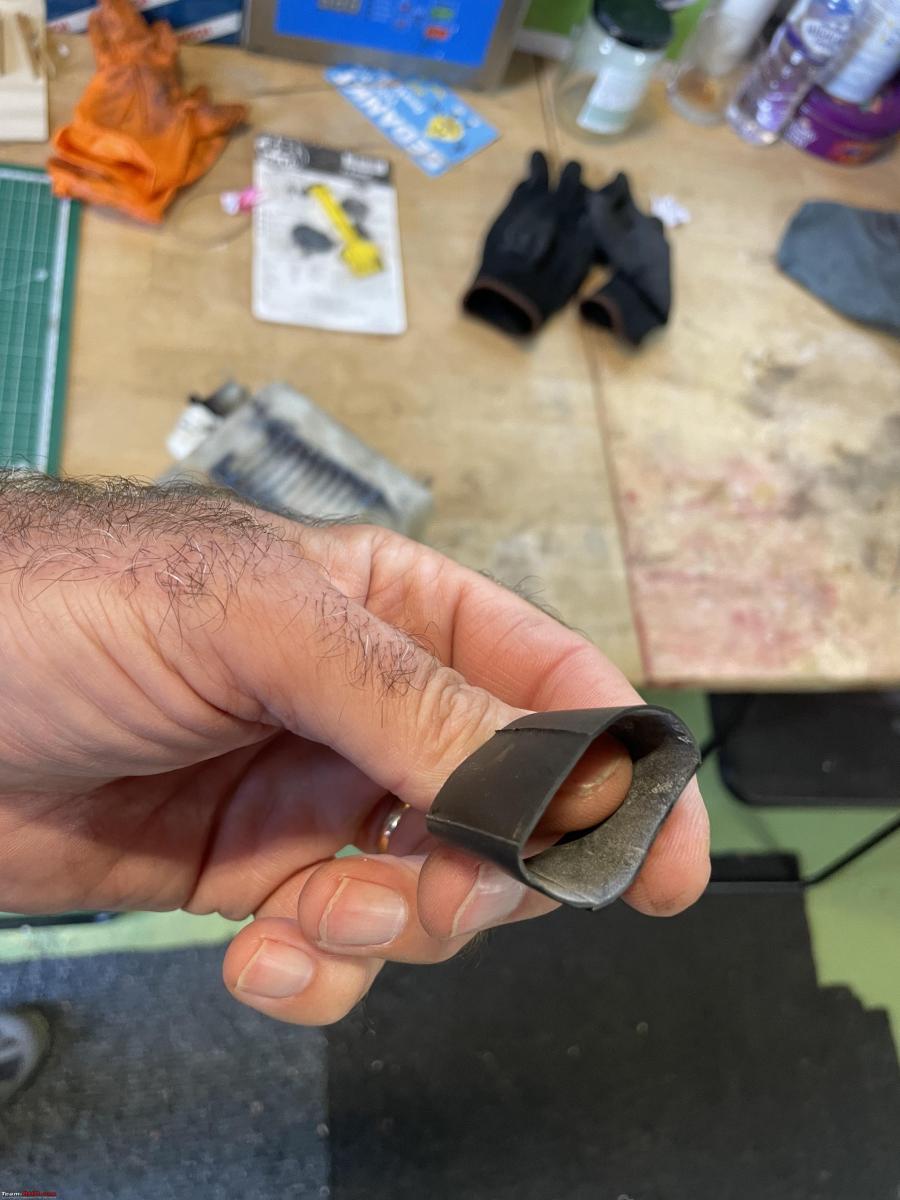
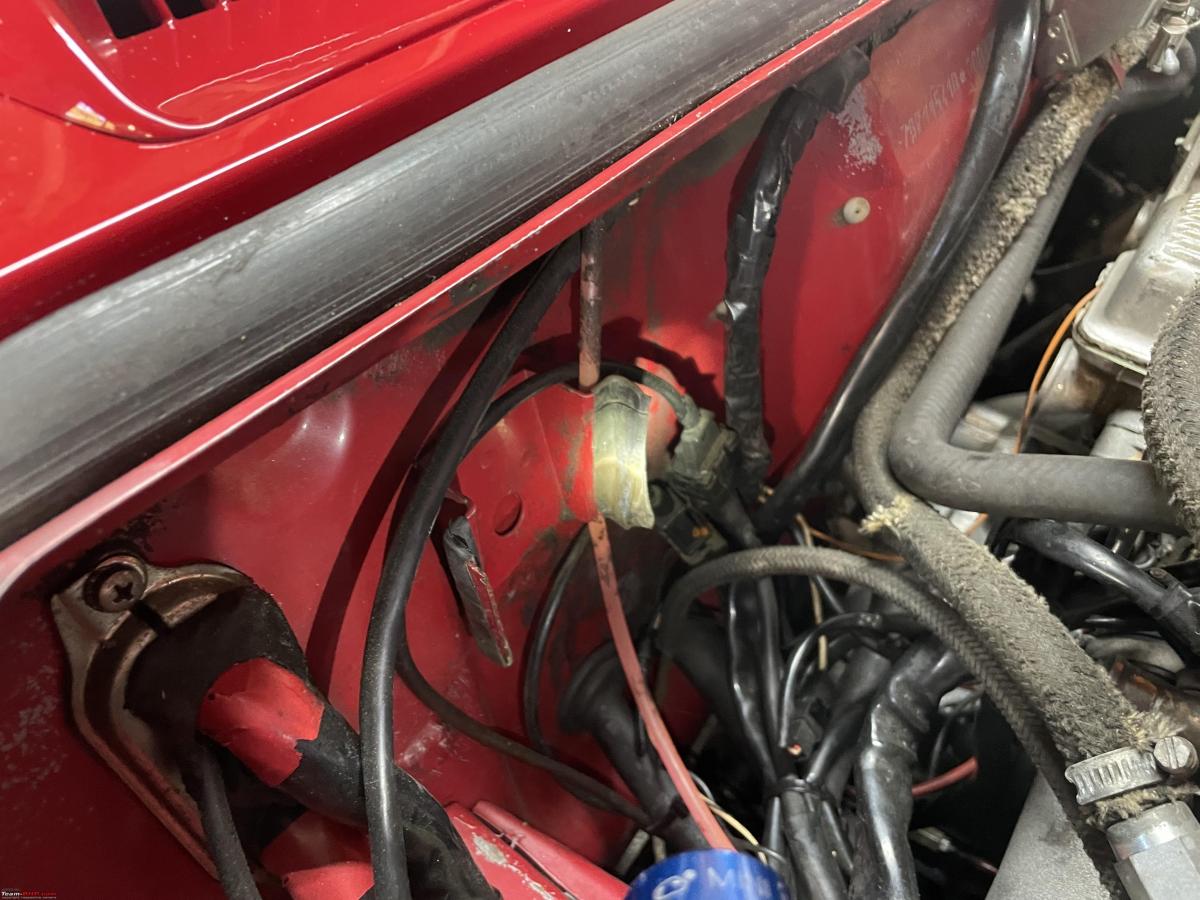
We will have to see how long it will last. Fingers crossed!!
This coming Sunday I am helping my good friend Berndt at the BritishCarClubDay.
Berndt has collected hundreds if not thousands of folders and brochures on English cars. He wants to get rid of them, so he has rented three market stalls for us to display and sell all of them. Fingers crossed for that as well. I am not sure how much documentation gets sold at these classic car events.
Irrespective, this is always a very enjoyable event. Mostly about British Car clubs and some commercial traders as well. Good fun, I am looking forward to it.
Check out BHPian comments for more insights and information.
- Tags:
- Indian
- Mercedes
- Alfa Romeo
- Classic cars
News
Visiting the Alfa Romeo Museum in Italy: My experience via pictures
It’s a large sprawling building around an 80 euro cab ride from Milano, in the direction of Lake Como on the road to the Italian Alps.
BHPian shankar.balan recently shared this with other enthusiasts.
Alfa Romeo has always been one of my favourite Car Marques. Forget what many people say about the brand, they somehow hold a timeless, visceral appeal and always will, for one such as me.

To echo the words of Jeremy Clarkson in his review, nay, his moving tribute to the glowingly gorgeous Alfa Romeo Disco Volante; while the name may mean Flying Saucer, to me, just as to him, the name will always bring memories of Emilio Largo, the Spectre Villain in the 1965 Bond Film Thunderball and his fantastic Hydrofoil Disco Volante.

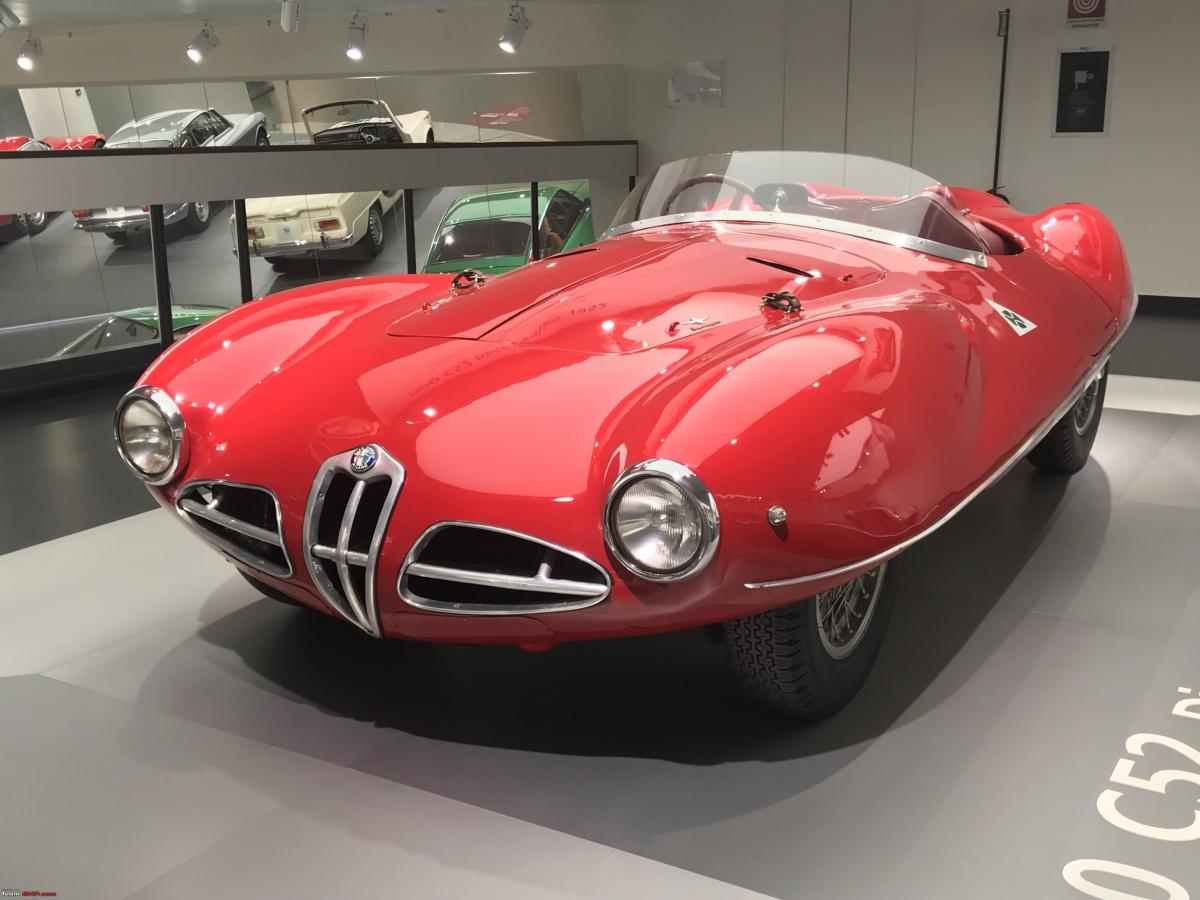

All these years, I've collected many scale models of these cars. Lusting after that badge has always been a part of my DNA. So on our “Trip to Italy” in 2018, my wife and I rented a lovely Alfa Romeo Giulietta and roamed around as a “part-fulfillment” of the “dream”.
Finally having enjoyed the art, the sculpture, the museums, the sights, sounds, and tastes of the country across the length of it and after paying homage to Ferrari as true Tifosi ought to, found ourselves on a Frescia Train from Firenze to Milano, en route more cultural and fashion insights.
Of course, I’ve been lucky to travel to Italy a number of times, but whenever I hop onto a Trenitalia or Frescia Train at Firenze Centrale/ Milano Centrale and/ or Roma and wind my way through the rolling countryside, Bologna and all, I always remember the lovely 1965 film Von Ryan’s Express and the way the Allied POW’s commandeer the Train along with the Italians who had lost their taste for fighting, and wend their way past Milano onto the Lakes and up the Mountains towards Switzerland and Freedom. It never fails to infuse me with nostalgia (which by the way, in the original Greek, means “the pain from an old wound), to quote Jon Hamm as Don Draper in Mad Men in his Kodak Carousel pitch.
Anyway, I digress. Forgive me for that, but whenever I do get these fits of inspiration (and knock myself out of my lazy complacency) and start writing, I tend to ramble a bit.
A neat little Segue into the topic of Alfa Romeo and their beautiful Museum and the multiple pictures I took while there.
(Again, I won’t burden everyone with zillions of photos, but only my favourites, along with a little garnishing by way of commentary.)
It’s funny, but sitting down to type this, the memories seem to be flowing freely, aided admirably of course, by Messieurs Steve Jobs and Tim Cook and the Apple iCloud!
Rho Fiera - Arese.
It’s a large sprawling building around an 80 euro Cab ride from Milano in the direction of Lake Como on the road to the Italian Alps. I won't bother repeating all the history which one can easily read on the internet. I'll just share my special passion by way of curating the photos.

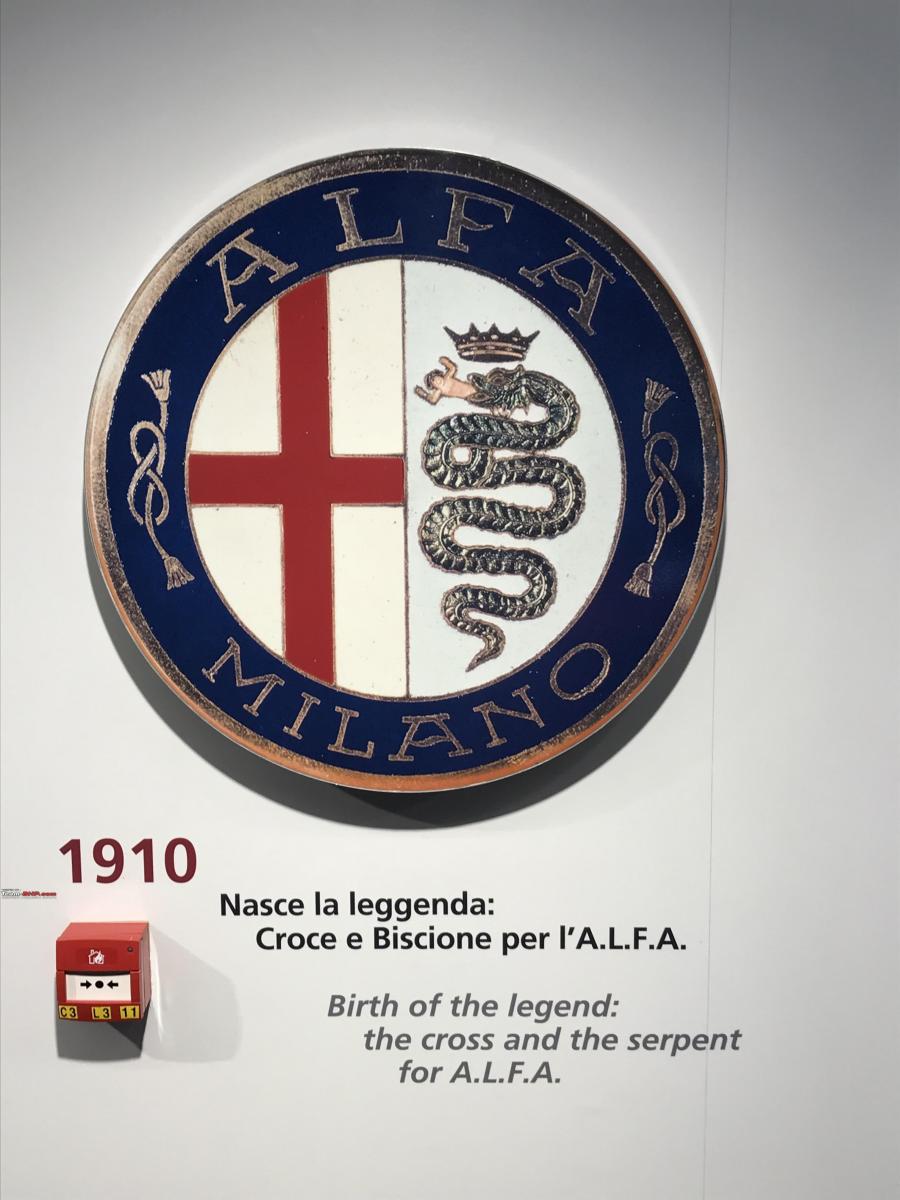
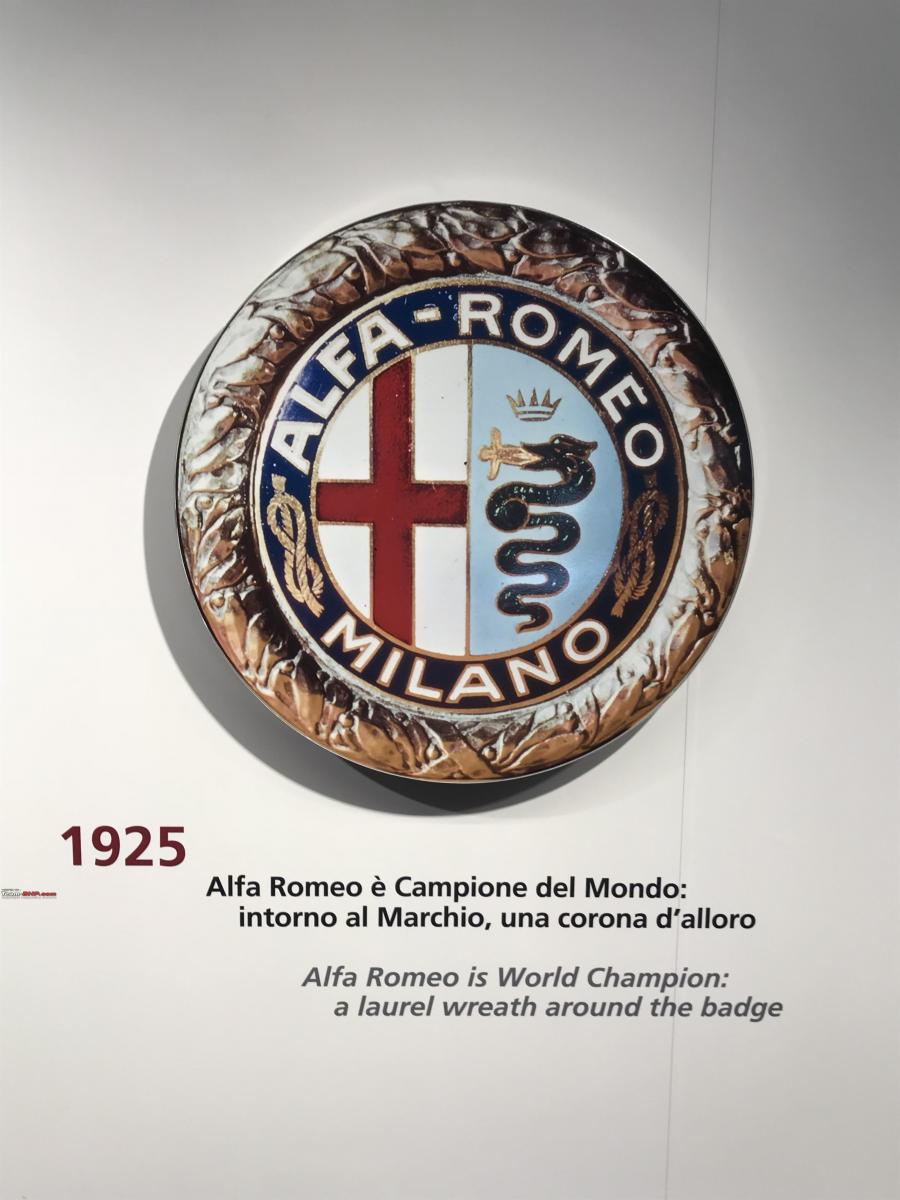




Continue reading BHPian shankar.balan's museum visit for more insights and information.
- Tags:
- Indian
- Alfa Romeo
- car museum
News
Travelling from Netherlands to Scotland via a ferry in two Alfa Romeos
We had booked a return ticket for two and two cars, two cabins, a 3-course dinner and breakfast for which we paid almost Euro 600 (INR 53000) per person.
BHPian Jeroen recently shared this with other enthusiasts.
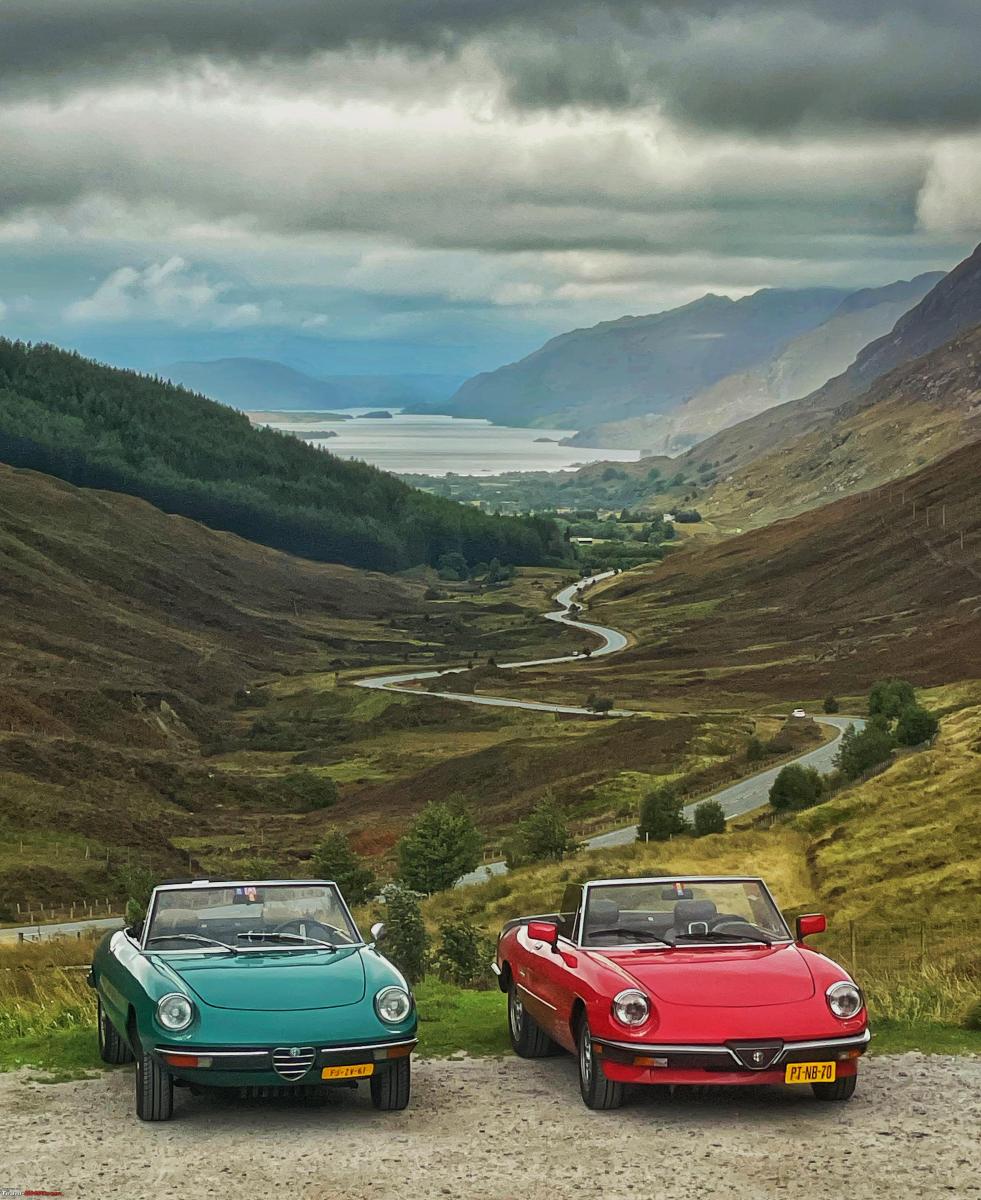
Every year my best mate Peter and I take our Alfa Spiders out for a 4-5 day trip abroad. I have written about a number of our annual trips before. This year we decided to take a trip to Scotland.
We live in the Netherlands. There are various ways of getting to the UK from the Netherlands by car. I have mentioned the Stenaline crossing Hoek of Holland Harwich before. However, when you want to travel to Scotland, you want to take a ferry that takes you as North as possible. That means we booked our trip to IJmuiden Newcastle some 6 months ago. We left IJmuiden on Thursday the 7th of September, at 17.30 and were back in IJmuiden Wednesday 13th of September at 10.00 hours and some 1750 km of driving behind us!
These annual trips are about driving our Spiders and enjoying each other's company. So we tend not to have a specific goal or destination in mind. We usually play it by ear. At breakfast, we usually plan where we want to be around lunchtime. At lunch time we plan for the rest of the afternoon and by about 16-17 hours we start looking for a place to sleep and eat.
IJmuiden is a Dutch coastal town, with massive locks that are the entry to Amsterdam harbour. There is also a small fishing harbour outside the locks. It is also used for various offshore activities/vessels and the DFDS ferry docks here as well.
As Peter lives in the North and I live in the South we had agreed to meet at the Ferry terminal by about 15.00 o'clock.
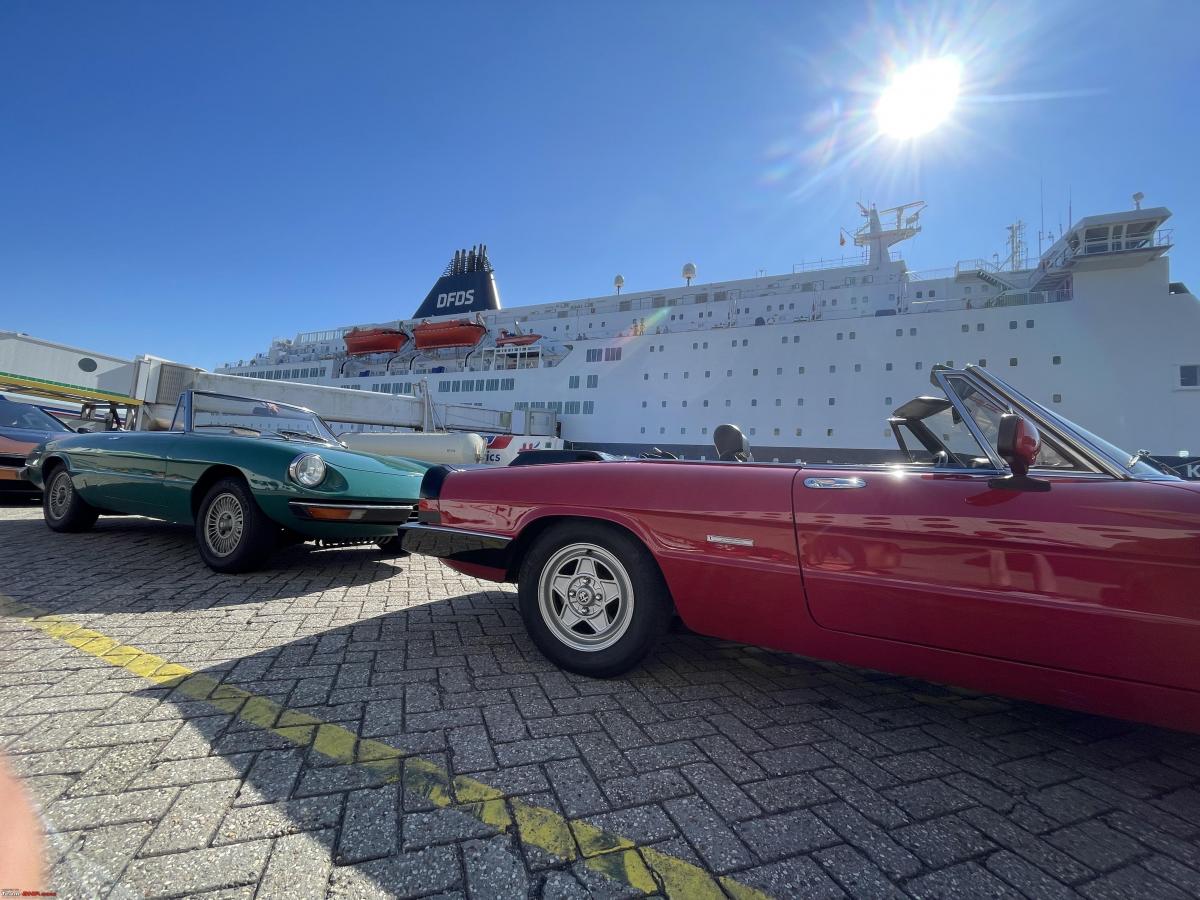
As per our usual routines, we stuff our Spiders with various parts and lots of tools, just in case. These Spiders are well over 40 years old. We never made a trip abroad without having to do some kind of spannering, so better be prepared.
We had booked a return ticket for two and two cars, two cabins, three-course dinner and breakfast. As we had booked early we got a 20% discount. Still, per person, we paid almost Euro 600 (INR 53000). Not cheap, but you only live once as they say!
We have been on numerous ferries over the years. And we have visited the UK many times, however, the last time we toured Scotland was some fifteen years ago. And we were going to cross on the same ferry as fifteen years ago.
She was built in 1987, this ship went through a major renovation in 2006 and has a wide range of restaurants, shops, bars, cafés, two cinemas, casinos and children’s entertainment.
Technical Details:
- Length/Width: 163m x 28m
- Cars: 600
- Cruising Speed: 21 Knots
- Engine Output: 19,880 kW
- Passengers: 1325
- Year built: 1987
- Cabins: 522
- Renovated: 2006
So it is quite an older ferry. But very well kept. We found the restaurant and dinner excellent. Really good choice of very well-prepared food and drinks.
The cabins are quite small but still perfectly adequate. You tend not to spend any time in your cabin on these crossings, other than for sleeping.
Bunk bed, for single occupancy the top one is raised flat against the wall of the cabin.
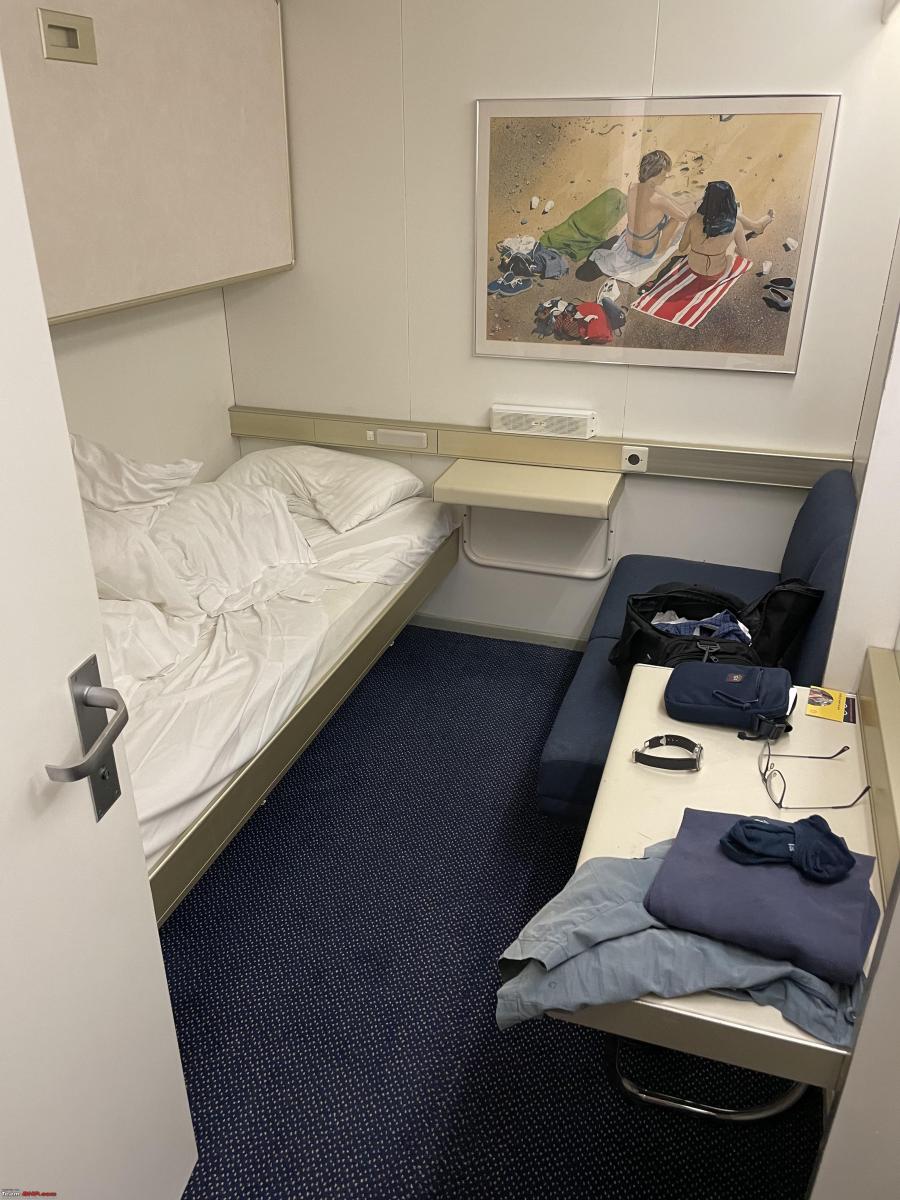
Tiny bathroom
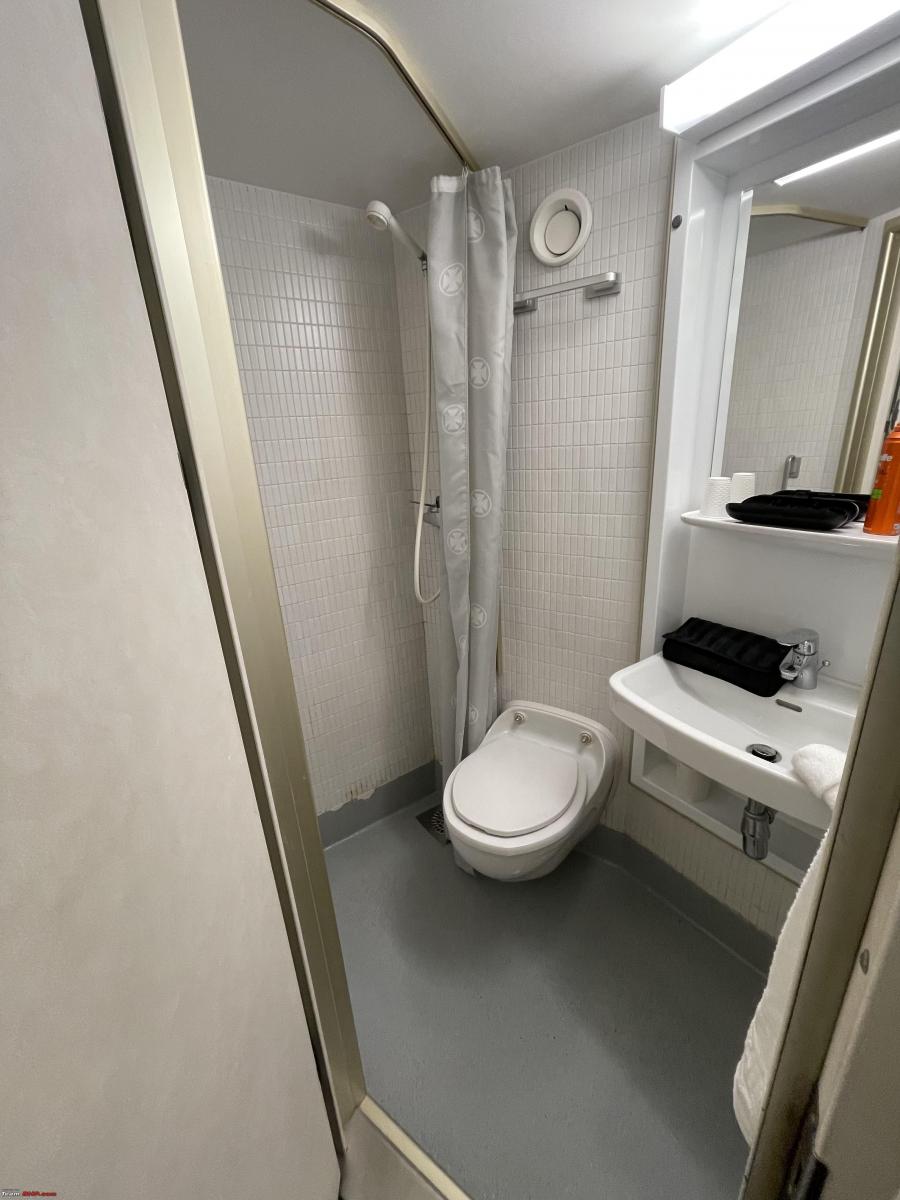
Boarding the ferry went pretty smoothly. You pass a DFDS check-in point and Dutch immigration. From the minute we arrived till we had parked out Spiders onboard was about one hour. DFDS starts boarding cars and foot passengers well in advance of the actual departure time. So if you arrive a couple of hours early they will let you board as well. Much better than hanging around on the quayside.
We were directed to deck number 5, which was a bit of a squeeze. The Spiders are quite narrow, but there were modern SUVs on this deck as well. Could hardly get past them. Every car is "marshalled" into the exact position. This means the mirror of my Spider was about 2 cm from the wall!

The weather was gorgeous. So we dumped our bags in our cabins and went straight up to the top deck to enjoy the sun, have a drink, and watch the cars and lorries and the endless seagulls trying to steal food from unsuspected passengers.
We left a couple of minutes early. Here we are just passing the northern breakwater pier of IJmuiden.
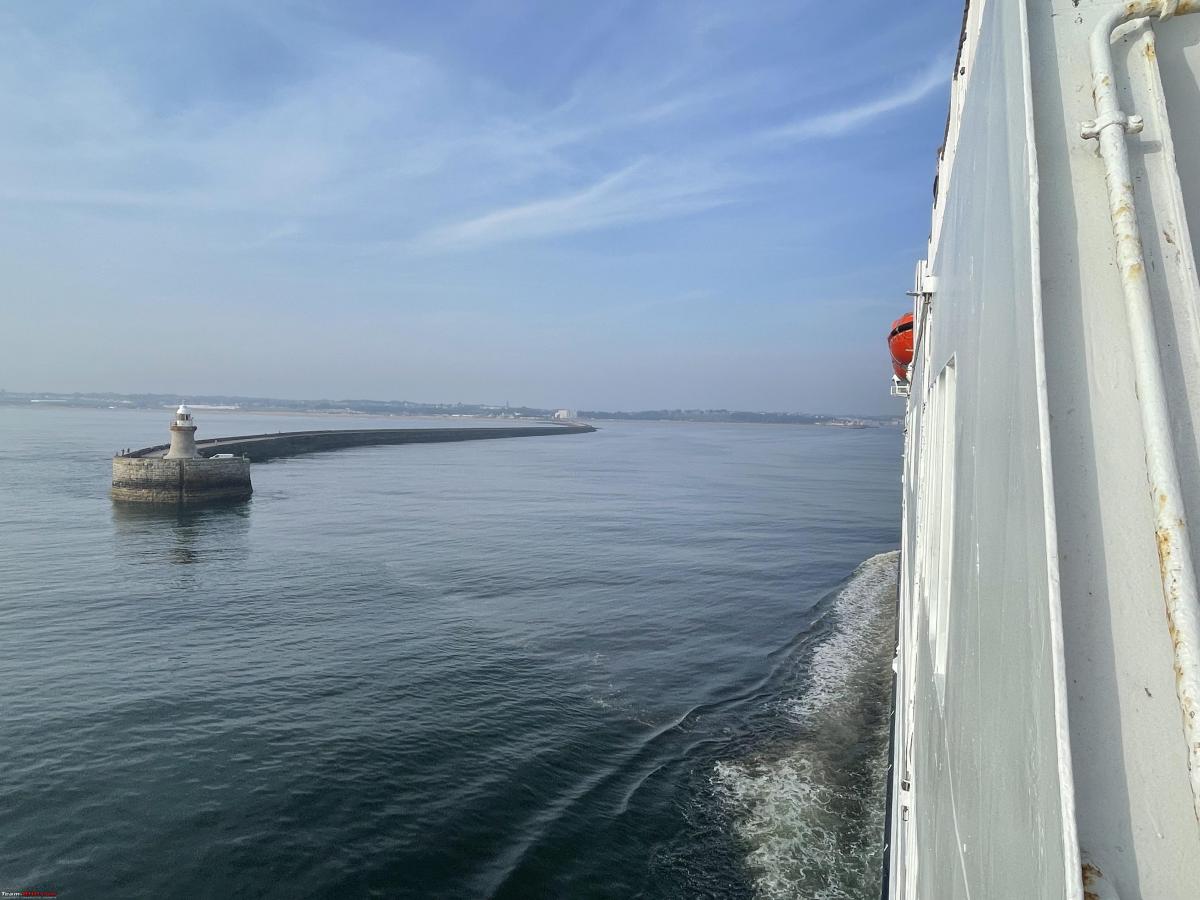
Some of you might know I started my career in the Merchant Navy. I left the merchant navy in 1986 having sailed as Chief Engineer on all sorts of vessels. Although my sailing days are long gone, I still enjoy being out on ships, going to maritime conventions and so on. On every ship, I find myself I will always introduce myself to the crew as a former Chief Engineer and colleague. Could we please have a look in the engine room?? Of course, you can!!
If you're not into engine rooms, scroll past the next couple of images. Peter had never visited an engine room, so it was a new experience for him. We got picked up at the reception desk by one of the apprentice engineers who took us down to the control room.
Some of you will notice this is an all-analogue control room. This is a traditional analogue diesel engine control room. Lots of gauges, levers, buttons and some annunciation panels. All officers are Danish. They also have Dutch crews.
We met up with the second engineer on watch. We talked extensively about various (technical) topics and he took us on an extended tour all over the engine room.
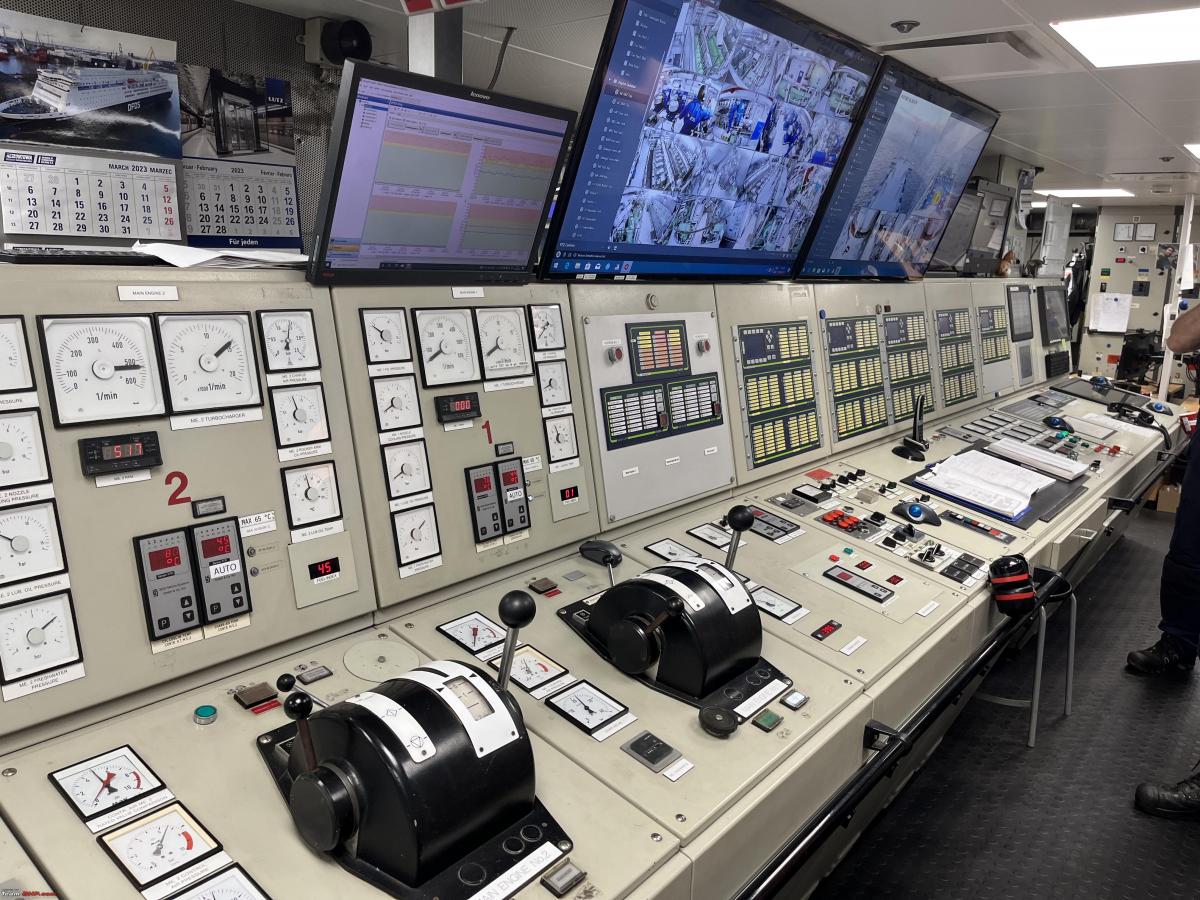
This ship has four, identical, main engines. All MAN. They are coupled in pairs, via a gearbox to two propellers with controllable pitch. All the engines run on very low sulphur diesel. This means this vessel is exempt from having exhaust scrubbers. Which is a good thing too. Can be very complex retrofitting on old vessels.
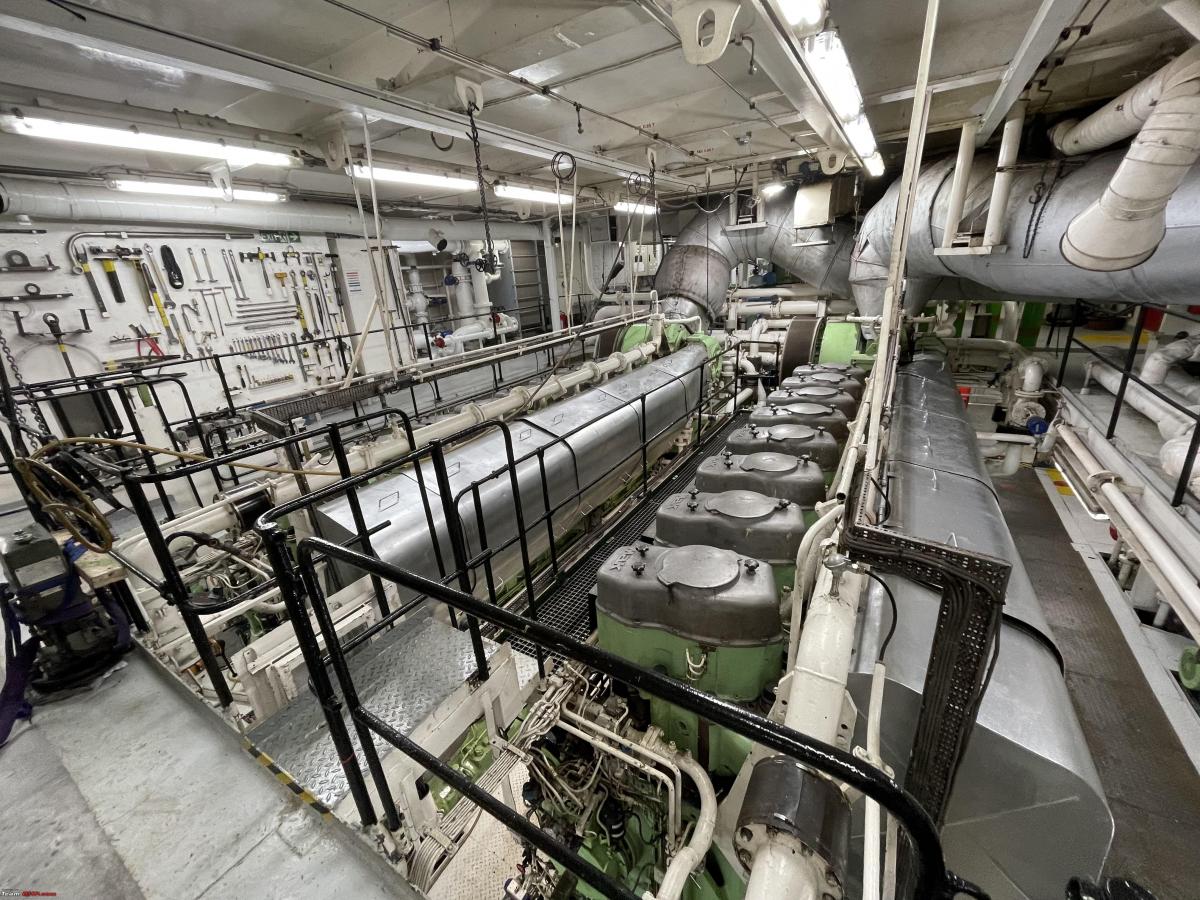
The gearbox at the rear of one of the main engines.
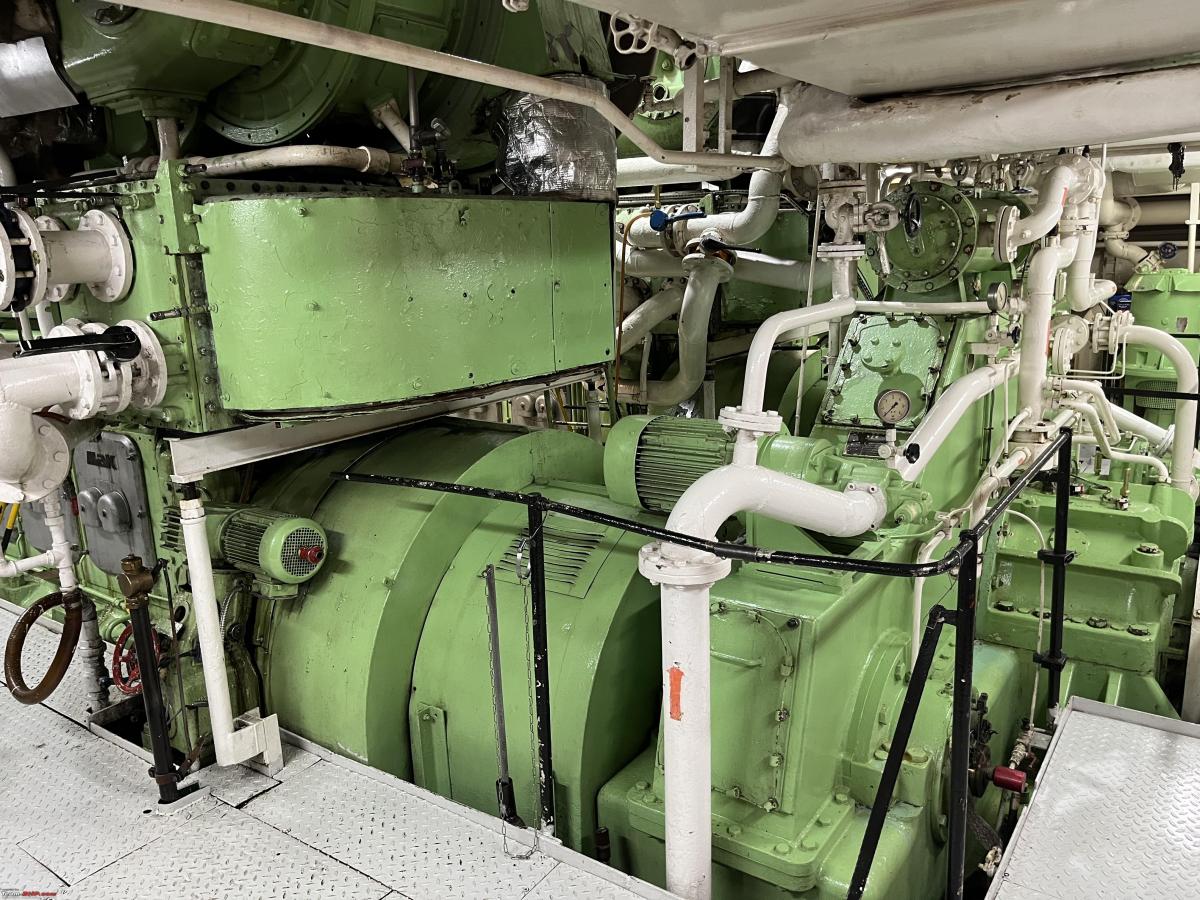
One of the propellor shafts going aft.
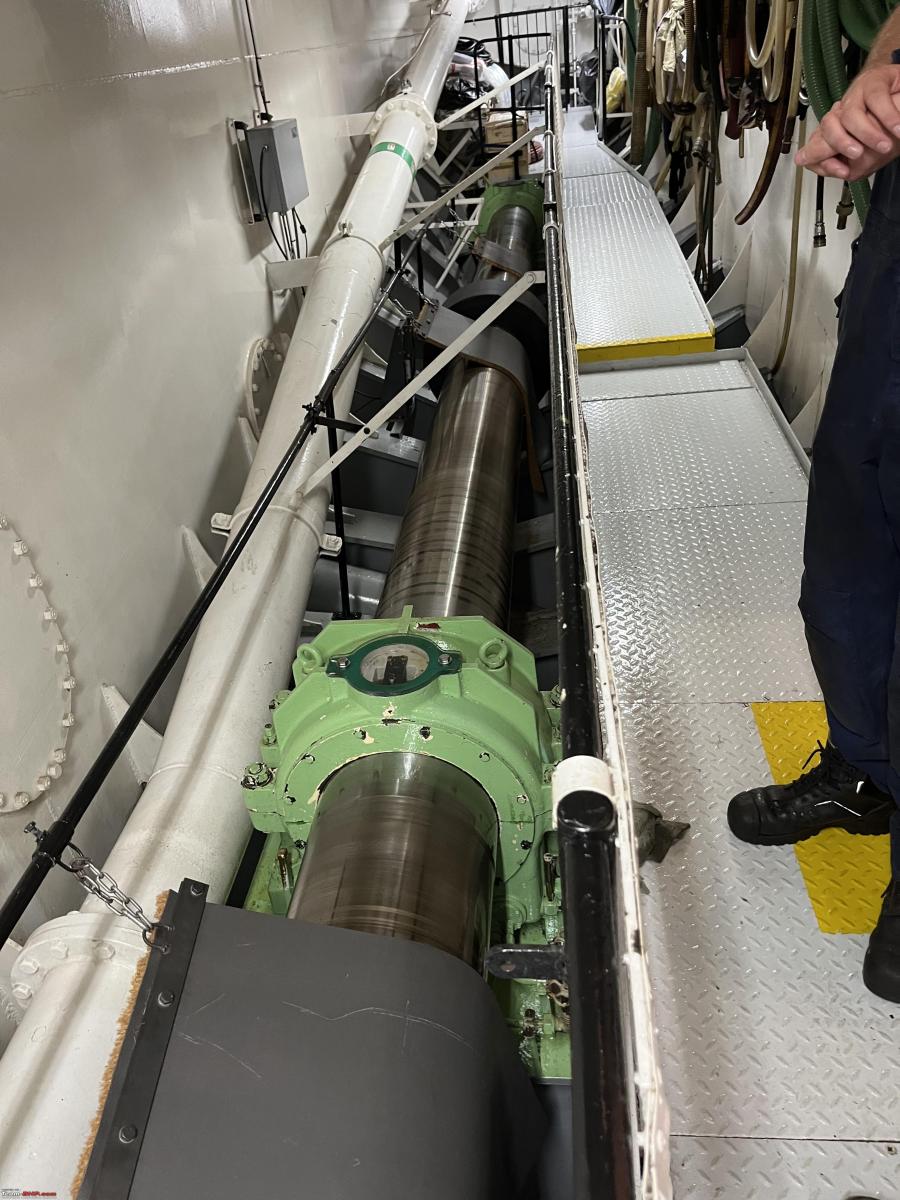
Also, four, again identical, MAN auxiliary diesel engines driving a generator each.
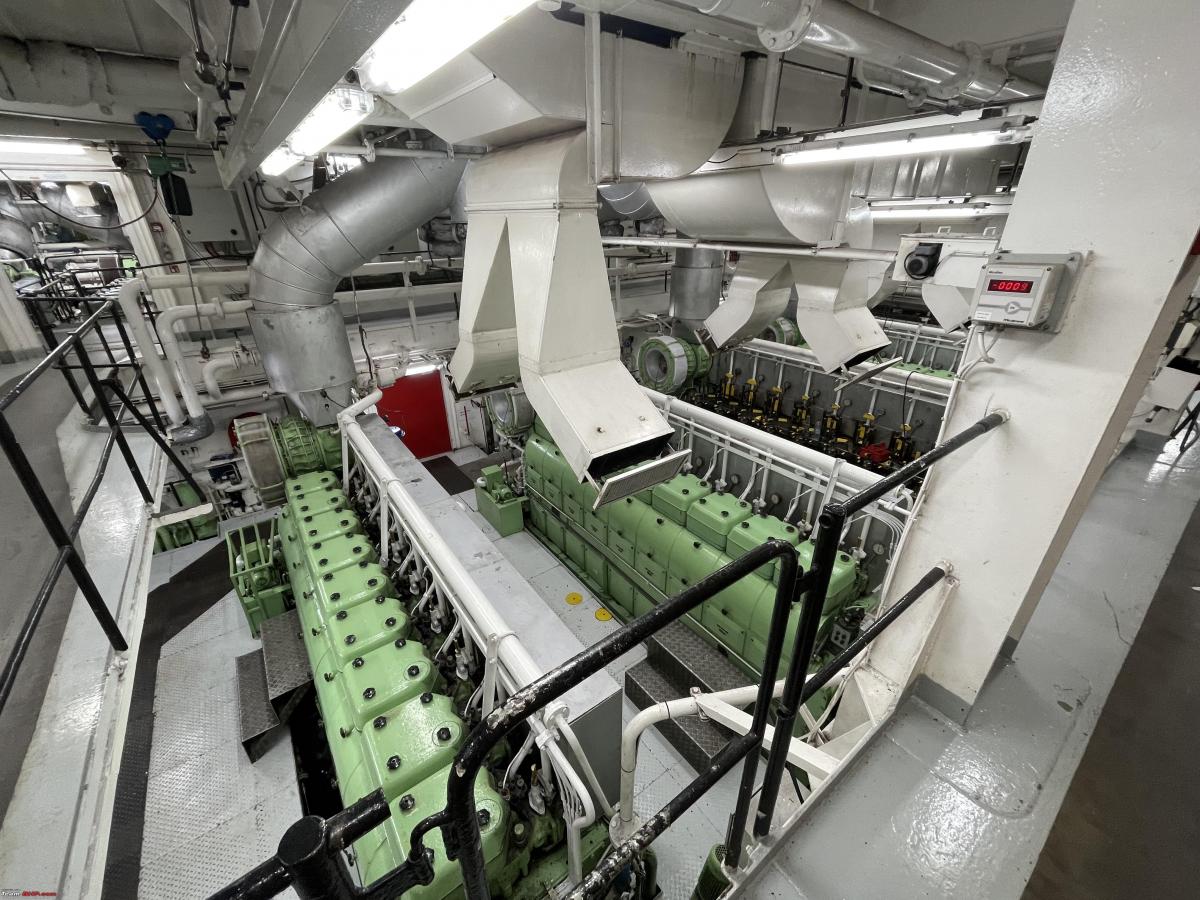
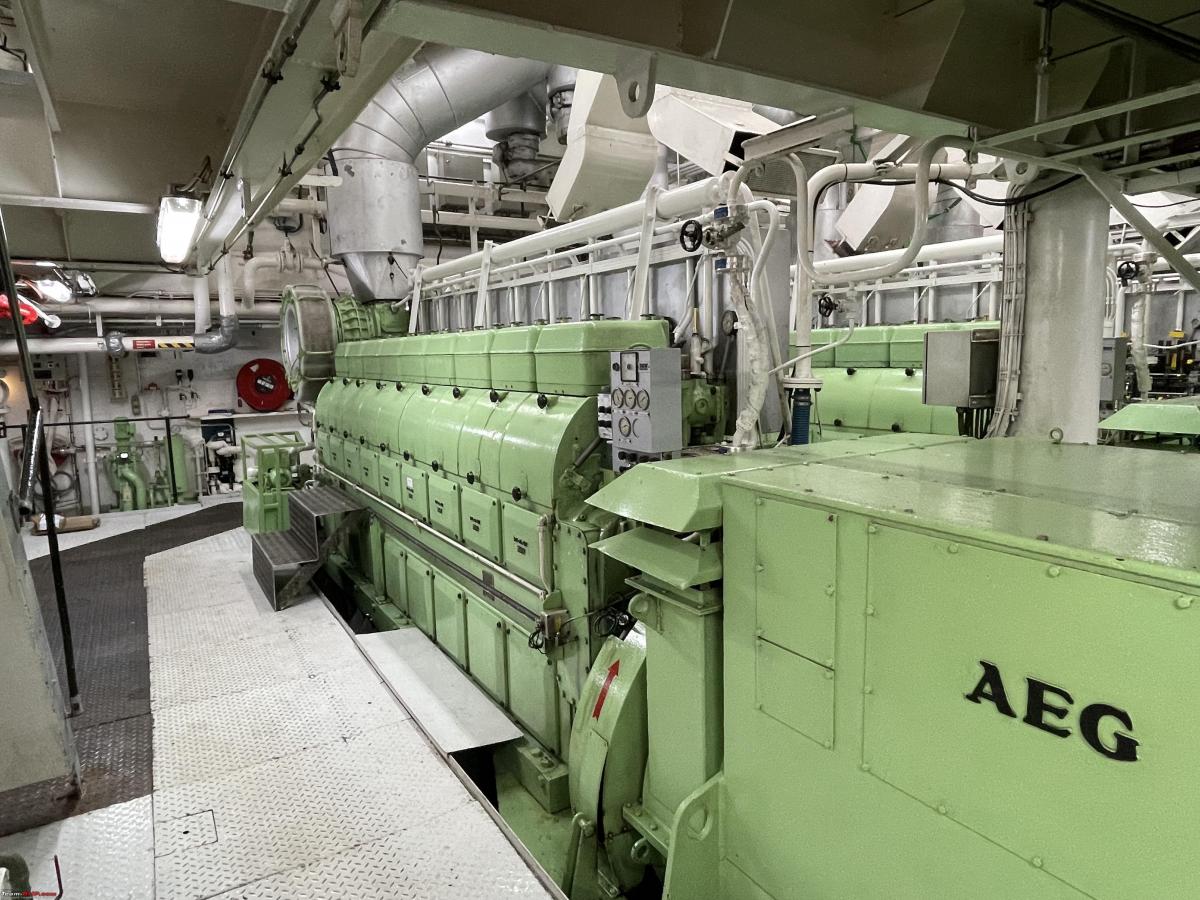
One of the four auxiliary engines was having a major overhaul done. Which means pulling all cylinder heads, cylinder liners, pistons, fuel pumps etc. For these big jobs, a factory team of engineers joins the ship's engineers. They will also bring additional spares. It is not that the engine room team can't do these sorts of jobs. It will just take too long.
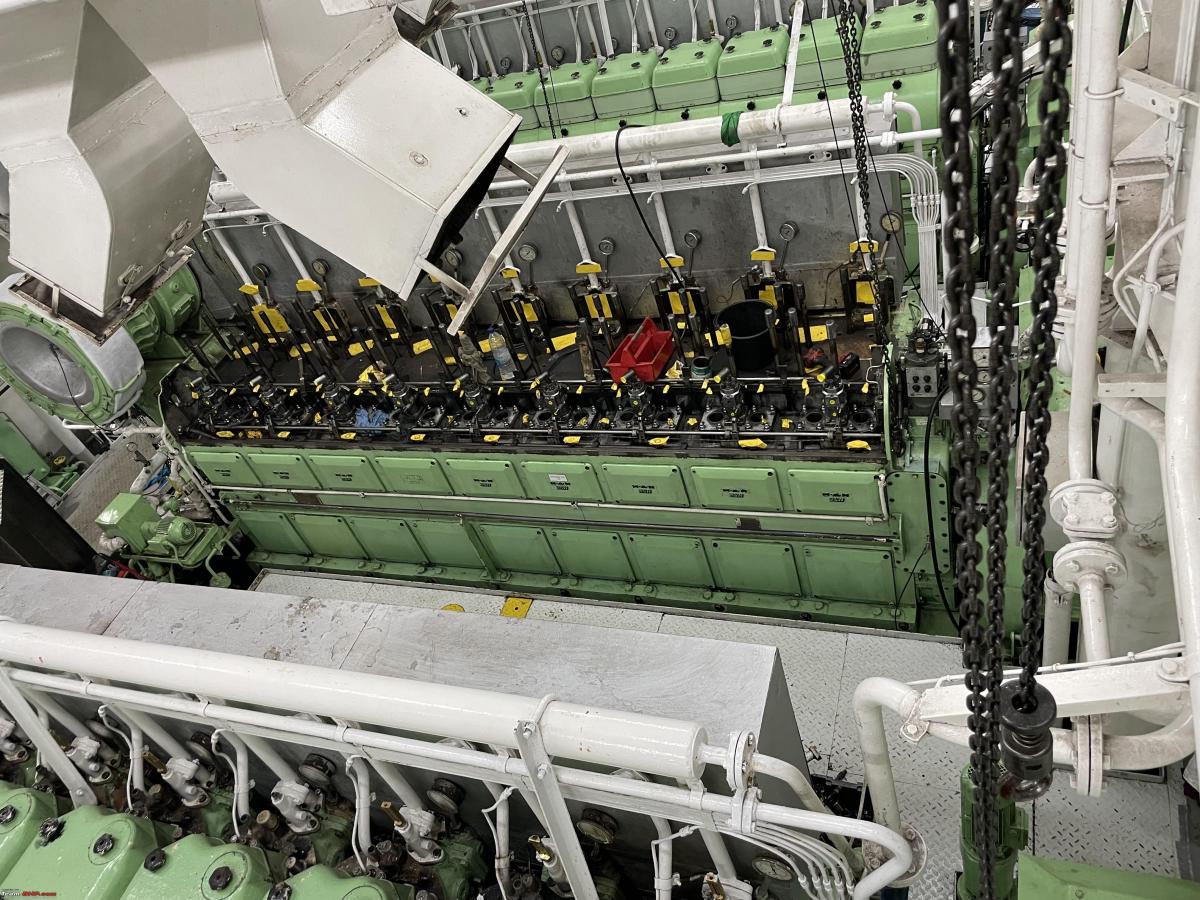
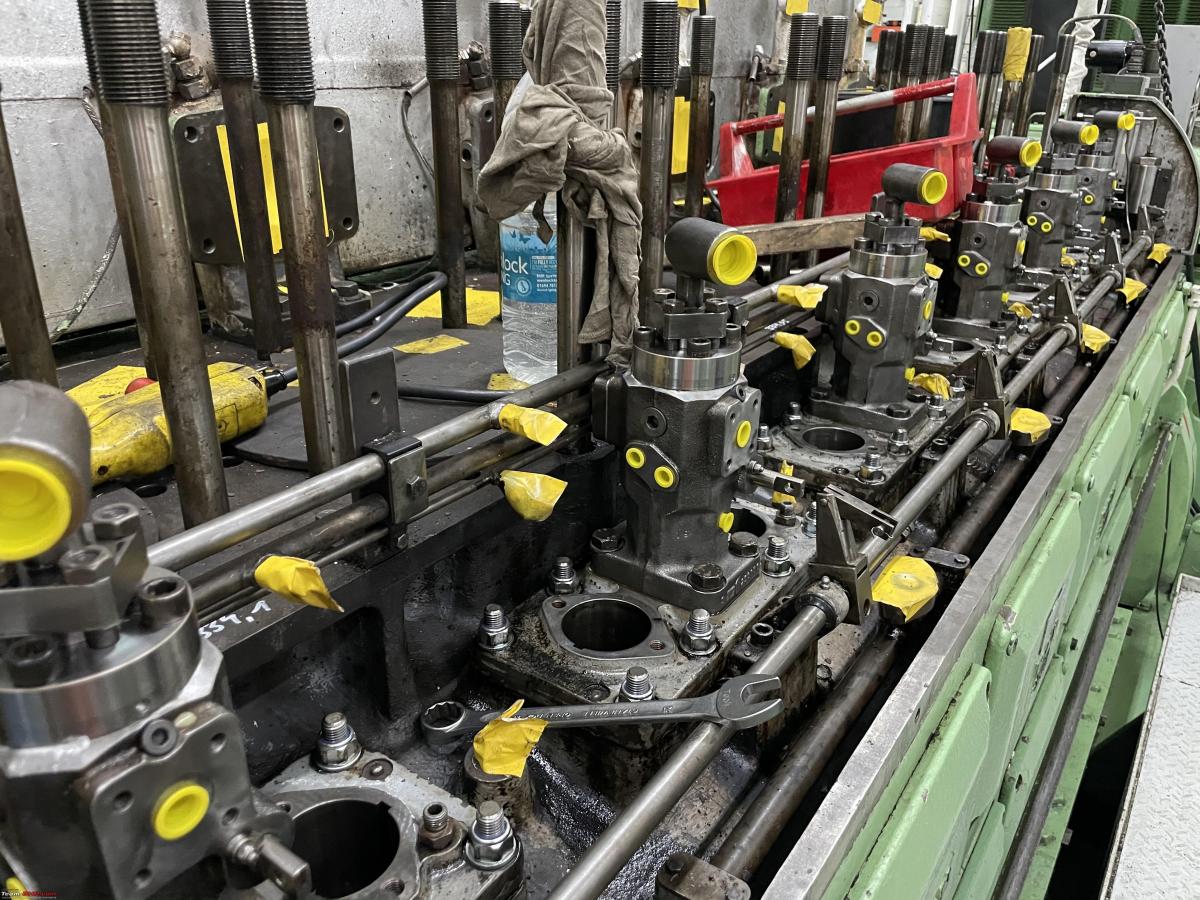
Ships always carry a large amount of spares. There are both insurance and legal requirements on the amount and what kind of spares to have onboard. Here are some cylinder liners and pistons.
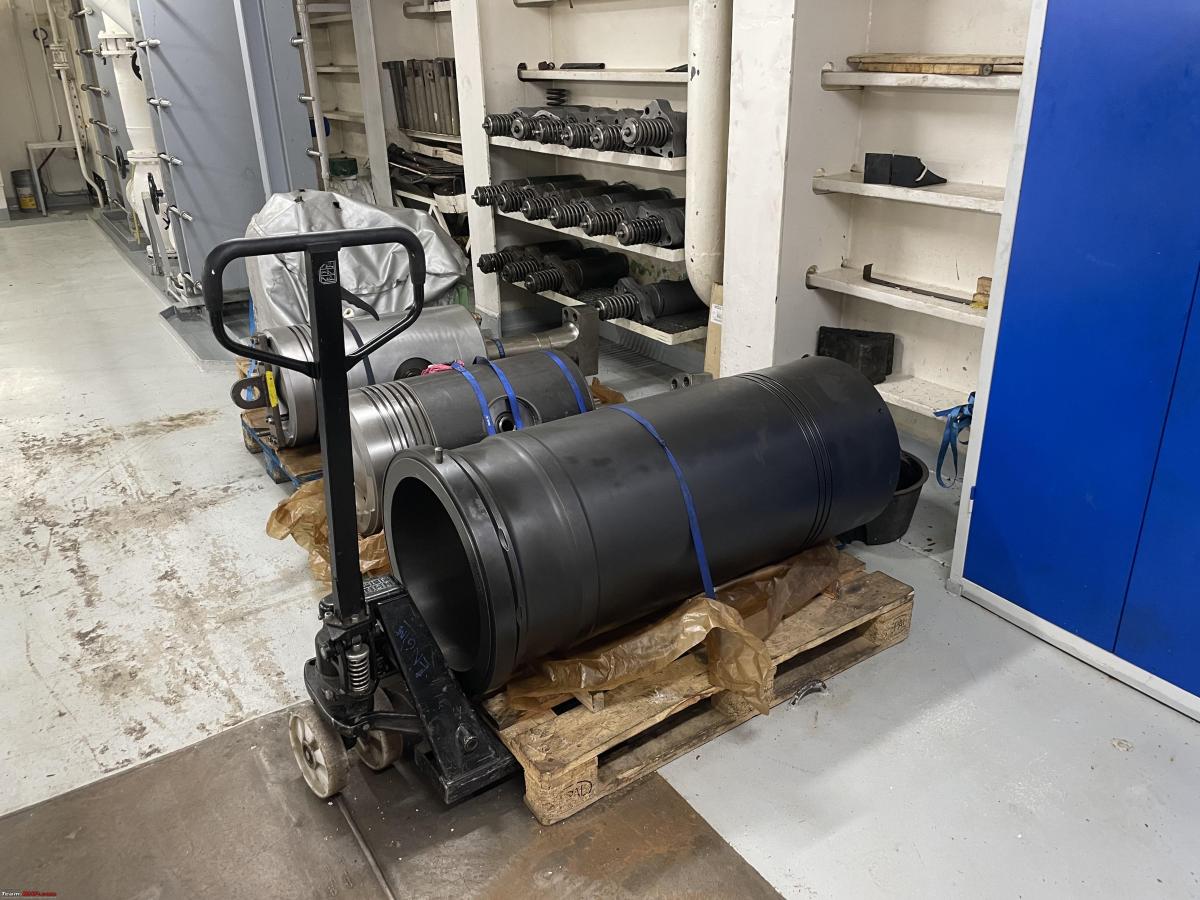
Here we have Peter and yours truly posing next to one of the main engines.
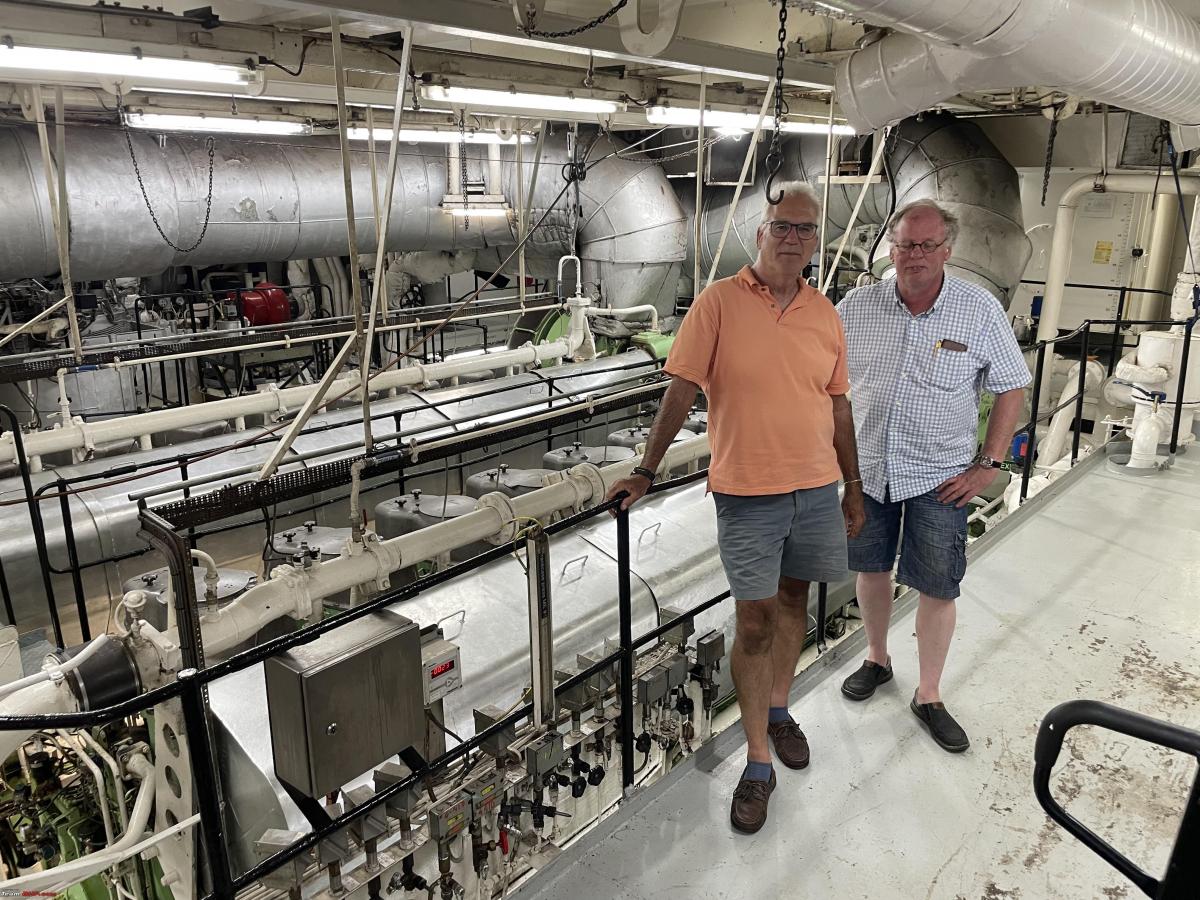
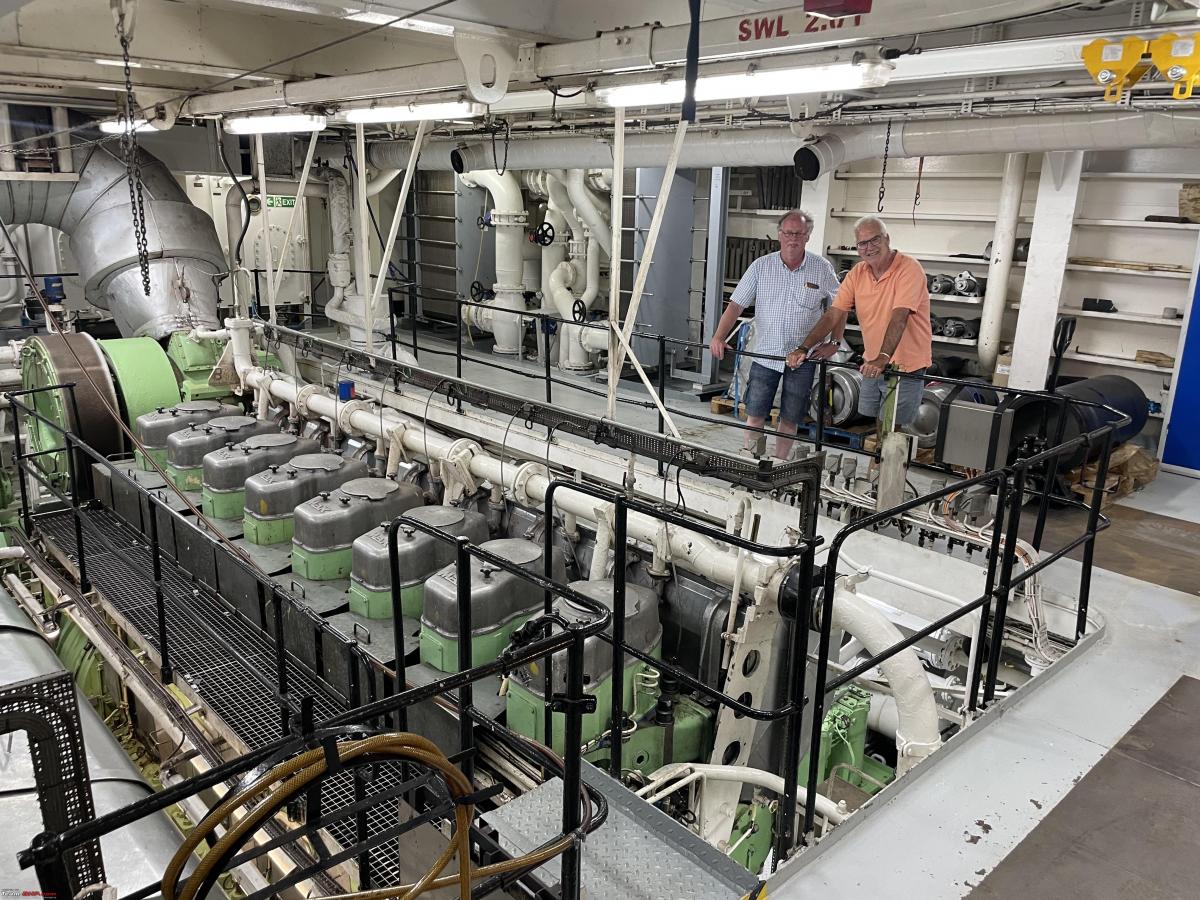
These are the separators. They are for continuous cleaning of lubrication oil and fuel and also remove any water content.

One of the Airconditioning plants
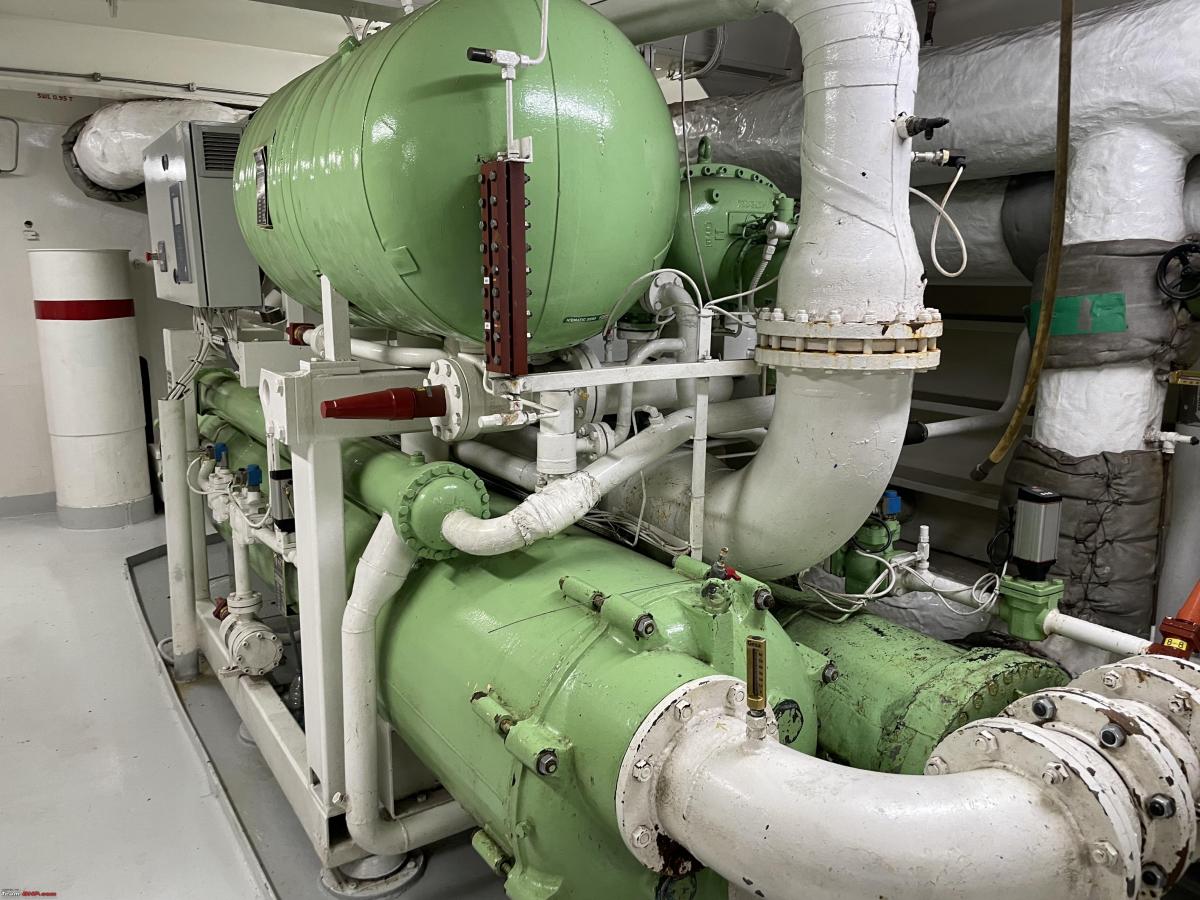
The desalination plant for making all the freshwater onboard.
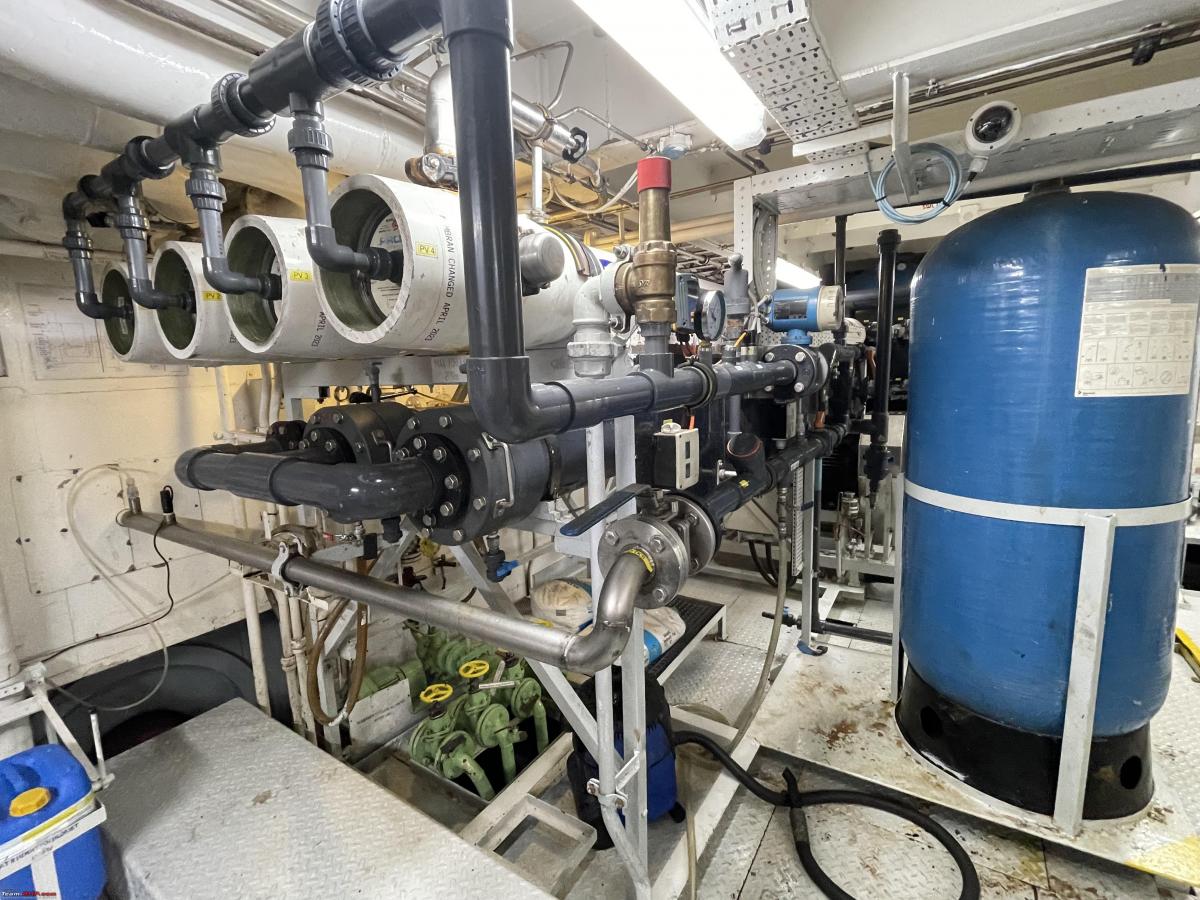
This is one of the fire pumps (the red one). The second engineer told us, that in case of a fire on the car deck, this one will pump water to the sprinkler system. (Good thing we had parked our Spiders with the hood up!)
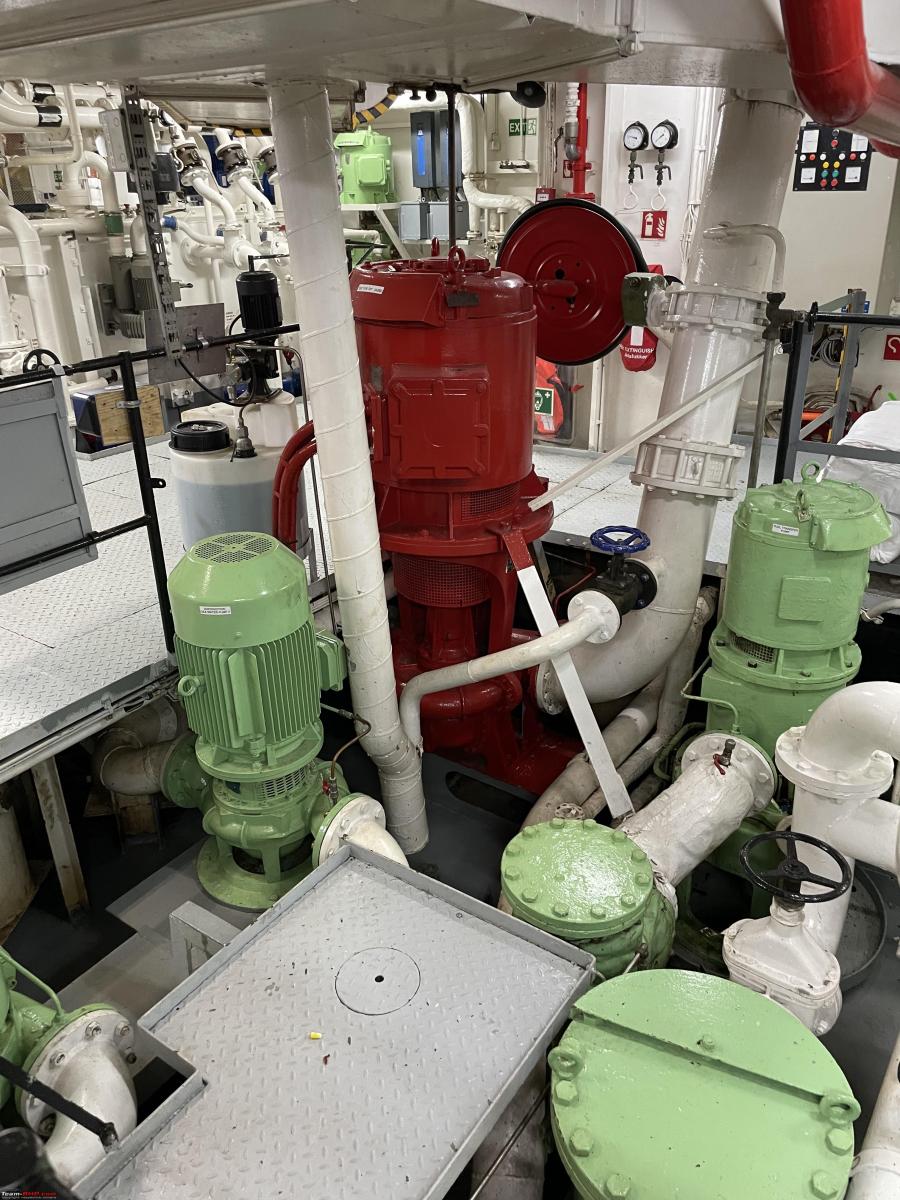
Finally, a very nice, roomy and well-equipped workshop!
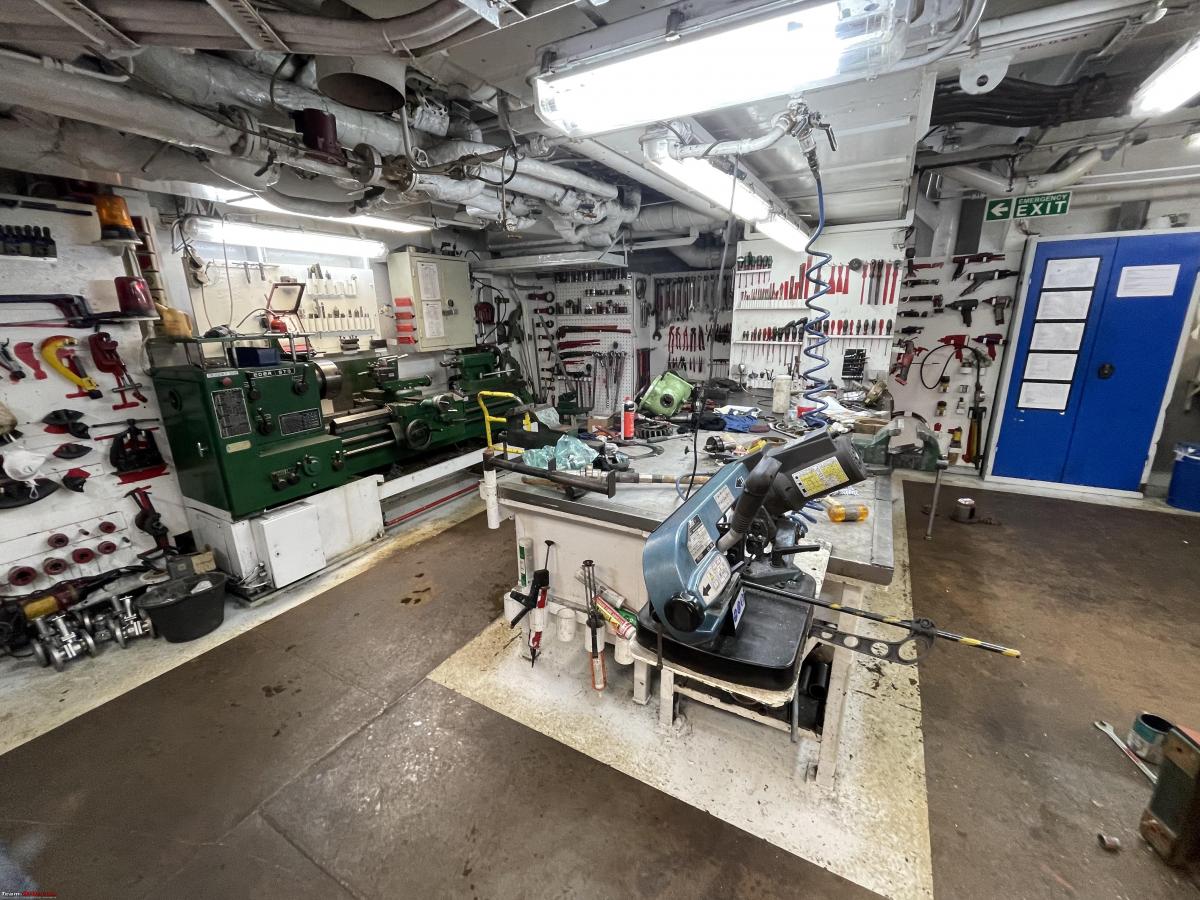
After about an hour we had returned to the control room and talked some more. Many thanks to the DFDS engine room team for showing us around and compliments for a very nicely kept and maintained engine room.
We went back on deck, a very calm sea.

Some years ago the UK did away with the rules for quarantining animals. Up till then, it was simply not possible to take animals with you to the UK. But since this rule has been lifted all ferries have animal kennels on board. Look at this fire hydrant in the dog kennel!
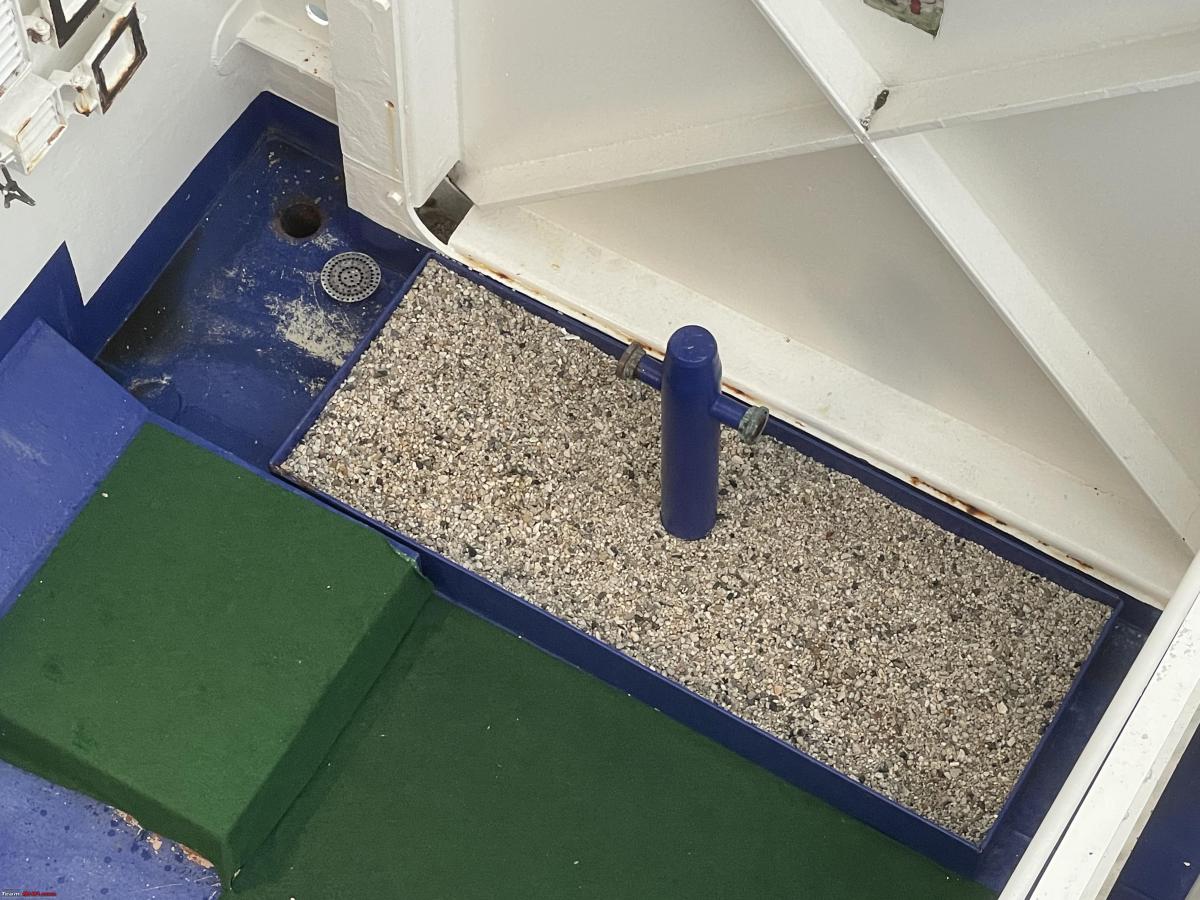
The next morning we had a BIG excellent breakfast. After breakfast, we planned our route for the morning. We usually have a paper map, with sufficient detail (better than 1:30.000) and program our route into our TomToms.
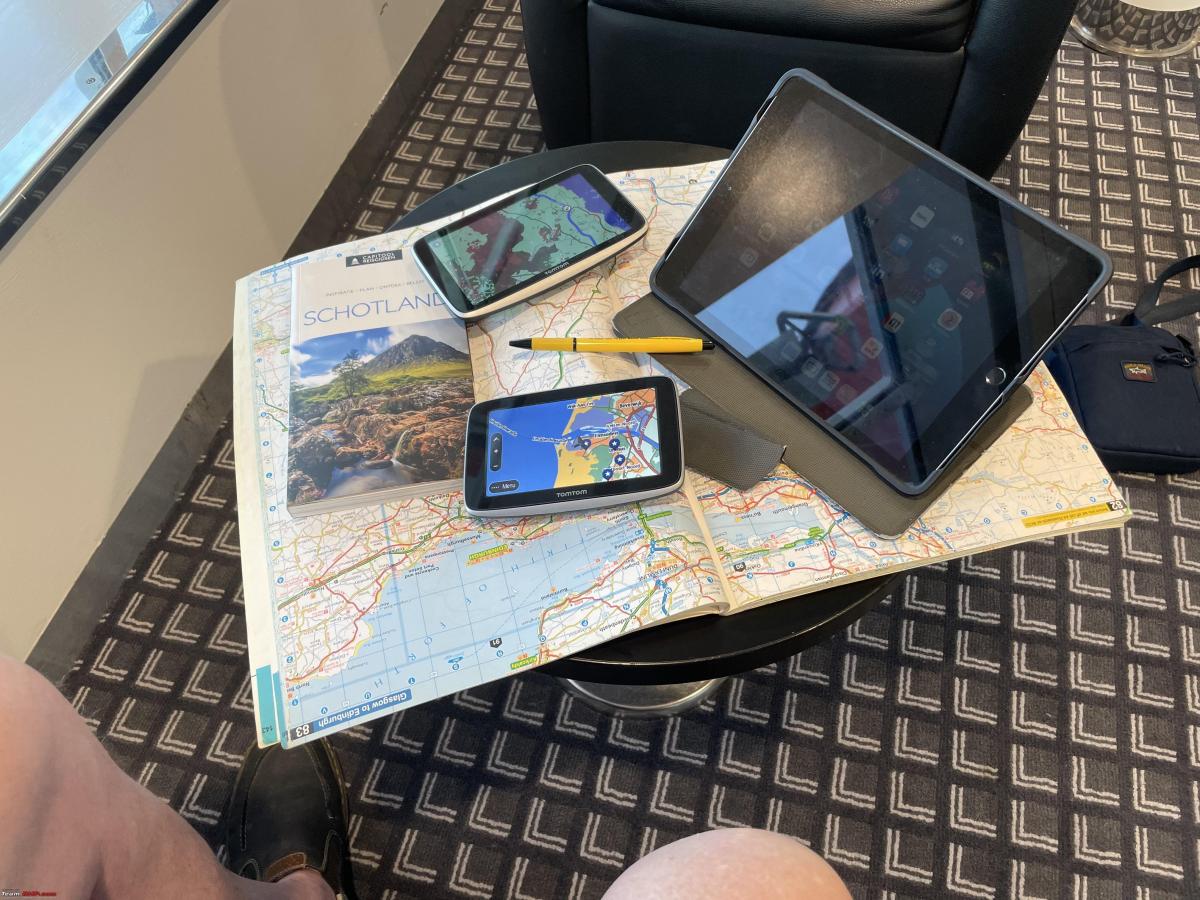
Getting off the ferry was a bit of a problem. The ship has numerous car decks. Deck 3 is the main deck, deck 4 is above deck 3 and there are hydraulically operated ramps for the cars to get from deck 3 up to deck 4. Deck 5 is sort of on the starboard and port side of the ship. Getting onto and off deck 5 needs the ramp of deck 4 up. Just our luck; A German camper got stuck on the ramp of deck 4. Initially, it would not start. So they managed to find a big enough jump-start unit. It started but stalled again. Eventually, they simply raised the ramp with the German camper still on it, so we could drive off the ferry.
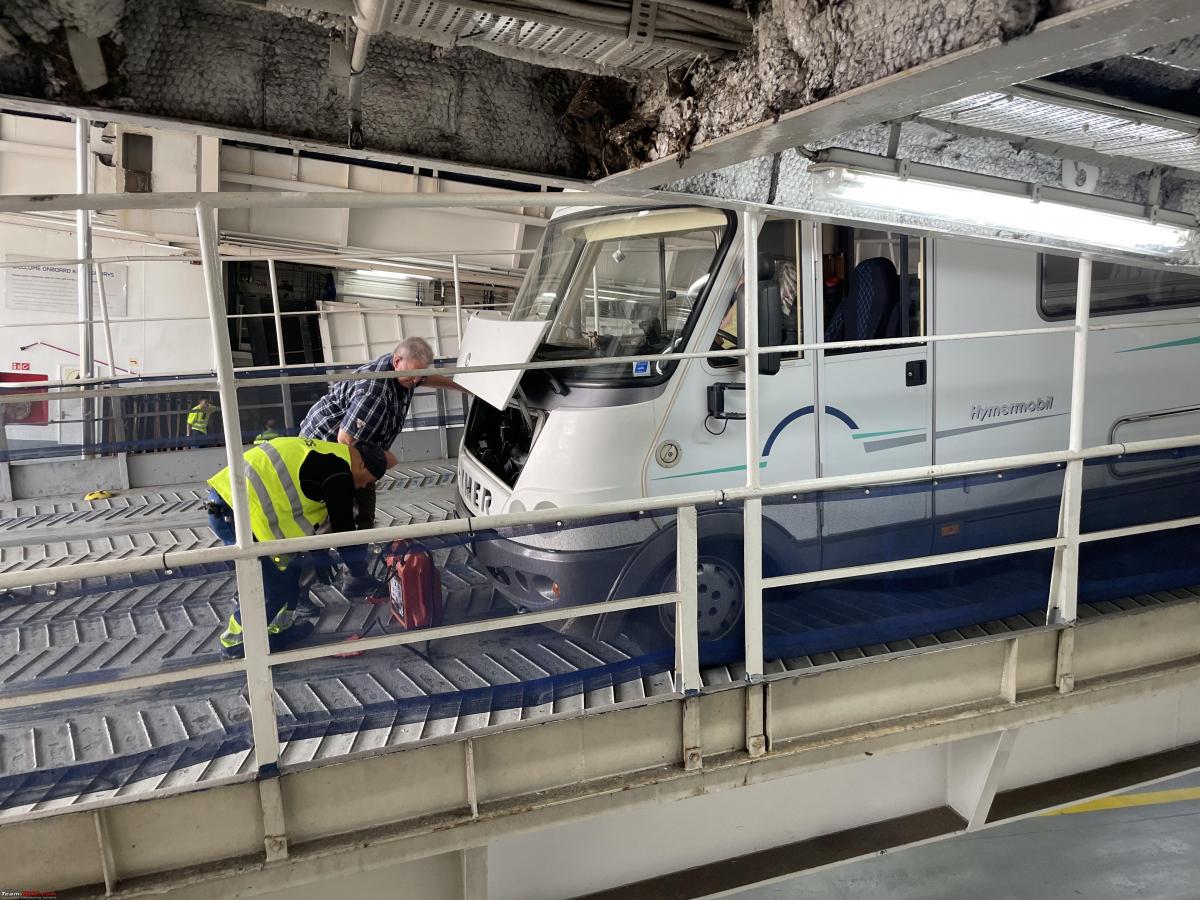
These things can't be helped, but it gave us a delay of almost an hour and a half.
Continue reading about Jeroen's travel experience for BHPian comments, insights and more information.
News
Installing new trailing arms & rubber buffers on my Alfa Romeo Spider
We eventually found out that we also had to loosen the prop shaft to remove the second part of the rubber buffer.
BHPian Jeroen recently shared this with other enthusiasts.
Earlier this week I picked up two exhaust dampers for Peter's Jaguar XJ6. They are tough to source. You can still get them made from stainless steel. But apart from the price, which is quite ridiculous, they also give a very different sound.
Peter eventually found two second-hand ones at a place very near to us. So I drove over to pick them up. This was quite the workshop!! It's owned and run by a guy, probably about my age, with his two sons. They deal only in Jaguars and Jaguar parts. It had a lot of stuff for my Jaguar too.
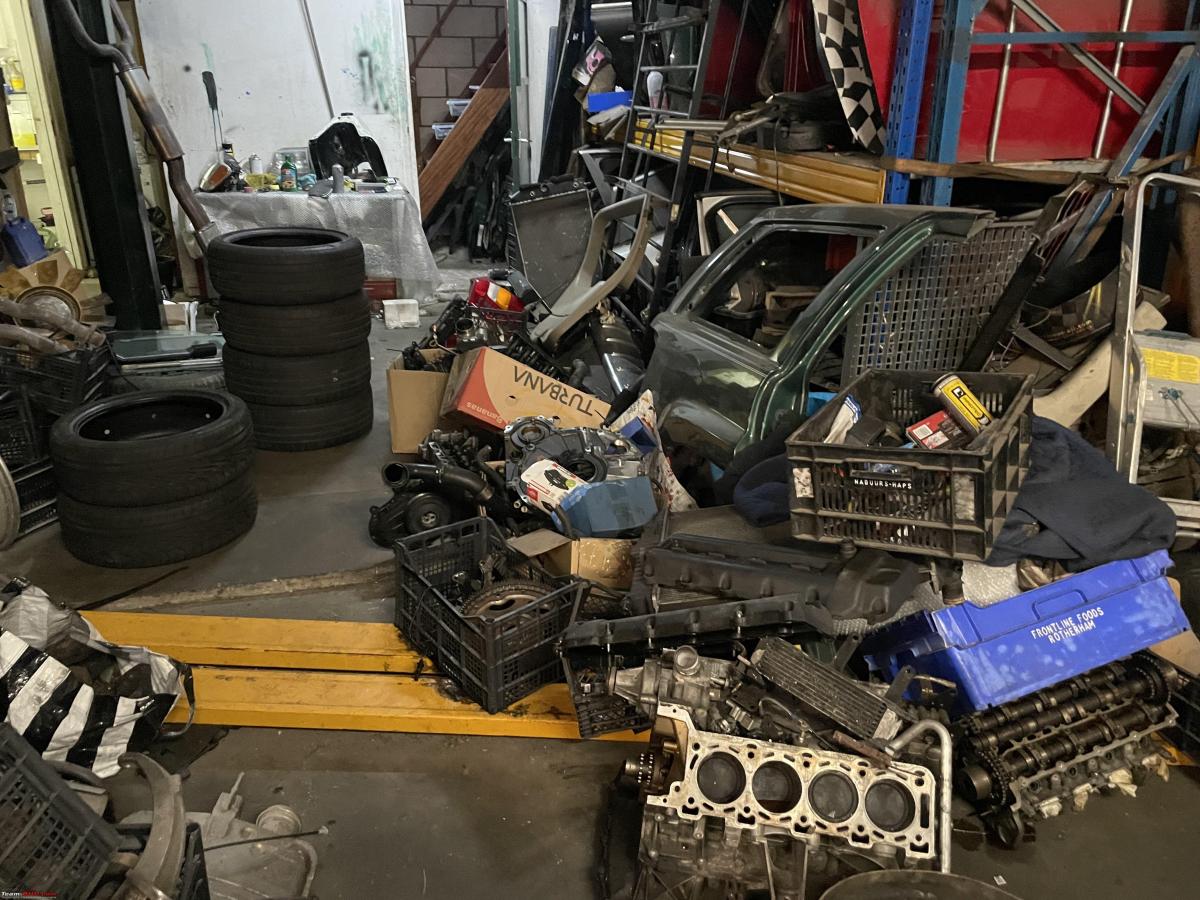
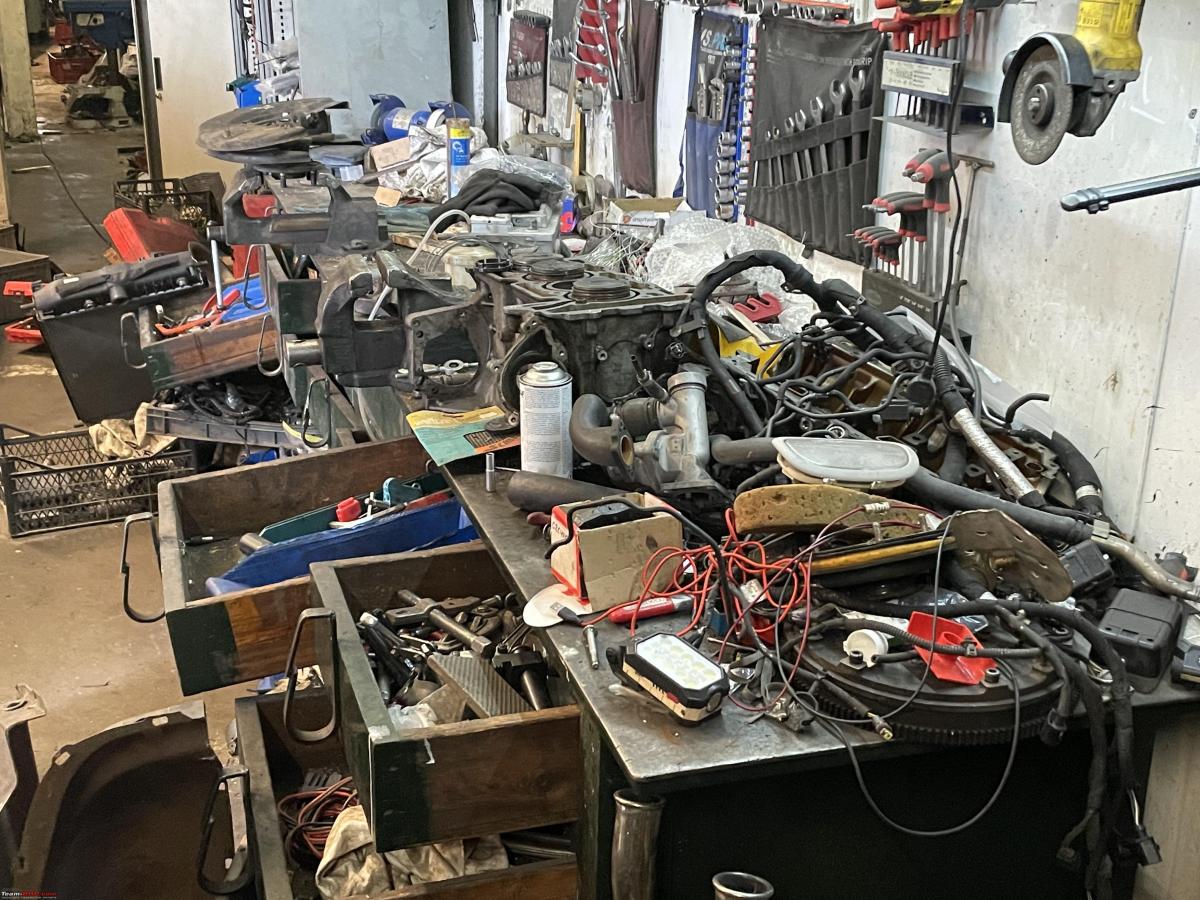

All ready for Peter, including the tools he left last time so I could finish up the Jeep and his change.

A small, but very important, repair job popped up. Our grandson's favourite talking/singing book stopped singing!! Opa to the rescue. The batteries needed replacing, but then it still would not sing! So I took the little electronic music box apart, checked and cleaned it, popped it back in and now it works fine again!
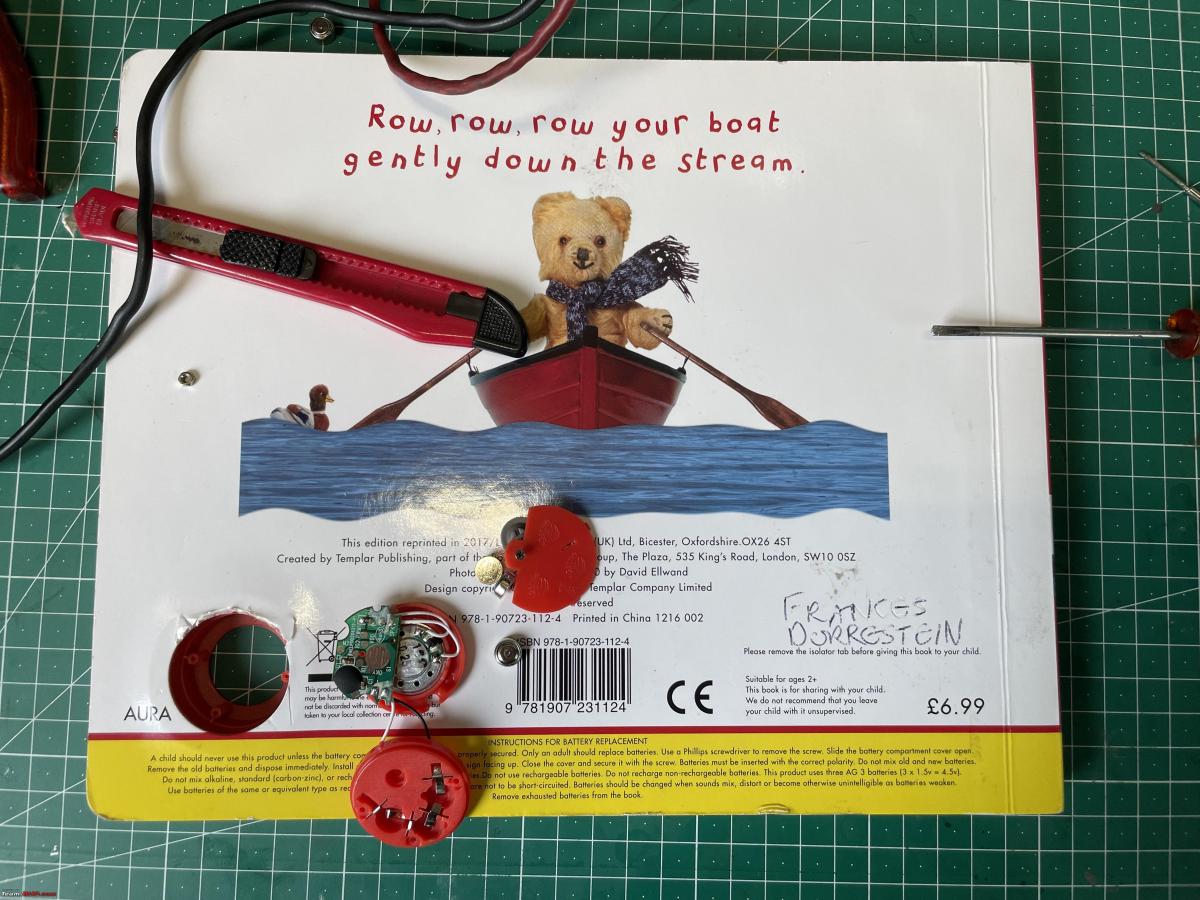
Spanner mate Peter came around yesterday to help me change out the trailing arm and Diabolo rubber on the Spider.
Let's have a look at the rear suspension of this Spider. Pretty rudimentary. A fixed axle/differential. Two trailing arms and a reaction triangle. The reaction triangle is fixed to the chassis on the far sides and the middle holds on the differential using these buffer rubbers. Because these rubbers look like a Diabolo they are commonly referred to as Diabolo rubbers.


Peter and I replaced the trailing arms and the Diabolos on both our Spiders about 25 years ago. Took us the whole afternoon. So we thought we should be able to do better now. Ideally, you need to have the Spider on a lift. Makes a big difference, but I don't have one, so we make do with some improvisations.
Moved the Jaguar out of the way and positioned the Spider so we could easily work and walk around it.

First thing. With two jacks we raise the rear of the Spider quite high and put the chassis on axle stands.
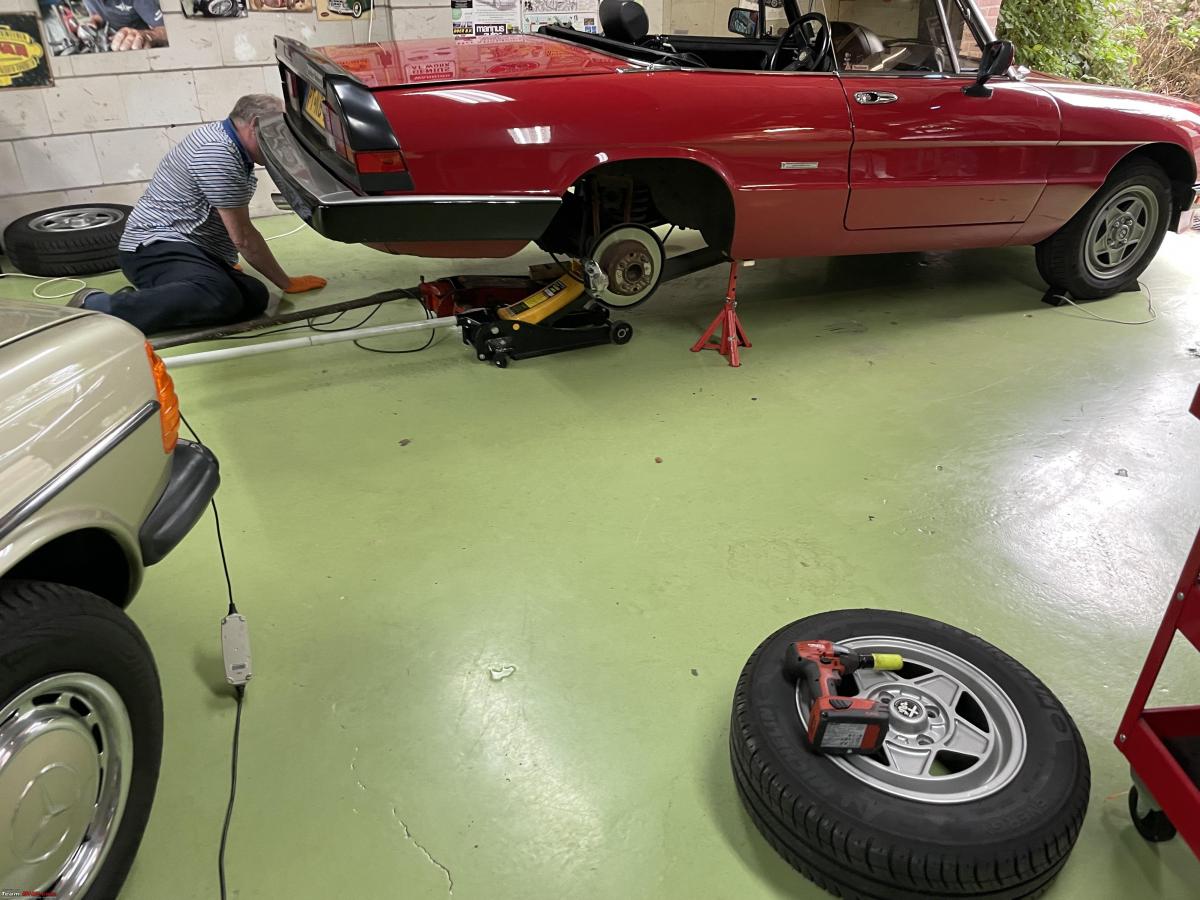
First, we undid the large nut holding the Diabolo in place.

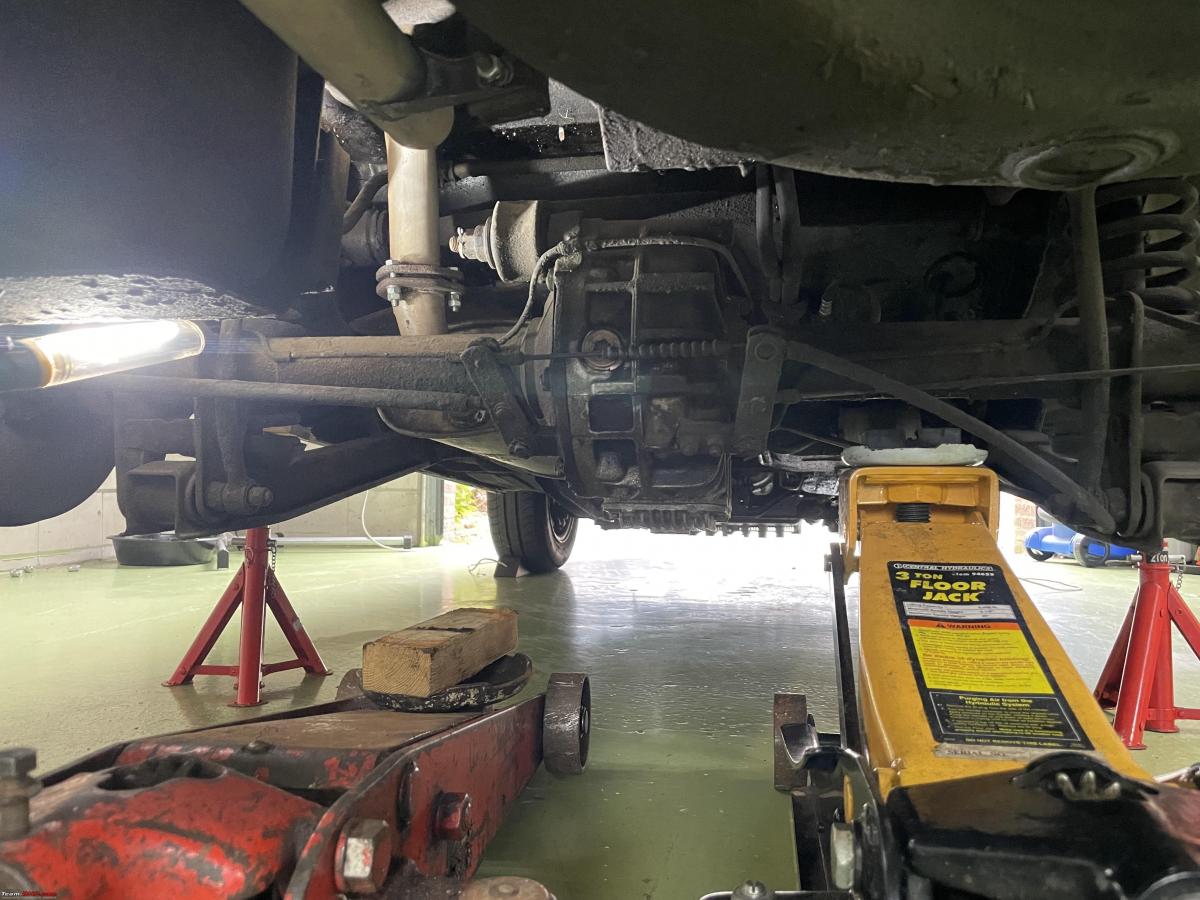
Peter fighting with the cotter pin!

Next, we undid the bolt retaining the shock absorber to the trailing arm.
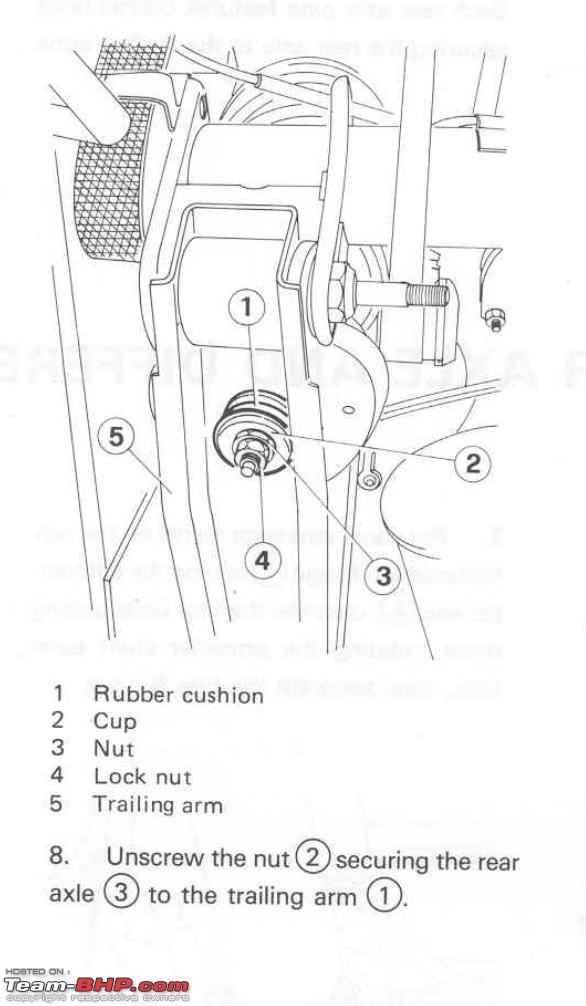
Next, we place a jack underneath the trailing arm (Because it is still compressing the spring!) and undo the large bolt holding it and the stabiliser bar in place.
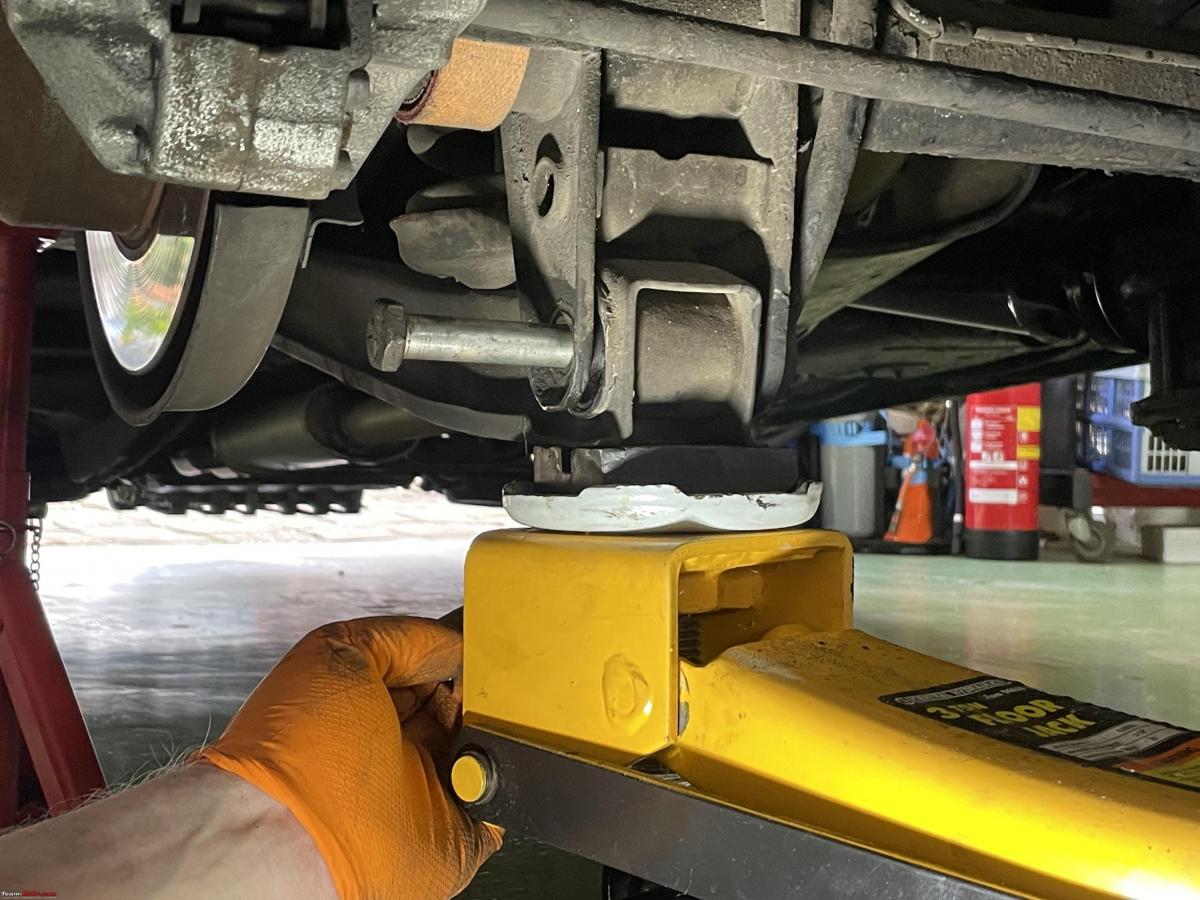
Next lower the jack carefully, so the spring unloads and then remove the forward bolt holding the trailing arm to the chassis.
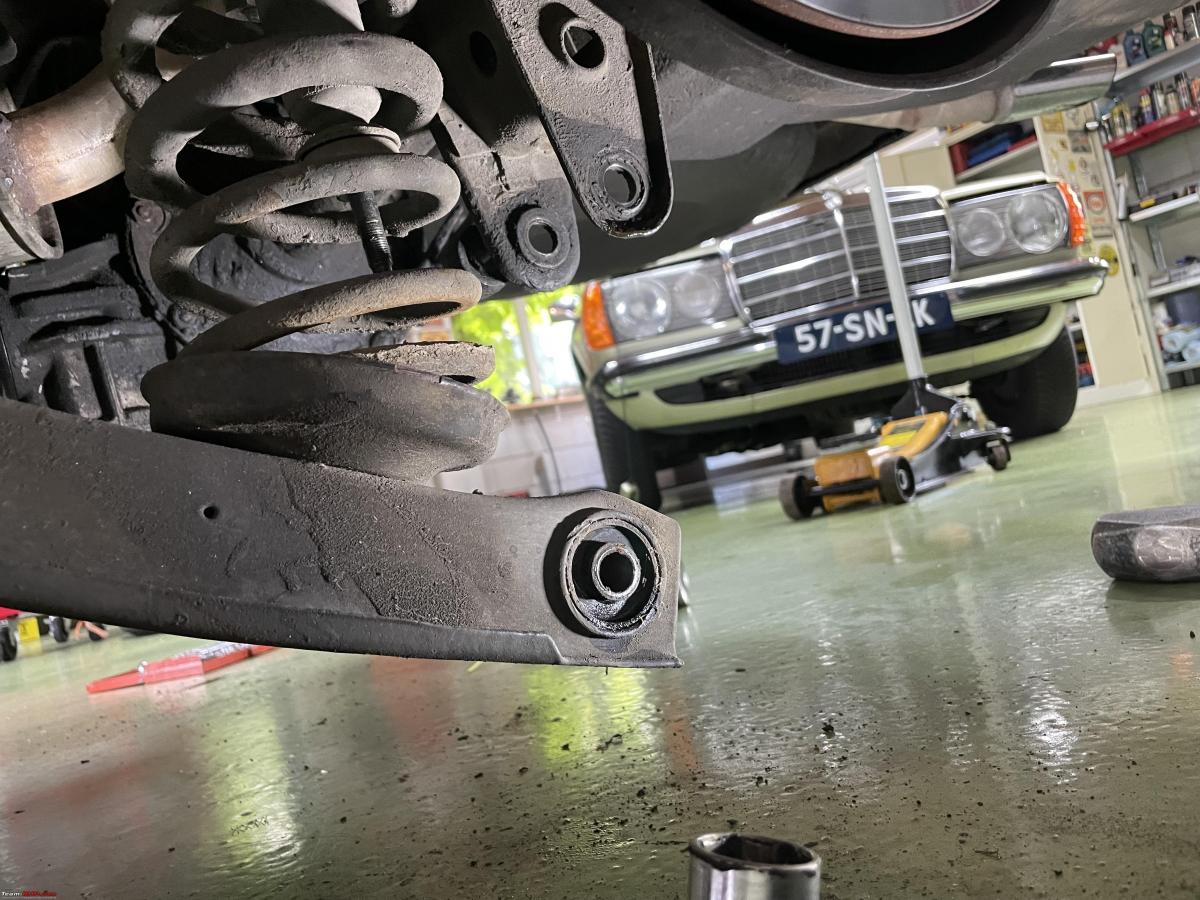
All went pretty smoothly.
With the trailing arm removed, the rear axle and differential hang in the rebound strap. We thought we could just push the whole axle to the right to get the second part of the Diabolo out. We put a jack under the differential for easy manoeuvring, but eventually found we also had to loosen the prop shaft. Always make sure to mark the flanges, because they need to go back together in an identical orientation!!

With the prop shaft disconnected we could easily manipulate the whole rear axle and push it so far to the right we could extract the other Diabolo half.
Here you see that huge bolt on which the diabolos sit held in place the reaction triangle, you see just above.

Peter doing some technical!! At our age, this sort of work is not impossible, but we are not as agile as we used to be. So it does take a bit longer!!

Putting the new trailing arms and the diabolo in is simply a matter of doing all of the above but in reverse order. The trickiest thing is to push the trailing arm back against the spring. We used a few different techniques. You also need to ensure that the spring sits correctly both on the top and bottom parts. It will only fit correctly in one specific orientation.
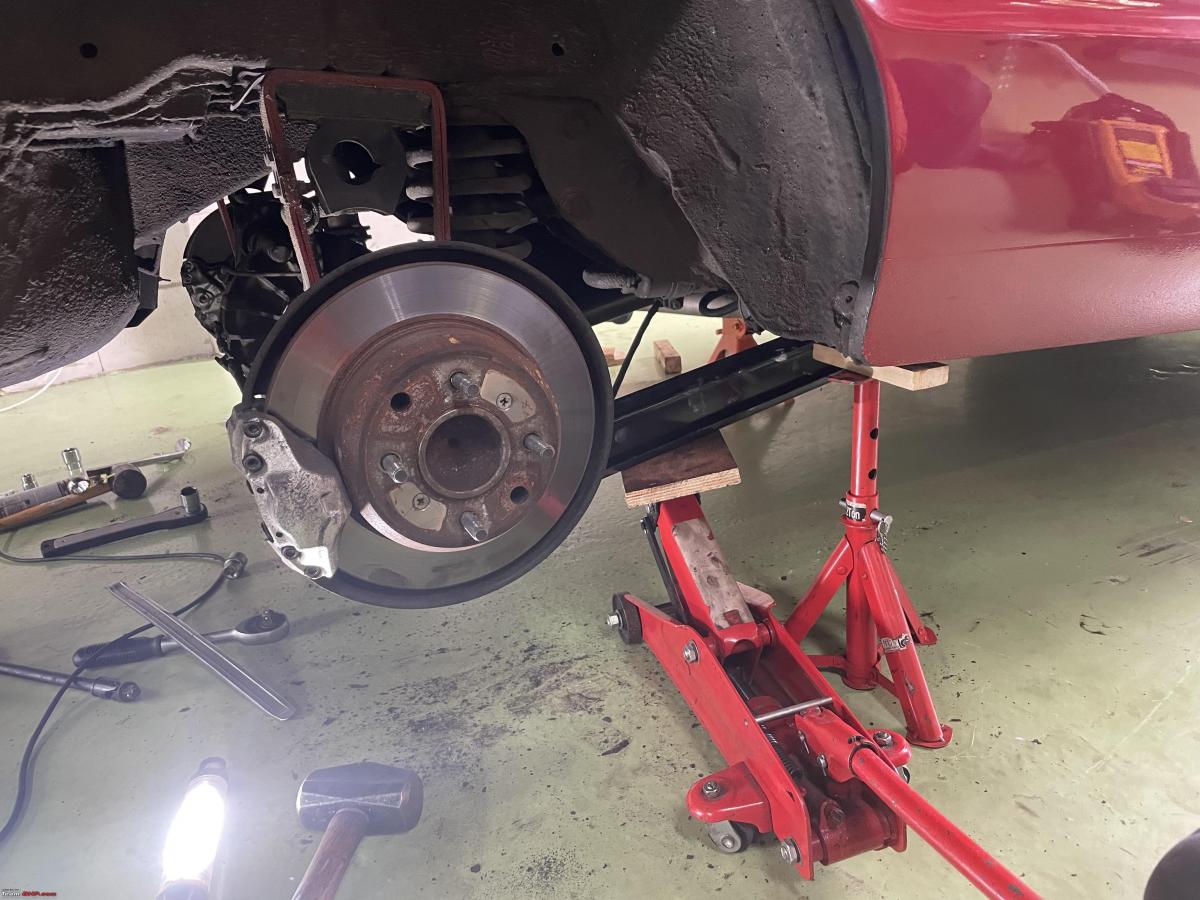
With everything bolted back on we took the Spider for a quick test drive. Handles a bit tighter and less pulling to the right under heavy braking.
It took us about five hours, start to finish, including two coffee and a lunch break. So we consider that pretty good going for two old gits!
As I showed in an earlier post, the parcel shelf was still removed. We listened very carefully, but no whistling from the new vacuum sensor, so that problem is solved as well!
Peter and I spent some more time going through the various tools and parts we will be taking with us.
I received this set of decals for my Jeep. These are all the original decals as could be found on a factory-new Jeep. Mine still has a few, in various states of readability. I came across a guy who sells these on Facebook. Ordered them and they look pretty cool!! I will install them in the coming week.
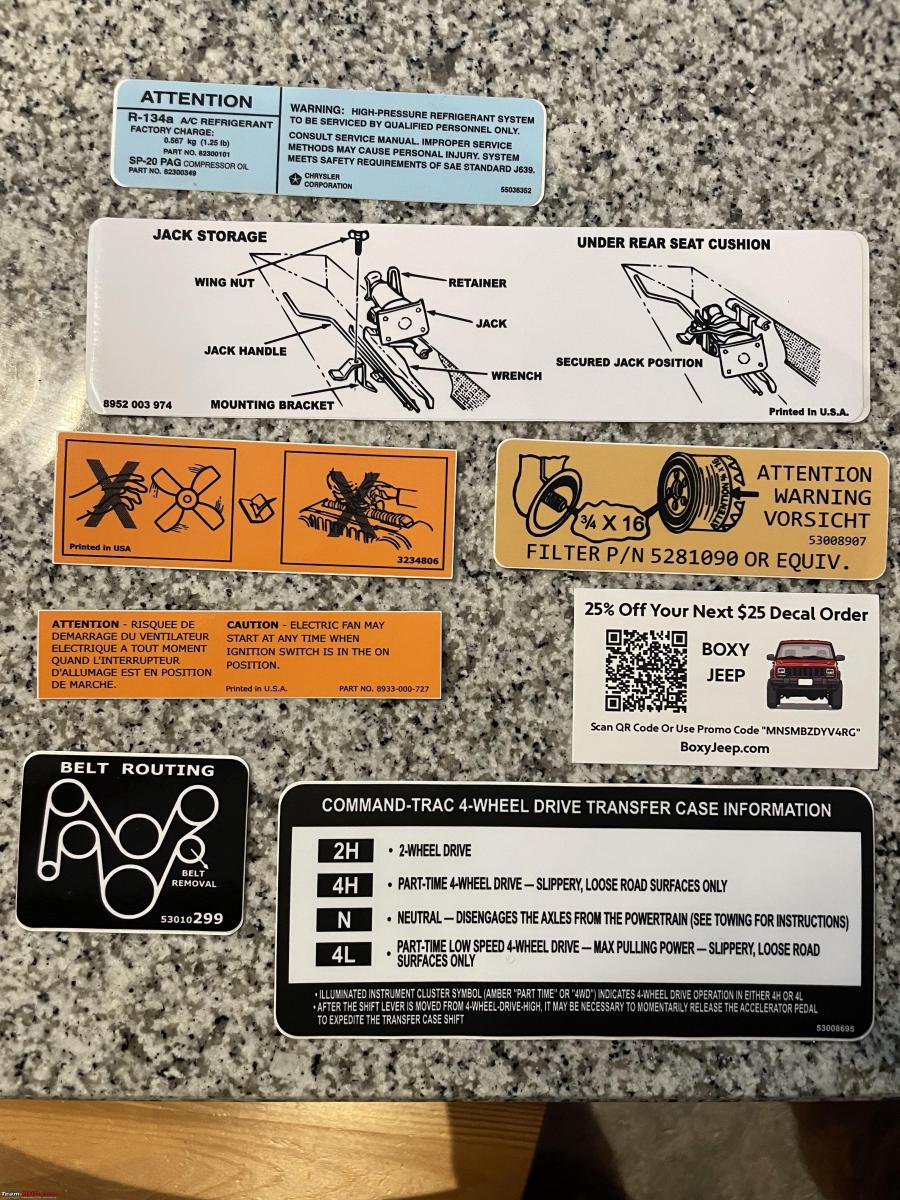
I also picked up this heat gun. I did not have one. This one cost Euro 12 only! Which here in the Netherlands is unbelievably cheap.

This coming week I will start cleaning and preparing the Spider for our Scotland trip!
Check out BHPian comments for more insights and information.
- Tags:
- Indian
- Alfa Romeo
- mechanicals
News
Fiat relaunch & Alfa Romeo's introduction in India: Mixed opinions
One enthusiast says that he will be glad if both brands succeed, whereas another one thinks that Stellantis should instead use its resources to make Jeep & Citroen stronger.
BHPian RedMaw recently shared this with other enthusiasts.
Stellantis weighs Fiat relaunch in India
Stellantis, the world’s third largest carmaker by volume, is considering re-introducing Fiat and a clutch of other marquee brands including the Alfa Romeo into the Indian market even as its immediate priority is to firmly establish Jeep and Citroen brands.
Here's what GTO had to say about the matter:
Stellantis already has two brands in India - the iconic Jeep marque (with some great but old cars) and the newbie Citroen (with some great cars).
Both these brands are struggling & have their own challenges.
Fiat already has a terrible reputation & was taken to the funeral, after 5 long stays in the ICU (once with a big surgeon called Tata). Alfa Romeo is a sexy brand, but investing in another brand isn't wise when you are already struggling with two.
It takes a lot of work to build brands, cars, plan pricing, variants, marketing strategies etc. Renault-Nissan were similarly struggling & brought in Datsun. Management had no bandwidth, the strategies were clean-bowled and the brand was RIP.
IMHO, Stellantis should instead use its resources to make Jeep & Citroen stronger. The luxury car market is anyway tiny in India for anyone other than the 3 - 4 big luxury brands, so why bother?
Jeep Compass Petrol not on sale in a market that's moved to petrols. Diesel AT was delayed, when the market was hot for Diesel ATs. Citroen got its variants & pricing totally wrong and has 3 straight flops (C5, C3, C3 Electric). Please explain to me who has the time for launching yet another brand at Stellantis India.
Here's what BHPian shankar.balan had to say about the matter:
I'll be glad if they succeed. Indeed Fiat is a lovely brand. As is Alfa Romeo. What a great thing it will be if Alfa comes to India. But I do hope they don’t dilute themselves in terms of quality and essential features.
Problem is will they have anything at all for the mass market which ultimately drives everyone’s bread and butter?
Here's what BHPian ron178 had to say about the matter:
They have some very nice affordable cars like the Cronos and Pulse, but those are native Fiat platforms. I suspect they would want to launch new Fiat products for India and Brazil/Argentina based on the CMP platform and those will inevitably be stripped down - speaking of which - shouldn't they focus on fixing Citroën and Jeep before dipping their toes elsewhere?
Here's what BHPian androdev had to say about the matter:
When Toyota and Maruti Suzuki can operate with such close cooperation and synergy, why can't the brands owned by Stallantis operate as one group? It's pretty stupid not to combine Jeep, Citroën, FIAT, etc. under one roof so that they can have a much better network and diverse portfolio of cars - will give the buyers so much more choice and confidence.
Here's what BHPian Jeroen had to say about the matter:
I am not sure Alfa Romeo and India are a likely successful partnership. Alfa Romeo tried several times to break into the US market and always failed miserably for a variety of reasons.
I don’t understand the Fiat/Alfa Romeo strategy at all. They have hardly any cars, nothing really new in the pipeline and are struggling in their home markets in Europe.
To think you can capture market share in India with a tiny line up of cars made in Europe is simply utterly naive. Many Western companies have found out that although the Indian market, whatever you want to sell, is potentially huge, making actual money in India is not for the faint of heart!
Alfa Romeo's after-sales service in Europe is almost non-existent. Dealers have no parts in stock even for brand new cars. That is, if you can find a dealer in the first place.
Remarkably, Alfa Romeo has a very loyal fanbase. Truth be told, most of them drive second-hand Alfa’s. In Europe, there is a thriving second-hand market for Alfas including many excellent workshops that specialise in Alfas. They also have access to a by and large pretty good aftermarket spare parts circuit.
As long as you don’t need to rely on the official AR dealer you are good. Although the newer AR are pretty reliable, I have my doubt about how they would hold out in a market such as India. They are pretty cars. And as with most pretty things in life, it likely means they are finicky and high maintenance!
Yes, both Fiat and Alfa Romeo do make nice cars. Not many, but at least they do stand out from the crowd!
Check out BHPian comments for more insights and information.
- Tags:
- Indian
- Fiat
- Alfa Romeo
- Stellantis
Pages













